Mar 16, 2024

How to build a website like Expedia
Expedia is a comprehensive online travel platform offering hotel bookings, flights, car rentals, and vacation packages. Discover the steps to create a marketplace akin to Expedia.
Introduction: Why build a website like Expedia
Expedia's success as an online marketplace can be attributed to its comprehensive and user-friendly platform that caters to a wide range of travel needs, including hotel bookings, flights, car rentals, and vacation packages. Since its inception in 1996, Expedia has leveraged technology to simplify the travel booking process, making it accessible and convenient for users worldwide. By aggregating a vast array of travel options from various suppliers, Expedia offers competitive prices and a plethora of choices, enabling customers to tailor their travel plans according to their preferences and budget. The company's success is further bolstered by its robust customer service, intuitive website and mobile app interface, and innovative features such as virtual tours and flexible cancellation policies. Additionally, Expedia's strategic partnerships and acquisitions have expanded its global footprint and diversified its offerings, reinforcing its position as a leading online travel agency in the competitive travel industry.
How does a website like Expedia work?
For buyers, Expedia simplifies travel planning by aggregating a vast array of options for flights, hotels, car rentals, and activities in one platform. Users can easily compare prices, amenities, and locations to find deals that best suit their needs and preferences, making it a convenient, one-stop-shop for all travel arrangements.
For sellers, Expedia operates as a powerful platform to reach a vast audience of travelers. By listing their services, such as hotel rooms, flights, and car rentals, sellers gain exposure and bookings they might not otherwise achieve. Expedia simplifies the connection between sellers and potential customers, handling transactions and providing marketing support.
What is Expedia's business model?
Expedia operates as an online travel agency (OTA), a business model that serves as a digital marketplace connecting consumers with travel services, including hotel reservations, flights, car rentals, and vacation packages. The company aggregates travel options from various service providers, allowing users to compare prices and book services directly through its website or mobile app. Expedia generates revenue primarily through commissions and fees from these bookings, leveraging agreements with hotels, airlines, and other travel service companies. Additionally, it earns from advertising on its platform and through the sale of value-added services such as travel insurance and activity bookings. This model capitalizes on the convenience and efficiency of online booking, offering a one-stop-shop solution for travelers seeking to plan and book their trips in a streamlined and cost-effective manner.
Expedia, a leading online travel agency (OTA), generates revenue through various streams, primarily by acting as an intermediary between consumers and service providers in the travel industry. When travelers book flights, hotels, car rentals, or vacation packages through Expedia's platform, the company earns money in several ways. One of the primary methods is through commissions received from these service providers for each booking made via its website or app. Additionally, Expedia profits from the merchant model, where it purchases rooms from hotels in bulk at discounted rates and sells them at a markup. The company also offers advertising opportunities to travel-related businesses, allowing them to promote their services on Expedia's extensive network of websites. Furthermore, Expedia charges service fees for certain transactions, such as changes to airline tickets, adding another layer to its revenue model. Through these diverse income streams, Expedia has established itself as a robust player in the online travel booking sector, catering to a wide range of travel needs while generating significant revenue.
Key features of Expedia
The most important functionality of a marketplace like Expedia is to aggregate and compare travel-related services from a wide range of providers to offer users a comprehensive platform for planning and booking their trips. This includes:
Comprehensive Search and Filtering: Users can search for flights, hotels, car rentals, and vacation packages based on their preferences, such as dates, destinations, budget, and specific requirements. The ability to filter and sort these options based on various criteria (e.g., price, duration, ratings) is crucial for helping users find the best deals and options that suit their needs.
Booking and Reservation Services: Once users have selected their preferred travel options, the platform must facilitate a smooth and secure booking process. This includes collecting user information, processing payments, and confirming reservations with the service providers.
Price Comparison and Deals: One of the key value propositions of a marketplace like Expedia is its ability to compare prices across different providers, ensuring users get the best possible deals. The platform often negotiates special rates with service providers or offers exclusive deals to its users.
User Reviews and Ratings: Providing access to reviews and ratings from other travelers helps users make informed decisions about hotels, flights, and other services. This transparency is crucial for building trust and guiding users to quality experiences.
Customer Support and Service: Offering robust customer support before, during, and after the booking process is essential. This includes handling inquiries, changes to reservations, cancellations, and dealing with any issues that may arise during travel.
Personalization and Recommendations: To enhance the user experience, Expedia and similar platforms often use data analytics and machine learning to offer personalized recommendations based on users' past searches, bookings, and preferences. This can include suggesting destinations, travel deals, or additional services they might be interested in.
Mobile Accessibility: Given the prevalence of smartphones, having a user-friendly mobile app or a mobile-optimized website is crucial. This allows users to search, book, and manage their travel plans on the go.
In summary, the most important functionality of a marketplace like Expedia lies in its ability to offer a one-stop solution for travel planning and booking, providing convenience, variety, competitive pricing, and support to its users.
Launching a platform such as Expedia from scratch involves a significant investment, both in terms of time and finances. The costs can range widely, starting from $100,000 to over $1 million, depending on the complexity, features, and scale you aim for. This estimate includes expenses for research, design, development, testing, marketing, and ongoing maintenance. Key functionalities like real-time booking, secure payment gateways, customer support, and an intuitive user interface are essential. Additionally, integrating APIs for hotels, flights, and car rentals adds to the complexity and cost. Achieving a seamless user experience and robust backend infrastructure are pivotal, which requires hiring experienced developers and possibly a dedicated team for continuous updates and support.
How to create a successful alternative to Expedia
Identify gaps in the current market that Expedia and similar platforms may not fully address. Conduct thorough market research to understand the needs and preferences of various traveler demographics. Develop a unique value proposition that sets your platform apart from Expedia, focusing on areas like pricing, customer service, or niche markets. Create a user-friendly website and mobile app with an intuitive interface and seamless booking experience. Incorporate advanced search filters and AI-driven recommendations to help users find the best deals tailored to their preferences. Offer competitive pricing and exclusive deals by establishing strong partnerships with airlines, hotels, and other travel service providers. Implement a robust customer support system that provides quick and helpful responses to inquiries and issues. Introduce a flexible cancellation policy and loyalty program to encourage repeat business and customer loyalty. Invest in a strong marketing campaign that highlights your platform's unique features and benefits, targeting both digital and traditional media channels. Leverage social media and influencer partnerships to increase brand visibility and credibility among younger travelers. Ensure your platform includes comprehensive travel guides and resources to assist travelers in planning their trips. Regularly gather user feedback and use it to make continuous improvements to your service offerings and user experience. Stay adaptable and be ready to evolve your business model in response to changing travel trends and consumer behaviors. Prioritize data security and privacy to build trust with your users. Consider sustainability and eco-friendly travel options to appeal to environmentally conscious consumers.
Successful Expedia competitors
Booking.com is one of Expedia's fiercest competitors in the online travel booking space. Unlike Expedia, which offers a wide range of services including flights, hotels, car rentals, and cruises, Booking.com has traditionally focused more on accommodations, offering a vast selection of hotels, apartments, and unique places to stay. However, both platforms have expanded their offerings to include various travel services, making them direct competitors in providing a comprehensive travel booking experience.
Airbnb has emerged as a significant competitor to Expedia, especially in the accommodations sector. While Expedia offers traditional hotel bookings, Airbnb focuses on providing unique lodging options such as private homes, apartments, and rooms, catering to travelers looking for a more personalized or homely experience. This difference in product offering has positioned Airbnb as a go-to platform for travelers seeking accommodations beyond hotels, directly competing with Expedia's hotel booking services.
TripAdvisor is another major competitor, primarily known for its user-generated content, including reviews and ratings of hotels, restaurants, and attractions. Unlike Expedia, which is primarily a booking platform, TripAdvisor has positioned itself as a travel research tool, helping users make informed decisions based on the experiences of others. However, TripAdvisor has also ventured into the booking space with its "Instant Booking" feature, directly competing with Expedia by allowing users to book hotels and other travel services directly through its site.
Priceline operates similarly to Expedia by offering a wide range of travel services, including flights, hotels, car rentals, and vacation packages. One key difference is Priceline's "Name Your Own Price" feature, which allows users to bid on hotel rooms and flights, potentially securing better deals than fixed-price listings on Expedia. This unique feature, along with its aggressive pricing and discount strategies, makes Priceline a strong competitor in the budget-conscious segment of the travel market.
Kayak, while also in the travel booking industry, differentiates itself from Expedia by functioning primarily as a travel search engine. Kayak aggregates data from hundreds of travel sites, including Expedia, to provide users with a comprehensive overview of their options, allowing for easy comparison of prices and services. Although Kayak does not directly provide booking services, its ability to direct traffic to the best deals makes it a competitive alternative for consumers looking to find the best prices on travel services, indirectly competing with Expedia's direct booking model.
Options to develop a website similar to Expedia
Creating an Expedia-like online marketplace from the ground up is a significant, costly endeavor. However, nowadays, there are numerous methods to construct a marketplace that don't demand a large budget.
The choice you should make depends on:
- The functionalities you believe your marketplace requires
- Your technical abilities (or abilities present in your team)
- Your financial plan
- The time you have available.
The various methods to create a marketplace include:
- Utilizing WordPress and add-ons
- Constructing atop open-source software
- Employing a mix of no-code instruments
- Utilizing a specialized no-code marketplace SaaS solution
- Developing atop an API-based marketplace SaaS solution
Besides your limitations regarding skills and finances, you should also consider the pace of learning. Launching your Expedia-like platform swiftly allows you to begin understanding your audience rapidly. These insights assist you in crafting the type of platform that users prefer over any other existing alternatives.
Sharetribe’s marketplace software is designed with this cyclical learning process in mind.
Initially, we assist you in launching a platform akin to Expedia in one day without any programming. The construction phase is complimentary indefinitely, and all the essential functionality is pre-configured.
Once you've launched, you discover what sorts of extra features and functionality your platform needs to cater to your audience. You might wish to alter the design and workflow entirely, incorporate numerous third-party services, or develop a mobile application. With Sharetribe, you can effortlessly custom-code all these modifications and much more, either on your own or with assistance from our Expert partners.
At Sharetribe, we’ve been crafting marketplaces for over ten years. Our knowledge and proficiency are at your service through our content resources, which you can access and utilize regardless of the way you decide to build your platform.
Best of fortune with your Expedia-like venture!
- How to build a website like Flytographer
- How to build a website like VRBO
- How to build a website like Freelancer.com
- How to build a website like PeoplePerHour
Start your 14-day free trial
Create a marketplace today!
- Launch quickly, without coding
- Extend infinitely
- Scale to any size
No credit card required

- Free Themes
- Premium Themes
- Free Course
How to Make a Website like Expedia

Disclosure: This post may contain affiliate links. Purchasing a product through one of these links generates a commission for us at no additional expense to you.

“Follow the plan outlined here and you can create your own website from scratch without writing any code for less than $300.”
Travel is one of the world’s biggest industries.
In fact, global travel revenues in 2016 were in excess of one trillion dollars .
And this industry keeps growing every year!
So how can you take advantage of this market and capture a piece of the pie?
Create your own travel site
- Get a domain name
Signup for hosting
Pick a wordpress theme.
- Brand your site
- Add starter content
Add analytics for your launch
Launch your site.
There is still plenty of room to compete with a new website, but you need a hook.
You need some sort of distinction between your site and major players like TripAdvisor and Expedia .
As long as you’ve got that and a solid marketing plan, you stand a fighting chance at building a profitable small business.
But I know why you’re here right now – you want to learn how to build the site!
So that’s what I’ll help you with 🙂
In this tutorial, you’ll find the tools you need to create a travel booking site on your own. It will work flawlessly and look amazing. And you won’t have to hire any expensive developers. In fact, the whole site is only going to cost around $150 to complete.
And one more thing…
The site will have a complete booking system for selling your own tours or you can simply operate as an affiliate and fill your site with existing tours, hotels, and car rentals and get paid for the traffic you deliver.
Sound good?
Here’s a sneak peek at the site before we get to step #1 of creating your site.
I know the design is the most exciting part of making the website, so here’s a quick look at the site you’ll make:

You can switch out the images, menu items, logo – everything. Here are a few more images from different pages and designs available with Traveler.

Excited now??
As you can see, you’ll have a ton of freedom to style and brand your site, but it’s not time to worry about the design yet!
Let’s get to the first step now.
Steps to create a site like Expedia
There’s no need to complicate things. To create your site, you just need to follow these five basic steps:
After you’ve completed the five steps, you’ll be ready to show your site to your beta users or first visitors. Then it’s simply a matter of growing the traffic and publishing new trips and content.
The first step is to register an available domain name.
Domain names are simply the addresses entered into your browser’s address bar to visit a website.

The “.com” ending is called the top-level domain (TLD) and we normally refer to the domain and TLD together as the domain name. For instance, this website’s domain name is competethemes.com.
As you likely know already, the web is a very competitive place. So you may not be surprised to learn that finding available domain names can be extremely challenging.
I’ve been doing this a while and have come up with some handy tips for finding gems that are still available for registration, and you can find all of my tips in this domain guide .

Follow along with that guide and you’ll be able to find the perfect domain name for just $10 instead of paying thousands.
But don’t purchase the domain just yet! You can get it for free if you follow this next step first.
Hosting is one of the major costs of running a website, but it’s a necessary expense.
To get started, I recommend picking a relatively affordable host. Nexcess is affordable while providing reliable and fast hosting.
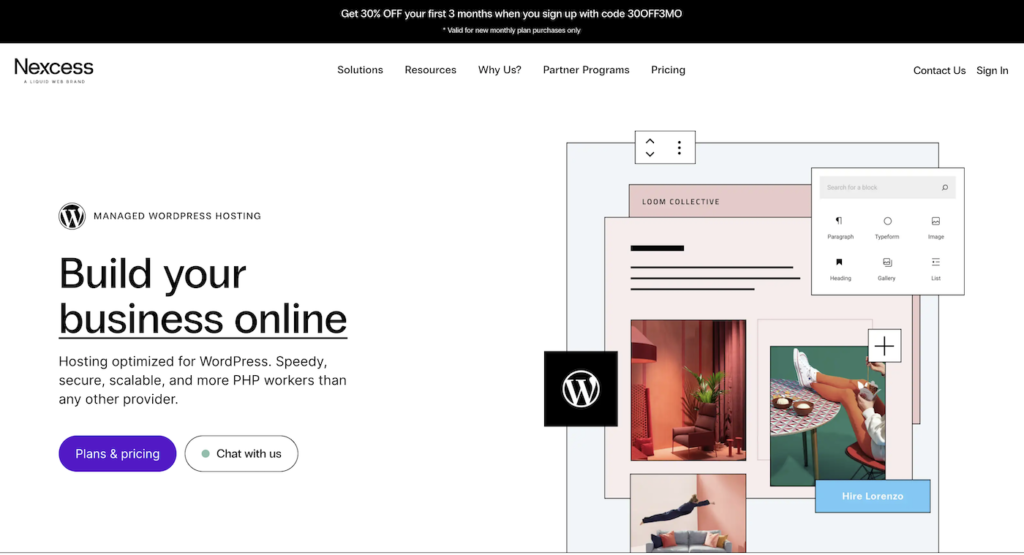
Nexcess is great for new WP users because they auto-create the site for you and offer lots of handy services with their hosting.
For example, they’ll automatically backup your site every day and update your plugins for you. And since their hosting is fast and capable of handling more dynamic websites like a travel directory, you won’t have to switch hosts once your site gets a lot of traffic.
Once you have your WordPress site online, it’s time to pick a theme.
The theme you choose will completely change the design of the site, and oftentimes, it will also add lots of useful functionality.
To build a site like Expedia, I recommend the Traveler theme , which adds all the tools you need in addition to providing a gorgeous style.
Traveler is an extremely comprehensive travel theme . You can publish hotels, activities, tours, car rentals, and flights. Traveler has beautiful templates for each and a complete search engine with sorting and filtering options.
When it comes to monetizing your site, there are tons of options. You can sell services yourself with WooCommerce or a payment gateway like PayPal or Stripe. You can charge a membership fee to use your site, or you can list services from other vendors like Expedia and Booking.com and get paid for your referrals.
Traveler has over 5,000+ sales and hundreds of positive reviews. It’s a dependable and impressive choice for anyone making their own website like Expedia.
Alternatives to Traveler
While Traveler is my top recommendation, there are quite a few WordPress themes that you can use to create a site like Expedia.
Check out our collection of the top travel agency WordPress themes for some more inspiration.

With a travel booking theme installed on your live WordPress site, you have all the tech you need.
Now it’s just time to customize the site.
There are some basic settings built into WordPress that you should work your way through to get started.
Our guide on basic WordPress customization is a great place to begin.

Then you can work your way through your theme’s options panel to change the colors and logo.
You can take things even further by adding a page builder to your site if you want additional control over the templates on your site.
Next, you’ll need to add some foundational content so that your first visitors will understand what your site is all about.
There are some foundational pages you need to get your website ready for traffic.
Our guide on creating your first WordPress site covers tips for creating essential pages like the About and Contact pages.
Since you’re making a travel booking site, you’ll need to get some offers published as well. This is especially easy for affiliates you can simply publish deals sourced from third-party sites.
Once you have your site fully branded and some live offers to promote, you’re ready to launch.
Before you launch your site, it’s a good idea to add analytics. This way, you can see how many people showed up for your launch and every day after that.
The Independent Analytics plugin makes it easy to add analytics to WordPress.
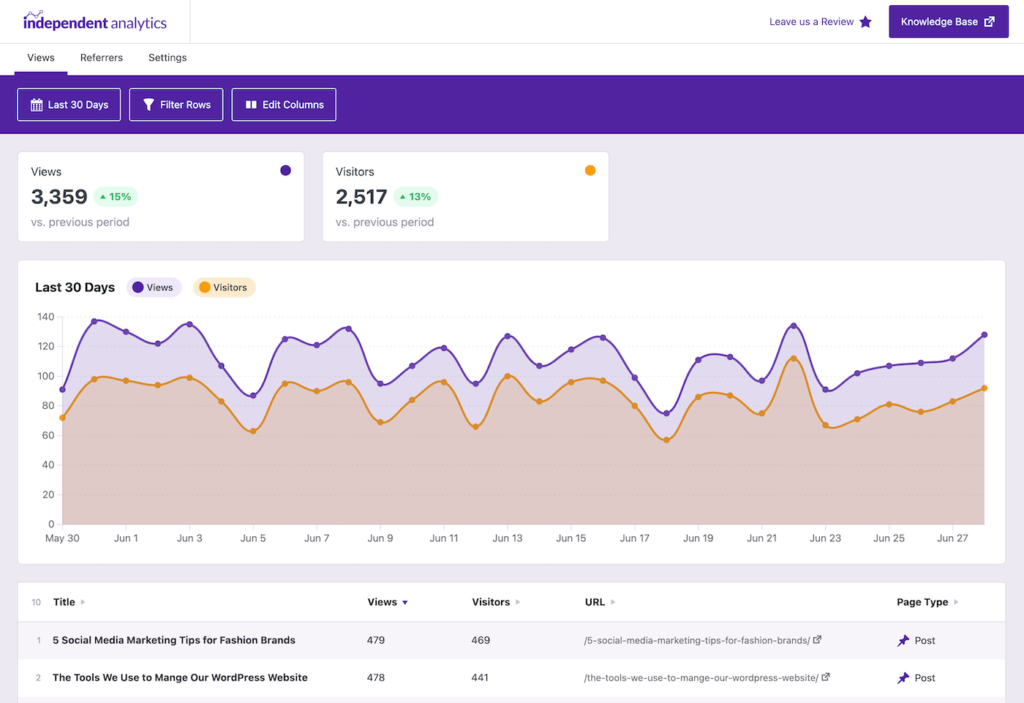
You can install it from your Plugins > Add New menu, and tracking will start right away. There’s no tracking script to copy, and you don’t have to create an account anywhere to use it.
When making a complex site like Expedia, you need a ton of functionality.
Luckily, the WordPress platform is so popular that you can find cheap pre-made tools with everything you need.
To review once more, you can create your site with these steps:
- Signup for hosting ( Nexcess )
- Pick a WordPress theme ( Traveler )
Once you’re done preparing the site, you can focus on growing your traffic and improving your profitability.
The initial setup might seem intimidating, but it only needs to be done once!
If you have any questions still about how to create a website like Expedia, don’t hesitate to post a comment below.
Get a beautiful beginner-friendly theme
Browse our collection of free WordPress themes
Running smoothly on thousands of websites right now.
How To Make A Travel Website: Step-By-Step Guide
Table of contents.
The boundless world of travel beckons, filled with vibrant cultures, breathtaking landscapes, and unforgettable adventures. Whether your dream is to share these experiences with fellow explorers through a captivating travel blog or to transform your travel expertise into a successful online business, a well-designed website is your gateway to the world.
Creating a travel website may seem daunting, but with the right tools and guidance, it’s incredibly achievable – even if you’re starting with little technical know-how. This comprehensive guide will break down the process into clear steps, providing everything you need to launch a stunning and functional travel website.
We’ll delve into choosing the best niche, crafting persuasive content, and optimizing your website to attract your ideal audience. And, to streamline the process, we’ll introduce you to the power of Elementor – a leading website builder designed to simplify the web creation journey. With its intuitive interface and travel-focused features, Elementor acts as your all-in-one toolkit for building a website that captures the spirit of exploration.
Let’s embark on this journey together!
Defining Your Travel Website’s Foundation
Choosing your niche.
The travel landscape is vast and diverse, so finding your unique voice and focus is essential for attracting the right audience. A well-defined niche will help your website stand out and make it easier for passionate travelers to find you. Consider these niche ideas:
- Adventure Travel: Target thrill-seekers with guides to hiking, camping, extreme sports, and off-the-beaten-path destinations.
- Luxury Travel: Cater to those seeking high-end experiences, focusing on exquisite accommodations, fine dining, and exclusive tours.
- Budget Travel: Become a go-to resource for backpackers and budget-conscious adventurers, sharing savvy tips for saving money while exploring.
- Local Guides: Specialize in your city or region, offering insider knowledge, hidden gems, and authentic experiences.
- Solo Travel: Support independent travelers with resources, safety tips, and destination recommendations tailored for solo journeys.
Target Audience
Once you’ve selected a niche, delve into understanding who your ideal traveler is. Consider their:
- Age and Demographics: Are you targeting millennials, families, couples, or retirees?
- Interests: What excites them – food, history, culture, wellness, photography?
- Travel Style: Do they prefer luxury, adventure, slow travel, or short getaways?
- Pain Points: What are their common frustrations or anxieties when planning travel?
By understanding your target audience, you can craft content, features, and travel offerings that directly address their needs and desires.
Choose a Domain Name
Your domain name is your website’s digital address, so make it count! Choose something that is:
- Memorable: Easy to spell, pronounce, and remember.
- Brand Relevant: Reflect on your chosen niche or brand name.
- Keyword-rich (optional): Include relevant keywords for a potential SEO boost, but prioritize memorability.
Reliable Web Hosting: The Backbone of Your Travel Website
Your website’s hosting is like the foundation of a house – it needs to be sturdy to support everything you’ll build on top of it. Choosing the right hosting provider is essential for ensuring that your travel website is fast, secure, and always online. Here’s what to look for:
- High Performance: Slow loading times can drive visitors away. Opt for a hosting provider that guarantees excellent speed and uptime. Look for features like SSD storage, content delivery networks (CDNs), and optimized server configurations.
- Robust Security: Travel websites often handle sensitive information like customer data and payment details. Prioritize hosting solutions with advanced security measures, including firewalls, malware scanning, automatic updates, and secure data backups.
- Scalability: As your website grows and attracts more traffic, your hosting needs to scale with it. Choose a provider that offers flexible resources and upgrade options.
- Reliable Support: When you encounter technical issues, having access to knowledgeable support is invaluable. Look for hosting providers with 24/7 availability and multiple support channels (live chat, email, phone).
Why Elementor Hosting is a Game-Changer
Elementor Hosting is not just web hosting ; it’s a tailored solution specifically designed to power exceptional WordPress websites built with the Elementor website builder. Here’s why it stands out:
- Built on Google Cloud Platform : Leverages robust infrastructure for lightning-fast speeds and reliability.
- Cloudflare Enterprise CDN : Accelerates content delivery across the globe, ensuring your website loads quickly, no matter where visitors are located.
- Premium Security: A multi-layered security suite, SSL certificates, and regular backups protect your site and customer data.
- Exceptional Support: Benefit from Elementor’s expert team, which is available 24/7 to assist you with both website-building and hosting-related concerns.
By choosing Elementor Hosting, you’ll equip your travel website with the performance, security, and support it needs to thrive in the competitive online landscape.
Setting Up the Essentials with WordPress and Elementor
Wordpress overview .
WordPress is the world’s most popular Content Management System (CMS), powering millions of websites across the globe. Its flexibility, vast community, and extensive plugin ecosystem make it a perfect foundation for your travel website. Key benefits of WordPress include:
- Ease of Use: User-friendly interface, even for beginners.
- Customization: Thousands of themes and plugins to personalize your website’s look and functionality.
- SEO-Friendly: Optimized structure and tools to help your website rank higher in search engines.
- Community Support: Access extensive online resources, tutorials, and forums.
Installing WordPress
While many hosting providers offer one-click WordPress installation, Elementor Hosting takes it a step further with pre-installed WordPress . This means your website-building journey begins immediately upon signing up! If you’re using a different hosting provider, they’ll likely provide clear instructions on the WordPress installation process.
Choosing a Travel-Focused Theme
Your WordPress theme determines the overall appearance and layout of your website. Look for themes specifically created with travel websites in mind. These often include features like:
- Stunning Image Galleries: Showcase breathtaking destinations and travel experiences.
- Destination Listings: Organize and display locations with essential details such as maps, descriptions, and reviews.
- Booking Integration: Seamlessly connect to booking systems if you plan to offer tours or accommodations.
- Responsive Design: Ensure your website looks fantastic on desktops, tablets, and smartphones.
- Travel-Specific Widgets: Display weather forecasts, currency converters, or destination spotlights.
Introducing the Elementor Website Builder
Elementor revolutionizes the WordPress website-building process by empowering you to craft visually stunning pages and posts without needing to write a single line of code. This intuitive drag-and-drop builder is incredibly user-friendly, even for those with zero web design experience. Here’s what makes it stand out:
- Live, Visual Editing: See changes instantly as you build, streamlining the design process.
- Pre-designed Templates and Blocks: Kickstart your design with professionally designed layouts for homepages, destinations, blog posts, and more. Customize them effortlessly to match your brand.
- Extensive Widget Library: Access numerous content elements like headings, buttons, image galleries, testimonials, maps, and more – simply drag and drop them into place.
- Theme Builder : Gain complete control over your entire site’s design, including headers, footers, single post layouts, archives, and custom page templates.
- Mobile-Responsive Editing: Ensure your website looks perfect across all devices with dedicated tools for adjusting layouts on tablets and smartphones.
The Power of Elementor for Travel Websites
Elementor goes beyond general website building. It offers features that perfectly complement the needs of travel websites:
- Destination Showcases: Create captivating destination pages with Elementor’s versatile widgets and layouts.
- Interactive Maps: Embed maps to highlight locations, routes, or points of interest.
- Stunning Galleries: Display breathtaking destination photos and travel experiences.
- Customer Reviews: Build social proof by showcasing testimonials with dedicated widgets.
- Booking Forms : Integrate booking forms seamlessly with customization options to match your website’s design.
With Elementor, designing a professional and engaging travel website becomes a truly enjoyable experience, empowering you to focus on sharing your passion for travel.
Designing Your Homepage for Success
Homepage structure: the key elements .
Your homepage is the digital doorway to your travel website. It’s where you capture visitors’ attention, introduce your brand, and guide them toward further exploration. Here’s a breakdown of essential elements to include:
- Compelling Header and Navigation: The header is prime real estate. Include a clear logo, tagline if applicable, and an intuitive navigation menu, making it easy for visitors to find what they’re looking for.
- Hero Section with Stunning Visuals: Make a powerful first impression with high-quality images or videos representing the essence of travel. Accompany this with a captivating headline, concise tagline, and a clear Call to Action (CTA) button (e.g., “Explore Destinations,” “Book Your Adventure”).
- Destination Search Bar: Help visitors quickly find what they seek. Consider Elementor’s dynamic capabilities to create a search bar that pulls and displays relevant destination content as users type.
- Featured Destinations or Travel Packages: Immediately showcase your top offers or popular destinations to pique interest. Consider image carousels, eye-catching grids, or short descriptions paired with alluring visuals.
- Calls to Action: Clearly guide visitors towards the next step, whether it’s browsing destinations, reading your blog, or signing up for your newsletter.
- Customer Testimonials or Social Proof: Build trust early on by displaying positive reviews from past travels or showcasing social media feeds with user-generated content.
Design Best Practices
Keep these principles in mind when crafting your homepage:
- Visual Hierarchy: Use size, color, and spacing to guide the eye toward the most important elements.
- Mobile Responsiveness: Prioritize design that seamlessly adapts to various screen sizes, providing a smooth experience for all visitors.
- Compelling Travel Content: Use short but descriptive text to evoke wanderlust and inspire action.
- White Space: Let your design breathe, ensuring elements don’t feel cluttered.
Leveraging Elementor’s Power: Widgets, Templates, and Customization
Elementor simplifies homepage design with a wealth of tools and resources:
Homepage Templates:
Elementor offers a vast library of pre-designed homepage templates catering to various travel niches and styles. Choose a template that aligns with your vision and use it as a solid foundation, saving you precious time.
Dedicated Widgets:
Elementor provides a diverse set of widgets tailored for your homepage. Here are some key ones:
- Hero Section Widgets: Design customizable hero areas with images, videos, text, and buttons.
- Destination Widgets: Create interactive destination grids, lists, or carousels for seamless browsing.
- Call to Action Widgets: Craft eye-catching CTAs for various purposes like booking, subscribing, or exploration.
- Testimonial Widgets: Showcase customer reviews in a variety of layouts.
- Map Widgets: Integrate maps to highlight specific locations, routes, or points of interest.
- Social Media Widgets: Display your social feeds to encourage engagement.
Customization Power:
Elementor gives you full control over the appearance and functionality of these widgets. Adjust these elements:
- Colors and Typography: Match your website’s branding perfectly.
- Spacing and Layout: Create the optimal visual flow for your homepage.
- Animation and Effects: Add subtle interactions to boost engagement.
- Responsive Controls: Fine-tune how your homepage looks on different devices.
Theme Builder:
For advanced control, Elementor’s Theme Builder lets you design custom headers, footers, and templates that apply to your entire site, including the homepage. This ensures a cohesive look and feel throughout your website.
The Beauty of Elementor: Ease and Flexibility
The true magic of Elementor lies in its drag-and-drop interface. You can visually arrange widgets, see results instantly, and experiment with different layouts without any coding knowledge. This empowers you to iterate on your design until it perfectly conveys your travel brand’s personality.
Must-Have Pages for Your Travel Website
About us: building trust and connection .
Your “About Us” page is an opportunity to introduce yourself, your team, or your brand’s story. Here’s how to make it compelling:
- Share Your Passion: Explain what inspires your love for travel and why you’re qualified to provide travel advice or services.
- Highlight Expertise: Showcase any unique experiences, skills, or certifications that set you apart.
- Be Authentic: Use a conversational tone that reflects your brand’s personality.
- Include Visuals: Incorporate photos of yourself, your team, or destinations you’ve visited to add a personal touch.
- Social Proof: Feature customer testimonials or brief case studies to enhance credibility.
Contact Us: Facilitating Smooth Communication
Provide multiple ways for visitors to reach you:
- Contact Form: A simple form with fields for name, email, and message is essential. Consider Elementor’s Form Builder for creating custom forms that integrate with your CRM or email marketing tools.
- Email Address: Clearly display your contact email and aim for timely responses.
- Phone Number: Include a phone number for those who prefer to call directly, especially regarding urgent inquiries.
- Map Embed: If you have a physical location, embed a map for easy directions.
- Social Media Links: Prompt followership for further engagement.
Travel Blog: The Heart of Content Creation
A well-maintained blog adds immense value to your travel website:
- SEO Benefits: Fresh, high-quality blog content can boost your website’s visibility on search engines.
- Audience Engagement: Share informative travel guides, inspiring stories, and insider tips to build a loyal following.
- Establishes Authority: Demonstrate your expertise and build trust among your target audience.
- Internal Linking Opportunities: Strategically link blog posts to related destination pages or offers, improving your website’s structure for both users and search engines.
- Social Media Shareability: Compelling blog content encourages social sharing, expanding your reach.
Destination Pages: Inspiring Exploration
Your destination pages should transport visitors to the heart of a location, showcasing its unique charm and enticing them to visit. Consider including these elements:
- Stunning Visuals: High-quality photos and videos are crucial. Feature landscapes, landmarks, accommodations, and local experiences.
- Detailed Descriptions: Provide essential information about climate, best times to visit, historical background, major attractions, and popular activities. Craft descriptions that are both informative and evocative of the destination’s character.
- Practical Travel Tips: Offer advice on transportation, local currency, visa requirements, cultural considerations, and recommended packing items.
- Local Insights: Share off-the-beaten-path gems, authentic food recommendations, and insider knowledge to help visitors experience the destination like a local.
- Customer Reviews and Testimonials: Include specific testimonials about the destination to build credibility.
- Tour or Accommodation Options: If applicable, showcase tours you offer or list accommodations within the destination, providing links for further exploration or booking.
- Maps and Directions: Embed relevant maps to help visitors visualize the destination and its surroundings.
- Calls to Action: Encourage visitors to book a trip, read related blog posts, or sign up for your email list for future updates.
Elementor Tools for Destination Pages
Elementor simplifies the process of designing visually appealing and informative destination pages:
- Pre-designed Templates: Choose from destination-specific templates for a headstart.
- Image Gallery Widgets : Create beautiful galleries to showcase the destination’s best features.
- Testimonial Widgets: Display testimonials and reviews strategically throughout the page.
- Map Widgets: Integrate interactive maps, and allow visitors to explore nearby attractions using custom markers.
Booking and Reservations: Streamlining the Process
If you plan to allow direct bookings for tours, activities, accommodations, or flights, choosing the right booking system and integrating it seamlessly into your website is paramount. Here’s what to consider:
Industry-specific Solutions: Research booking systems designed specifically for the travel industry. These often include features like:
- Real-time availability calendars.
- Secure online payment processing.
- Inventory management.
- Customer booking management interfaces.
WordPress Integration: Look for booking systems that offer dedicated WordPress plugins or have well-documented integration methods compatible with Elementor. Popular options include booking solutions that work well with WordPress and Elementor, but be sure to conduct thorough research before making your final selection.
User Experience: Prioritize a booking system that provides a smooth and intuitive experience for your visitors. The booking process should be clear, quick, and mobile-friendly.
Customization: Choose a system that offers some level of customization to align with your website’s design and branding.
Payment Gateways: Ensuring Secure Transactions
To process online payments, you’ll need to integrate with a payment gateway. Look for reliable gateways that:
- Widely Accepted: Support major credit cards, debit cards, and potentially alternative payment methods like PayPal or digital wallets.
- Security and PCI Compliance: Select a payment gateway offering robust security measures and adhering to Payment Card Industry Data Security Standards (PCI DSS) to protect sensitive customer data.
- Fees and Transaction Costs: Consider the various fee structures associated with payment gateways and choose one with a transparent pricing model that suits your expected volume.
Elementor Integration
Elementor’s Form Builder offers flexibility for creating custom booking forms that can be integrated with your chosen booking system and payment gateway.
Optimizing for Search Engines (SEO) and User Experience
Seo basics: the key to online visibility .
Search Engine Optimization (SEO) is the practice of improving your website’s ranking in search results pages (SERPs) like Google or Bing. With well-implemented SEO, potential travelers are more likely to discover your website when searching for destinations, travel advice, or experiences. Here’s an overview of the fundamentals:
- Target Keywords: Identify the terms people use to search for content that your travel website offers. Consider location-specific keywords, activity-based keywords (e.g., “hiking trails in Colorado”), and question-based keywords (e.g., “best time to visit Bali”).
- Content is King: Consistently create high-quality, informative, and original content that aligns with your target keywords. This includes blog posts, destination pages, and detailed guides.
- User Experience (UX): Design your website to be user-friendly, with fast loading times, clear navigation, and mobile responsiveness. Search engines favor websites that provide a positive visitor experience.
Keyword Research: Finding the Right Terms
Keyword research forms the basis of your SEO strategy. Here are some helpful tools:
- Google Keyword Planner: Discover keywords for your niche and estimate their search volume.
- SEMrush, Ahrefs, or Similar Tools: These platforms provide comprehensive keyword research capabilities, including competitor analysis and search volume trends.
- Answer the Public: This tool shows common questions people ask around certain topics, providing insights into long-tail keywords.
On-Page Optimization: Crafting Content that Search Engines Love
On-page optimization refers to the techniques you implement directly on your website’s pages to improve their ranking in search results. Here’s how to do it:
Meta Titles and Meta Descriptions: These snippets appear in search results and help users understand your page’s content. Follow these guidelines:
- Include your target keyword.
- Write compelling descriptions that encourage clicks.
- Stay within optimal character lengths (typically around 50-60 characters for titles and 150-160 characters for descriptions).
Header Tags (H1, H2, H3): Structure your content by using headings, with the H1 being the most important (usually the page title). Include relevant keywords in your headings while prioritizing a natural flow for the reader.
Image Optimization (Alt Text and File Name): Describe your images using informative alt text that includes keywords. Also, optimize file sizes to improve page load speed. Elementor Image Optimizer can help with this.
Internal Linking : Build a network of relevant internal links within your website. Link between relevant destination pages and blog posts, helping search engines understand the structure and hierarchy of your content.
Content Quality: Focus on creating unique, informative, and engaging content that fulfills the visitor’s search intent. Avoid thin or duplicate content.
Keyword Placement: Strategically incorporate your target keywords throughout your content, including in headings, the first paragraph, and image alt text. Avoid keyword stuffing, as it can hurt your rankings.
Elementor Tools for On-Page Optimization
Elementor offers some features to assist with on-page optimization:
- SEO Fields: Easily set your meta title and meta description directly within the Elementor editor for each page.
- Heading Widgets: Structure your content using H1, H2, H3, etc., with styling control.
- Image Widget + Alt Text: Add images with detailed alt text descriptions.
Website Speed: Why Fast Loading Times Matter
Website speed heavily influences both user experience and search engine rankings. Here’s why it’s crucial:
- User Bounce Rate: Slow loading speeds lead to higher bounce rates – visitors abandoning your site out of frustration.
- Search Engine Penalties: Search engines like Google prioritize fast websites in their rankings. Slow websites may need help to gain visibility.
- Conversion Rates: Website speed directly impacts conversions. Faster websites often convert visitors into travelers more effectively.
- Overall User Satisfaction: A snappy, responsive website creates a positive first impression and keeps visitors engaged with your content.
Optimizing for Speed: Key Techniques
Let’s discuss some essential tactics for improving your website’s loading speed:
- Performance-Focused Hosting: Choose a high-quality hosting provider optimized for speed, like Elementor hosting with its Google Cloud Platform foundation and Cloudflare Enterprise CDN.
- Image Optimization: Compress images using tools like Elementor’s Image Optimizer without sacrificing quality. Properly size images to avoid them being larger than they need to be on the page.
- Caching: Implement caching mechanisms (browser caching, server-side caching, object caching) to store frequently accessed data and reduce server load. Elementor Hosting offers various caching features to enhance speed.
- Content Delivery Network (CDN): A CDN like Elementor Hosting’s Cloudflare Enterprise CDN distributes content across servers worldwide, decreasing load times for visitors from different locations.
- Minimize HTTP Requests: Combine resources where possible (CSS and JavaScript files) to reduce the number of requests the browser needs to make.
- Clean Code: Ensure your website is built with optimized code to minimize bloat.
User-Friendly Navigation: Guiding Your Visitors
Intuitive navigation is like a well-marked path through the rich landscape of your website. Let’s discuss the best practices for designing a user-friendly menu system:
- Clear and Concise: Menu labels should be descriptive and easy to understand. Use familiar terms like “Destinations,” “Blog,” “About Us,” and “Contact.”
- Limited Options: Avoid overwhelming users with too many choices in your main navigation. Focus on the most important categories.
- Hierarchical Structure: Organize subcategories within dropdown menus or mega menus to create a logical hierarchy for complex content.
- Prominent Placement: Ensure your navigation menu is easily visible, typically at the top of the page (header) or as a persistent sidebar menu.
- Mobile Responsiveness: Prioritize a navigation experience that adapts seamlessly to smaller screens, with features like hamburger menus and clear tap targets.
- Search Functionality: Include a prominent search bar to help visitors quickly find specific content, especially on websites with extensive destinations or blog posts.
- Breadcrumbs: Consider using Breadcrumbs, especially on pages with a deeper hierarchy, to help users understand their current location within the website and navigate back to previous levels with ease.
Elementor’s Navigation Tools
Elementor streamlines menu creation with:
- Nav Menu Widget: Design custom navigation menus with drag-and-drop functionality and extensive styling options.
- Mega Menus: Create expansive dropdown menus for navigation-rich websites to display a wide range of subcategories at once.
- Responsive Controls: Fine-tune the appearance of your menus on different devices for optimal usability.
Marketing Your Travel Website
Social media: building a community & sharing your passion.
Social media platforms offer a unique opportunity to connect with travel enthusiasts, showcase your brand’s personality, and inspire wanderlust. Here’s how to harness their power:
Channel Selection: Focus on platforms where your target audience is most active. Popular choices for travel include:
- Instagram: Ideal for sharing visually stunning photos and videos.
- Facebook: Great for building community, sharing updates, and running targeted advertising campaigns.
- Pinterest: Excellent for driving traffic with inspirational travel imagery and guides.
- YouTube: Perfect for longer-form video content like destination tours and travel vlogs.
High-Quality Content: Post a mix of:
- Inspiring visuals (photos and videos) of destinations.
- Travel tips and advice.
- Behind-the-scenes glimpses of your brand.
- User-generated content (reposting visitor photos and testimonials with permission).
Engage with Your Audience: Respond to comments, host contests, ask questions, and actively participate in conversations.
Hashtags: Utilize relevant hashtags to increase the visibility of your posts (both general and location-specific).
Paid Social Media Advertising
Social media ads allow you to target specific demographics, interests (i.e., “adventure travel”), and even the locations where your ideal travelers are based.
- Attention-grabbing visuals: Use compelling images or videos for your ad campaigns.
- Persuasive Copy: Highlight unique selling points and include a clear Call to Action (CTA).
- Targeted Ads: Use platform-specific targeting options to reach your ideal audience.
Email Marketing: Personalized Communication for Long-term Engagement
Email marketing allows you to connect with your audience directly, delivering personalized messages tailored to their interests and stage in the travel planning process. Here’s why it’s important:
- Direct Connection: Email marketing gives you a direct line of communication with people who have expressed interest in your website or brand.
- Targeted Campaigns: Segment your email lists based on demographics, travel interests, or past interactions, enabling you to send highly relevant content.
- Nurture Leads: Build relationships over time by providing value, positioning yourself as trusted experts, and ultimately encouraging bookings or return visits.
- Promotions & Offers: Share exclusive deals, time-sensitive discounts, or loyalty programs to drive conversions.
- Measurable Results: Track open rates, click-through rates, and conversions to get actionable insights and continuously improve your email campaigns.
Email Signup Forms (with Elementor)
Strategic placement of signup forms is key for growing your email list:
- Homepage Prominence: Include a highly visible form in your hero section or primary content area.
- Blog Sidebar or Popups: Use unobtrusive sidebars or timed popups on your blog to capture readers’ attention. Elementor’s Popup Builder offers robust options for creating eye-catching signup forms.
- Dedicated Landing Pages: Create targeted landing pages with enticing offers to collect email addresses.
- Compelling Incentives: Offer valuable lead magnets like destination guides, travel checklists, or exclusive discounts to persuade visitors to subscribe.
Advertising: Reaching the Right Audience at the Right Time
Targeted advertising allows you to promote your website in front of people who are most likely to be interested in your offerings. Here’s a look at some effective platforms:
- Search Engine Ads (e.g., Google Ads): Appear atop search results pages for specific keywords, ensuring you reach users with high intent. Target terms like “budget flights to [destination]” or “best [destination] hiking trails.”
- Social Media Ads (e.g., Facebook, Instagram, Pinterest): Utilize detailed targeting options based on demographics, interests, and behaviors. Leverage eye-catching visuals and persuasive copy for your ad campaigns.
- Display Ads (e.g., Google Display Network): Showcase banner ads across a vast network of websites, often related to travel content or visited by people who have shown an interest in travel.
- Retargeting Ads: Reach users who have already visited your website but haven’t made a booking. This serves as a reminder, bringing your brand and offerings back into their consideration.
Tips for Effective Travel Advertising
- Compelling Ad Creative: Use eye-catching images, videos, and persuasive copywriting that highlights your unique selling points.
- Targeted Audience: Define your ideal traveler and utilize platform-specific targeting options to reach them more precisely.
- Clear Calls to Action: Guide users towards the desired action (booking, subscribing, visiting a specific destination page).
- Track and Analyze: Utilize platform analytics to monitor your ad performance, identify areas for improvement, and optimize your campaigns over time.
Content Marketing: Value-Driven Strategies to Attract Travelers
Content marketing involves creating and distributing valuable, informative content that aligns with your potential visitors’ interests and pain points. Here’s why it’s crucial for your travel website:
- SEO Benefits: High-quality content helps improve search rankings for relevant keywords, attracting organic traffic over time.
- Establishes Authority: Demonstrate your expertise by offering in-depth guides, expert tips, and local insights. This builds trust and positions you as a go-to resource.
- Audience Engagement: Captivating content encourages social sharing and sparks conversations, expanding your reach and fostering community.
- Supports Other Marketing Channels: Repurpose content for social media posts, email newsletters, and even ad campaigns.
Types of High-Value Content for Travel Websites
- Blog Posts: Share travel guides, itineraries, local recommendations, packing tips, budget travel advice, cultural insights, and personal travel stories.
- Destination Guides: Provide comprehensive information about specific locations, including attractions, accommodations, transportation, cultural tips, and hidden gems.
- Listicles: Create engaging listicles such as “Top 10 Family-Friendly Destinations” or “Best Hikes in [Region].”
- Infographics: Use infographics to illustrate travel data, packing lists, or itineraries in a visually appealing way.
- Videos: Showcase destinations, create travel vlogs, or offer how-to tutorials for packing or navigating a new city.
Enhancing Your Website
Tips for high-quality, seo-friendly travel content .
- Focus on a Specific Topic: Each piece of content should have a clear focus, addressing a single travel-related query or theme.
- Keyword Research: Use the techniques discussed previously to identify relevant keywords for your content and naturally incorporate them throughout.
- Answer User Queries: Understand the searcher’s intent and structure your content to provide clear and informative answers.
- Compelling Writing: Craft engaging content with an authentic voice that resonates with your target audience.
- Detailed and Informative: Provide in-depth information, practical tips, and unique insights rather than offering generic content.
- Structure for Readability: Use headings (H2, H3), short paragraphs, bullet points, and images to break up your content and improve readability.
- Unique Perspective: Share your own experiences, insider tips, or curated recommendations to differentiate your content and stand out in the competitive travel writing landscape.
- Optimize for Featured Snippets: Consider structuring some sections of your content (like lists or FAQs) in a manner that can be pulled as featured snippets on search results pages, increasing visibility.
Travel Tips and Packing Lists: Essential Resources for Every Trip
A dedicated section for travel tips and packing lists helps position your website as a comprehensive resource. Consider including
- General Travel Tips: Cover topics such as booking flights and accommodations, planning a budget, staying safe and healthy while traveling , responsible tourism practices, and navigating cultural differences.
- Destination-Specific Tips: Create guides tailored to unique destinations, addressing the best times to visit, local customs, transportation tips, budgeting, and must-try experiences.
- Packing Lists: Provide customizable packing checklists for different types of trips (adventure travel, beach vacations, city breaks, backpacking, etc.)
- Travel Gear Recommendations: If relevant, curate lists of your favorite travel gear, from backpacks and luggage to tech gadgets and comfort items.
- Additional Resources: Link to external resources such as weather websites, currency converters, or vaccination information.
Benefits of Travel Tips and Packing Lists
- Added Value for Visitors: Provide practical advice, helping travelers plan and prepare for their trips with ease.
- SEO Opportunities: Target long-tail keywords like “packing list for [destination]” or “travel tips for [country].”
- Build Trust: Establish yourself as a knowledgeable source of travel information.
Reviews and Testimonials: The Power of Social Proof
In the travel industry, online reviews and testimonials wield immense influence over potential travelers’ decisions. Here’s why they are crucial:
- Build Trust: Positive reviews foster a sense of trust with potential travelers, easing their anxieties and making them more confident in choosing your travel experiences or services.
- Influence Decisions: Travelers often consult reviews before making bookings. Compelling testimonials can be the tipping point for their decision.
- Boost SEO: Integrate reviews directly on your website, adding fresh, keyword-rich content that can improve search engine rankings.
- Gain Insights: Reviews offer valuable feedback, helping you identify areas for improvement and cater to your travelers’ needs even better.
Acquiring Customer Reviews
Proactively encourage satisfied customers to leave reviews. Consider these strategies:
- Post-Trip Emails: Send automated follow-up emails after a trip, requesting feedback and providing links to review platforms.
- On-Site Prompts: Include subtle prompts on relevant website pages, encouraging customers to share their experiences.
- Social Media: Ask customers to leave reviews on your social media pages.
- Incentives: If appropriate, consider offering small incentives (discounts, loyalty points) for customers who write reviews.
Strategic Placement of Testimonials
Where you showcase testimonials on your website significantly affects their impact. Consider these key areas:
- Homepage: Include a few impactful testimonials in a carousel or dedicated section, especially highlighting experiences relevant to your target audience.
- Destination Pages: Incorporate testimonials specific to each destination, reinforcing its appeal.
- Booking/Tour Pages: Displaying testimonials near booking forms or calls-to-action can provide that extra nudge for hesitant visitors.
- “About Us” Page: Testimonials about your overall brand or company strengthen your credibility.
- Dedicated Testimonials Page: Create a comprehensive page showcasing a larger collection of testimonials, allowing potential travelers to delve deeper into the experiences of others.
Effective Presentation with Elementor
Elementor simplifies the process of creating compelling testimonial displays:
- Testimonial Widgets: Utilize dedicated Testimonial widgets for easy customization and seamless incorporation into various page designs.
- Carousels or Sliders: Display testimonials in a rotating format to maximize visibility within limited space.
- Ratings and Stars: Include star ratings alongside testimonials for an additional layer of social proof.
- Customer Photos: If possible, feature real customer photos alongside their testimonials to increase authenticity.
Currency Converter and Language Translation: Welcoming Global Travelers
Expanding your reach to a worldwide audience can significantly boost your travel website’s potential. Here’s how currency conversion and translation tools play an essential role:
Currency Converter
- Convenience for Travelers: Allow visitors to easily understand pricing in their local currency, simplifying their decision-making process.
- Ease of Comparison: Travelers can compare prices to make informed choices without navigating to external conversion websites.
- Enhanced User Experience: Providing a seamless experience that avoids confusing visitors with unfamiliar currencies builds trust and credibility.
Language Translation Tools
- Cater to a Global Audience: Reach a wider range of potential travelers by making your website accessible in multiple languages.
- Inclusivity: Demonstrate a commitment to creating a welcoming and inclusive environment for all travelers, regardless of their native language.
- Improved SEO: Multilingual websites can potentially improve search rankings in different regions, increasing your visibility globally.
Integration Options
- Plugins and Widgets: Explore WordPress plugins and widgets that specialize in currency conversion and language translation. Popular options include Currency Converter and Translate WordPress with GTranslate.
- External Services: Consider integrating with external translation services that offer advanced features and support for a wide range of languages.
Accessibility Features: Building an Inclusive Travel Website
Web accessibility involves designing and developing websites that can be used by everyone, regardless of their abilities or limitations. Here’s why it’s crucial for travel websites:
- Cater to a Wider Audience: Making your website accessible allows you to serve a broader market, including travelers with disabilities who represent a significant portion of the travel industry.
- Improve User Experience for Everyone: Accessibility features often benefit all users. For example, clear headings and image descriptions enhance readability and navigation for everyone.
- Legal Compliance: In some regions, website accessibility is mandated by law, such as the Americans with Disabilities Act (ADA).
- Ethical Considerations: Building an inclusive website aligns with responsible and ethical business practices.
Key Accessibility Considerations for Travel Websites
- Alternative Text (Alt Text): Describe all images using informative alt text, enabling screen readers to convey visual content to users with visual impairments.
- Descriptive Heading Structure: Utilize clear headings (H1, H2, etc.) for easy navigation and content comprehension, especially for those using screen readers.
- Color Contrast: Ensure sufficient contrast between text and background colors for better readability by those with visual impairments.
- Keyboard Navigation: Ensure all website functionality is accessible using only a keyboard, which is crucial for users with motor disabilities.
- Screen Reader Compatibility: Test your website with screen readers to optimize the experience for visually impaired users.
Staying Ahead in The Travel Industry
Tracking and analytics: understanding your web traffic.
To make informed website improvements, it’s essential to understand how visitors interact with your content. Here’s where analytics come into play:
Google Analytics (or Similar Tools): Install an analytics tool on your website to gain insights into:
- Traffic Sources: Learn where your visitors are coming from (search engines, social media, referrals, etc.).
- Popular Pages: Identify the content that resonates the most with your audience.
- Bounce Rates: Understand which pages might be causing visitors to leave prematurely.
- Visitor Demographics and Interests: Gather data to tailor your content and offerings further.
Conversion Tracking: If you have bookings or subscriptions, track which pages and campaigns lead to the most conversions.
Continuous Improvement: Adapting to Visitor Needs
Use the insights from analytics to guide your website optimization:
- A/B Testing: Experiment with different versions of pages or design elements (e.g., CTA button placement) to see what performs best.
- Cater to Emerging Trends: Analyze your website traffic to spot changing interests or preferences among travelers and adjust your content strategy accordingly.
- User Feedback: Actively solicit feedback through surveys, polls, or direct contact forms to gather valuable insights and address pain points.
Website Security: Protecting Your Site and Traveler Data
Travel websites often handle sensitive traveler information such as names, contact details, and payment information. Ensuring robust security is essential for safeguarding this data and maintaining customer trust. Let’s discuss some vital measures:
- Strong Passwords and Authentication: Enforce strong password policies for both your website’s administrative area and any user accounts you might have. Consider implementing Two-Factor Authentication (2FA) for an additional layer of security.
- Regular Updates: Keep your WordPress installation, themes, plugins, and hosting environment updated with the latest security patches. Outdated software is a prime target for hackers.
- SSL Certificate: Install an SSL (Secure Sockets Layer) certificate to encrypt data transmission between your website and visitors’ browsers. Look for the “https://” prefix in your website URL and a padlock icon in the address bar.
- Security Plugins: Utilize WordPress security plugins for added protection. These plugins offer features like firewall protection, malware scanning, and intrusion detection.
- Elementor Hosting Security Features: Take advantage of the built-in security measures provided by Elementor Hosting, including frequent site backups, malware protection, and Cloudflare security services.
Building a successful travel website involves more than just beautiful visuals and tempting destinations. Throughout this guide, we’ve explored the key considerations for success:
- Strategic Niche and Audience: Find your unique focus within the travel space and tailor your content to the ideal traveler you wish to serve.
- High-Quality Content and SEO: Create informative content that aligns with what searchers are looking for, and optimize it to rank well in search results.
- Excellent User Experience: Prioritize a website that’s fast, mobile-friendly, easy to navigate, and brimming with valuable features.
- Social Media Presence: Connect with potential travelers on social platforms, sharing inspiring content and building a thriving community.
- The Power of Elementor: Elevate your web design with Elementor’s intuitive tools, enabling you to create visually stunning and functional pages effortlessly.
Creating a thriving travel website takes dedication and a willingness to adapt to an ever-evolving landscape. Embrace experimentation, learn from your audience, and continue refining your strategy over time. Remember, the journey is an adventure in itself!
How to Create a Travel Website: Types, Features, Industry Trends

Most people plan a journey by seeking advice from the same source — the Internet. As ending the pandemic is becoming more solvable, many of us think about where to travel next.
Ironically, we tend to get easily overwhelmed by the sheer amount of tasks. What place is ok for a night stay? Which is the best camera backpack? Where to refuel?
So today, we will figure out how a travel website works. We will also share tips on how to make your own travel website genuinely shine.
Travel industry overview
There are many destinations to look forward to when the Covid-19 threat eventually fades into the background. Below we share the latest trends you need to know to build a travel website.
Covid-19 restrictions loosen
Forbes says the situation looks a lot more promising from when much of the travels were put on pause. Here are quick facts:
- Many Schengen area states reopen for tourism;
- People are likely to go abroad if getting vaccinated;
- Air traffic increased by 16% in flights taking off in late May;
- Booking momentum saw a big increase for the first time since March 2020.
- Many Caribbean countries are open to U.S. citizens, pending negative PRL tests.
Also, having a vaccine pass would eliminate the need for quarantine, thus boosting the travel industry.
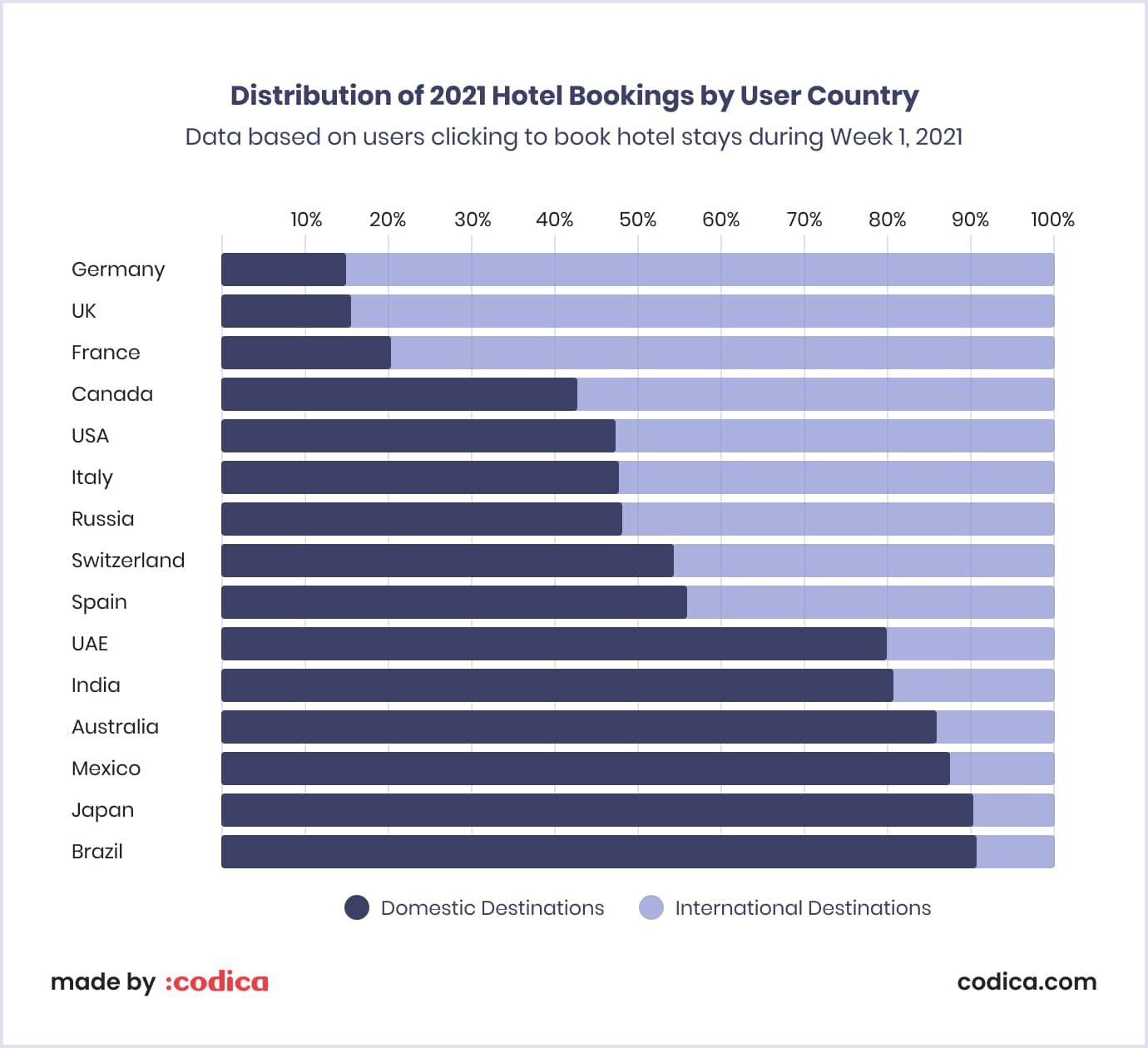
Source: TripAdvisor
Once-in-a-lifetime trips
A sense of a major accomplishment drives many travelers, as reported by ABTA . In other words, people love to cross off something on their bucket list. Especially when journeys seem a means to cope with quarantine fatigue.
Booking.com predicts a wave of “workcation.” It comes as no surprise considering how many of us are involved in jobs associated with PC usage. Such a tendency motivates individuals to book out a couple of days or a week to work remotely.
The most bang for your buck
The economy will affect travels abroad since many have lost income due to a pandemic. Addressing the recovery phase, the Guardian says that the UK business trippers will cut their future flights.
Self-drive mode
With Covid-19 measures causing people to travel within native countries, a self-drive mode is rocketing. Thus, for example, thanks to the U.S. citizens rapidly booking summer getaways, RVshare’s business experiences a 114% increase .

Travel website types explained
Defining what a travel website is can be a tough one. Turns out, there’s a myriad of sites claiming to be “for tourism.”
A memorable journey loves preparation. Surely you want to make the best out of many activities out there. So, before setting off, you find suitable tickets, a place to stay, maybe buy certain equipment and more.
Thus, a travel website is the one that helps us avoid journey-related hassles. What are types of travel websites and what do you need to know to start one? Read on to find out.
Tour operator
Normally, there are a few types of tour operators out there.
Inbound tour operators sell all arrangements to travelers. Such a type of operator brings their clients to a destination both individually and in groups.
Sense of Africa is a nice example. This agency provides private, self-drive, FIT, and group journeys in several African countries.

Secondly, we have outbound tour operators. Those companies sell packages designed for traveling abroad from their country.
Domestic tour operators, on the contrary, provide travel tours within a person’s native country.
And finally, receptive tour operators (RTOs) act as product suppliers to other operators. RTOs also spread awareness around the possibilities travel agencies have to offer.
Personal journey matchmaker
It’s an intermediary between the travel industry and the customer. Since almost everyone jumps online, travelers can search and book what they need with no travel agents involved.
Take Classic Journeys , for instance. This travel website helps you find a trip based on location, tour style, and departure date. Those picking a particular tour and independents making their own itineraries are equally vital to this type of site:

Travel accessories supplier
Everybody needs to know what will come in handy during a trip. More importantly, where to get those stuff. How to create a travel website having all of them? Take a look at GoTravel , a site specializing in multiple travel accessories at once:

Below you find essentials with examples that make journeys less troubling:
- Packing (hiking backpacks, carry-on luggage, suitcases, backpacks for camera lenses);
- E-devices (action cameras, power banks, location trackers);
- Safety gear (money belts, padlocks, flashlights);
- Hygiene items (hand sanitizers, mosquito repellents, masks to reduce the risk of catching viruses);
- Comfort accessories (headphone jack splitter, thermoses, blankets, travel pillows).
Besides, all things have a lifespan meaning customers could use some help with maintenance or upgrades.
Hotel booking websites
Build a travel site helping users to find accommodation rooms smoothly and fast. For example, Expedia , Travelocity , and Orbitz find the best deals via filters, narrowing your search results. Their prices are identical since Expedia Inc. runs all three sites.
In some cases, however, deals from the hotel’s original page might not appear on third-party websites. When picking a hotel to stay in, the user normally goes for price comparison from several sources.
If you can’t find a single description of a hotel room, you question why. Instead of making guests feel like entering a haunted house, hotel guides provide them with all details: facilities, house rules, whether a location is temporarily closed, if mask-wearing is required, etc.
Take a look at the Accommodation Search Website case study that Codica Team delivered for a Client from Australia.
Hotel alternatives
Players like Booking and Expedia take up almost the entire hotel market. So it is a bit problematic to survive alongside those giants using old methods.
How to build a travel website that is alternative to hotels? High demand and low supply help you acquire the right type of customer as always. And with a rollout of platforms similar to Airbnb , it became clearer than ever.
For example, a summerhouse turned out to be a good choice for those spending their vacation with close friends, family, or both. The same applies to the family-operated guesthouses. Plus, they offer a homely atmosphere apart from cheaper service.
Once you pick a lovely "house by the sea," one more thing is yet to know: how do you get there?
As an example, take a look at this rental website concept created by Codica’s design team.

Transportation explained
Here we find the right way to reach a destination point. A journey includes checking flight or bus tickets, train schedule, renting cars. Self-drive tours are extremely popular these days.
Overall, a lot of people need help with difficulties such as:
- How to overcome airport-related obstacles;
- Where to find low gas prices;
- Which is the best car rental company nearby;
- What vehicle is good for a specific location, etc.
RVshare , for example, is an “Airbnb of trailers” which has become very popular amid the Covid-19 pandemic.
Travel Blog
Telling stories is what we frequently do. Mostly via social media. So why not benefit from it within your own travel website?
There are dozens of topics people find worth reading before visiting new places as:
- Like-A-Local Guides;
- Top Underrated Beachsides;
- Best Sunrise View Spots;
- Best Places to Exchange Currency;
- City’s Loveliest Boutiques.
Allow users to share their notes and feedback. Ensure that they won't miss out on any of the opportunities a certain place has to offer. For example, Dorsia is an app about great city spots that are below most people’s radar:
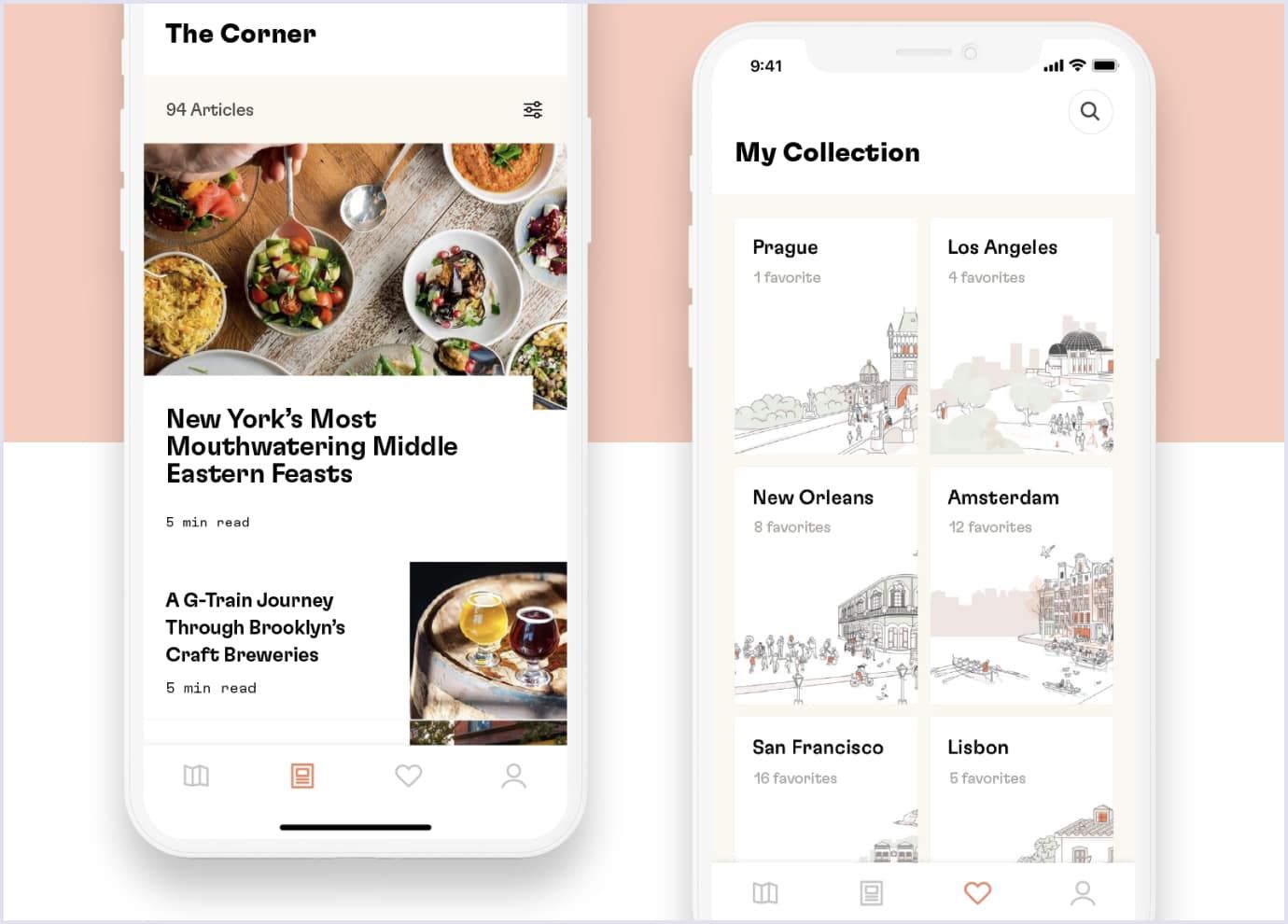
Source: Dribbble
How to build a travel website?
Travel goals and target audience.
Entering the travel market, avoid becoming an "all-in-one" expert. First, let's find out what goals travelers can pursue. Would-be travelers' roadmap tends to be driven by the following factors:
- Dates & duration of the trip;
We've decided to point them out since there's a clear causal link to the concerns of each traveler:
- Flight attributes;
- Where to stay;
- Vehicles & rental cars.

You'll be more effective when you narrow in on a defined audience. How to make a travel website attractive to a particular set of people? We have rounded up traveler profiles that instantly come to mind:
- Business tripper;
- Family vacationer;
- Friends' getaways;
- Winter ski enthusiast;
Take people's lifestyles into account when determining a marketing strategy. Now, let’s move on to revenue models commonly used on travel websites.
Platform monetization
The revenue model is tightly connected to the goals you have. Here, we’ve decided to discuss the most common tips on how to profit from a travel website.
Commission When it comes to booking, use commission fees just like brick-and-mortar travel agencies. For example, on Booking.com, the commission depends on how highly your hotel is ranked.
Listings Charge business for higher listings' visibility in searches. Also, you can offer so-called premium listings so a user will be on top of the search results. TripAdvisor, for instance, provides these tools once you claim your business page.
Transactions Build a travel website for selling tourist equipment and related stuff directly to the customers. GoTravel which we have mentioned earlier does exactly the same.
Advertising Diversify revenue by running social media campaigns, operators’ ads, and email marketing for travel agencies.
Functionality a travel website needs
As we have pointed out earlier, the travel industry covers many types of sites. Therefore, the required functionality will vary depending on your business goals. In this paragraph we want to outline the main features any travel website couldn't manage without.
Registration
Apart from the fill-all-fields process, let everybody register using Google or Facebook sign-ins.
If your site is review-based, ask newly registered businesses to provide short details on their type. Whether it is a restaurant, theme park, beach area, observation deck, shopping mall. The list goes on.
Search and filters
Allow people to find places by ratings, location, type of business, or commonly searched features as:
- Available rooms;
- Friendly-budget;
- Free cancelation;
- Parking space;
- Wheelchair accessibility;
- Breakfast included;
- Room service.
Save users' time greatly with a predictive search — a dropdown of autosuggestions that pops up once you start typing.
Reservation system
You will need a booking system that manages dates, room types, tour packages, and more. Also, create blocked-out slots for unavailable options.
A calendar built into a travel website is more user-friendly than the need to jump between pages. Let users see the upcoming months' options so they can compare tour prices. By making multiple choices visible, you provide the “best value for money” principle.
Here’s an example of a convenient search on a travel website. It’s a concept design created by Codica Team.
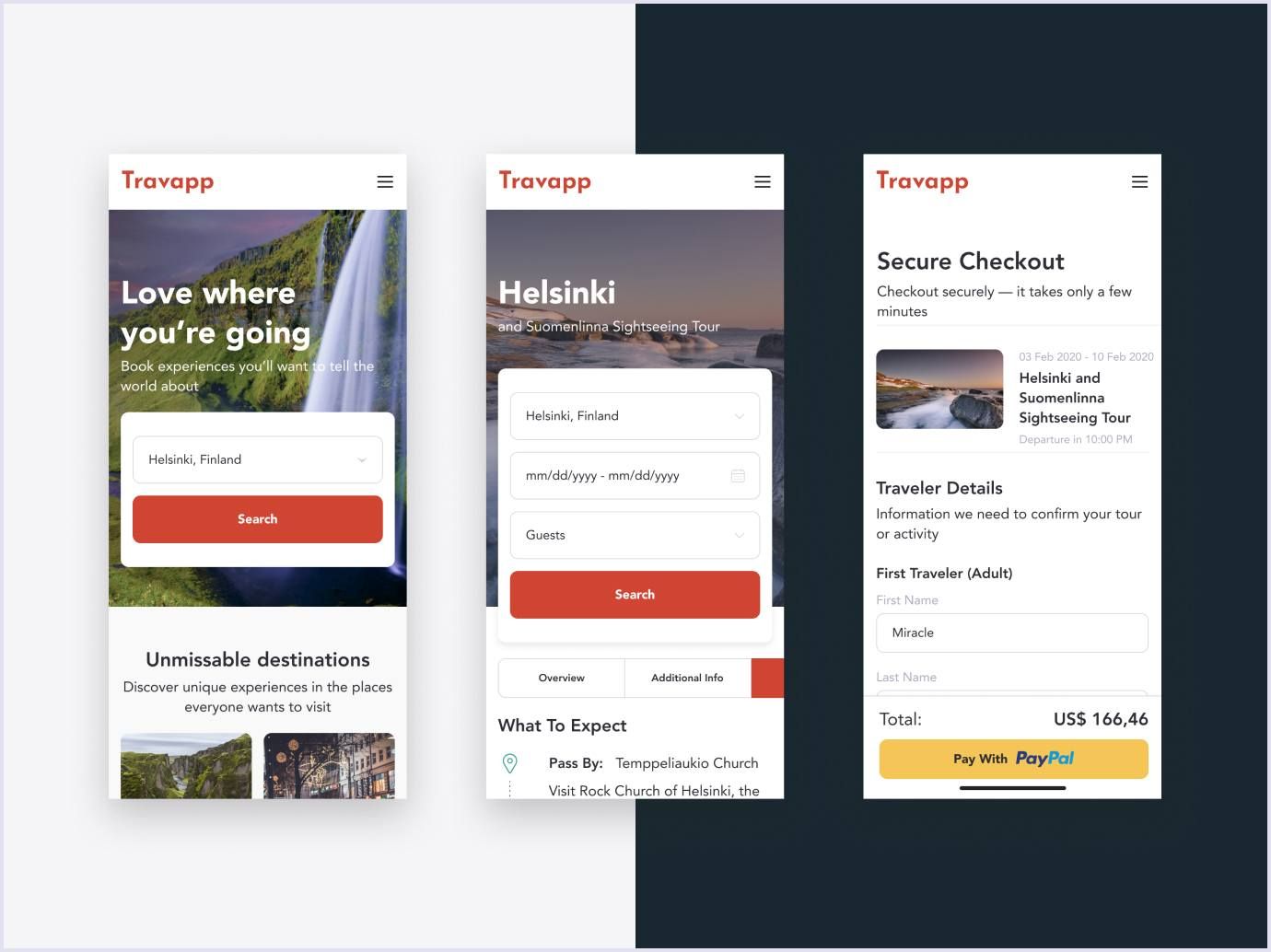
Payment gateways
Regardless of what you are selling – gear, supplies, flight tickets, souvenirs, or experiences – take care of payment gateways. For example, you can use popular ones like PayPal, Stripe, Braintree or Dwolla. Also, multi-currency acceptance makes your site much more user-friendly.
Please note that some payment solutions can be unavailable in certain countries.
Support service
Let users contact a help center by clicking the question icon or using another web element:
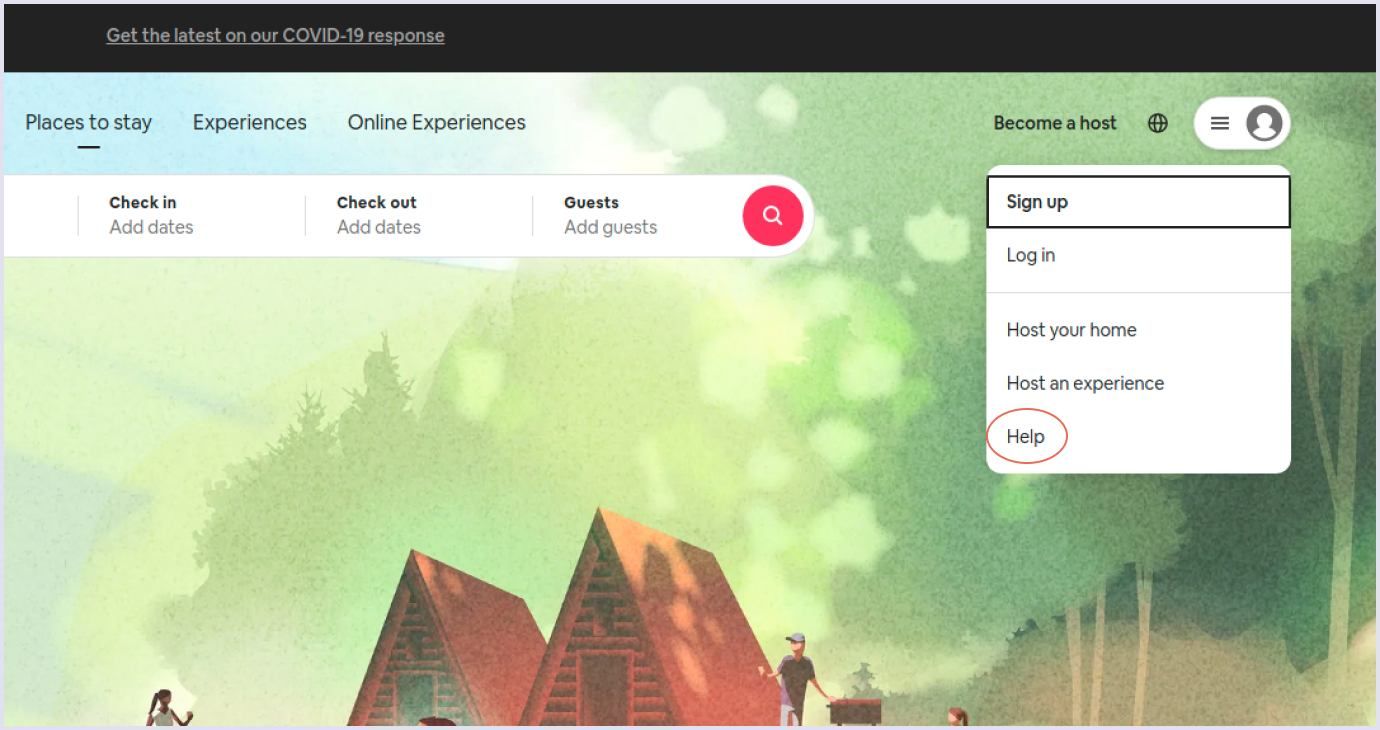
We would recommend you to make it accessible from any page. It’s for you to decide whether it will be in the dropdown menu or not. Many websites also have chat support.
Notifications
Notify registered users when booking is confirmed or canceled via email. Same thing goes for purchasing equipment and submitting any sorts of requests.
There’s more you can do with creating a progressive web app (PWA). With PWA development services , keep travelers updated on places (e.g., museums, galleries, theme parks) worth visiting. Make push notifications shown on a mobile device triggered by real-time geodata.
Just those travel websites that provide useful information stay afloat. So unbiased advice from real individuals goes a long way.
Allow travelers to share feedback or small tips within your platform. Content coming from people or entities clearly affiliated with a business should be removed. Also, consider adding several editorial features to reviewing system:
- Headline & subheadline;
- Font styles: bold , italic , underline ;
- A YouTube, Vimeo, or another video link preview of user’s journey;
- Caption for attached photos.

A user will need functionality for accurate mapping of their walking and drive tours. Allow your website visitors to find relevant places by selecting distance range or entering a location.
Provide a fast preview with name, activities available, prices, and several photos of the traveler’s destination.
Mobile version
How to make a travel website feel like a native mobile app? Build a PWA. Simple as that.
Apart from push notifications, mobile-first approach guarantees you several other benefits:
- Fast-loading pages;
- Higher placement in Google search;
- Pre-caching that enables offline mode;
- Cross-browser compatibility.

Travel website design tips
It’s hard to find a template or a one-size-fits-all approach to make your own travel website. Select design elements appealing to a specific set of people instead. Once again, don't try to cater to everyone.
Homepage search widget
Don't overload the homepage. Your site visitors are not going to solve puzzles. Especially when almost half of today's search queries fall on compact mobile devices.
Help users find what they need in a matter of seconds. Give them instant access to the search bar with minimum filtering. Here’s an example of a slick UI/UX design followed by Kiwi :

Image that message
Travelers expect to see real and high-quality photos. So keep your site imagery "clean," avoiding pre-made effects.
A picture, in your case, should be worth a thousand words. Make it obvious . Give travelers a real depiction of their destination.
Airbnb’s pages show how big an impact of photo strategy is:
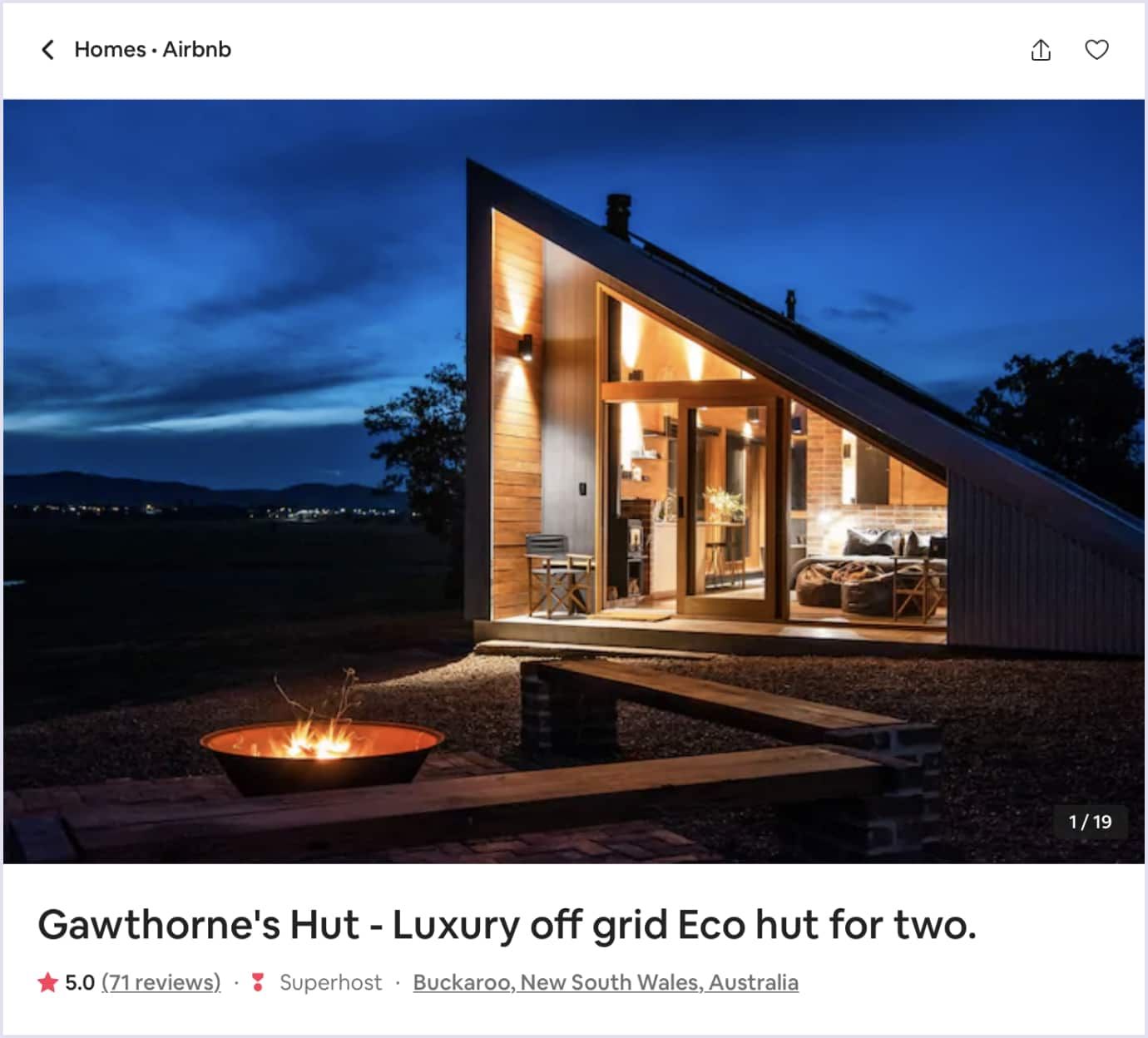
Details out in the open
Let’s briefly discuss how to create a travel website that is easy to navigate.
Leave several click-to-action accessible from any page. Show tours availability. Flag whether a hotel offers free cancellations. Display the information on mask requirements, additional pandemic-related measures, and more.
Here’s one of many examples of how to manage a tour booking page:
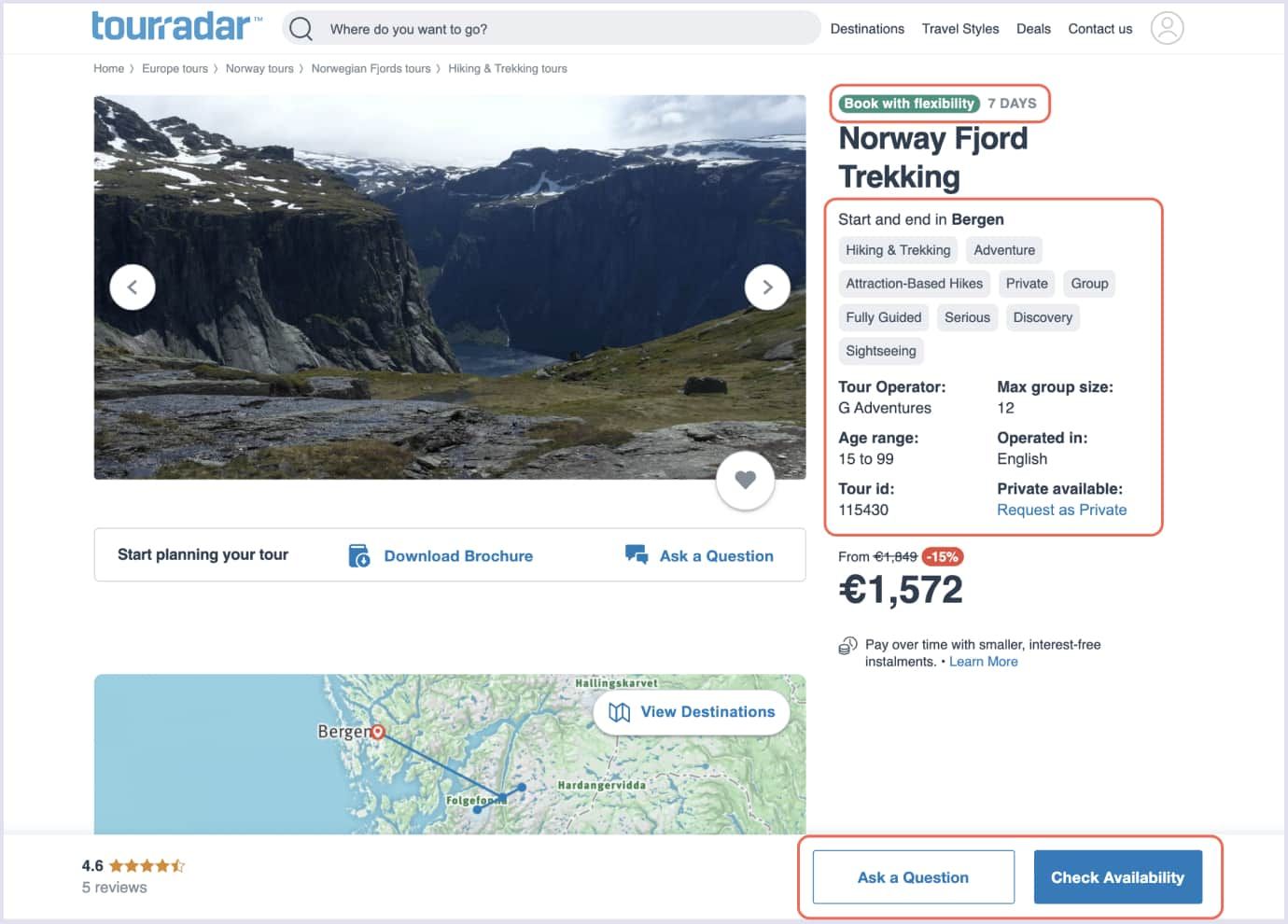
Additionally, include your contact details or “Ask a Question” button in a highly visible area. Also, your email should be hyperlinked to launch instantly.
Convenience in use
Many people tend to use only a few functions — especially those who favor small screen devices. If your site overdoses on dropdown menus, visitors may leave it in favor of a simpler one. So point out widely-used content instead.
A person may want to search for a hotel room and book the most suitable option. Therefore, most required functionality should be in the navigation bar. For additional information that does not fit into it, use the dropdown menu.
Speaking of booking, there's a common mistake you can see all over the Internet. Some developers avoid displaying more than one calendar month on the same page. Let’s say you’d like to check in on Wednesday 2 September:
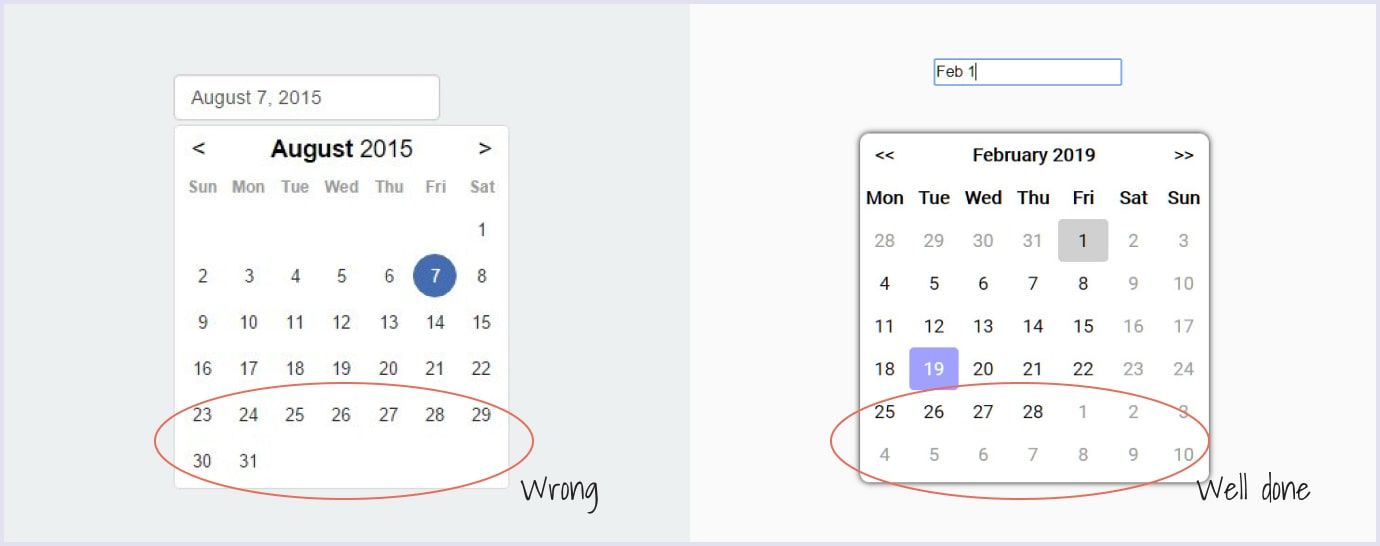
The left calendar forces you to scroll through to the next month. The other one on the right has no such problem. It comes surprisingly handy when you'd like to see trip duration as a continuous line.
Choose a travel website development approach
When deciding on whether to make your own travel website, consider two aspects that influence the development cost:
- The approach: out-of-box vs. custom development.
- The functionality you select.
Let’s look closely at the core benefits of both using a ready-made solution, and building a custom website with a software development company.
Out-of-the-box solution
Ready-made software allows you to start a platform in no time. This way, you reduce many costs, if compared to a travel website development from scratch. There's no need to maintain the platform and deal with security issues, either.
There are plenty of SaaS solutions providing subscriptions adjustable to the company’s growing needs. For example, SiteMinder offers ready-to-install software designed to run a hotel website:
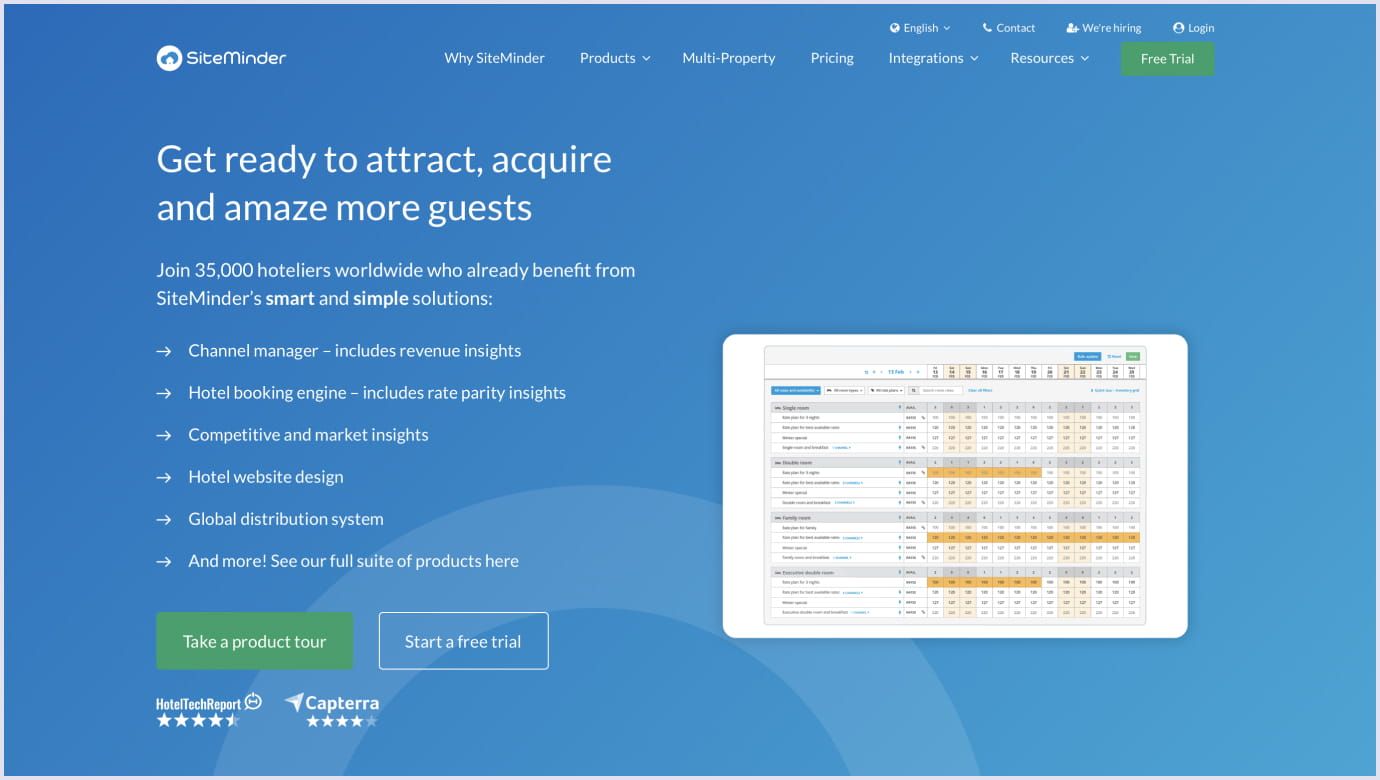
However, as we said, you will not find any one-size-fits-all web elements out there. It is a turning point since travel website design plays a major role.
Custom travel website
On the contrary, you can make your own travel website 100% reflect your voice or brand identity . So what may be started as a vision of pulling up various ideas will end up as a unique product.
Partnership with a dev team guarantees vast experience and profound knowledge of the latest programming trends. And make no mistake, your project will be complete with the right tech stack, considering all the requirements.
How to build a travel website with up-to-date technologies? At Codica, we favor the best programming solutions like Ruby and Ruby on Rails. We also firmly believe, first things first, you should get the minimum valuable product (MVP). Let us explain importance of using MVP development services :
Fast rollout Collect first feedback and make subtotals for your project’s course correction. After doing so, you extend starting features and try the rest.
Attraction from investors MVP helps to demonstrate to investors the seriousness of your intent.
Website promotion Get everybody to know about your startup by increasing traffic from the outset.
Take a look at the projects that our team successfully delivered for clients from around the world.
How can Codica help with building a travel website?
Since 2015, Codica team has been delivering high-quality web products for multiple industries. Our solutions are designed to bring a great amount of traffic, conversions, and sales. And it's all thanks to our Agile mindset and a full-cycle development team presented by:
- UX/UI designers;
- Project managers;
- Software developers;
- DevOps engineers;
- QA engineers.
First, we build clickable prototypes for the future MVP based on your goals and audience. It guarantees a predefined time frame and budget.
Then our software engineers approach MVP development. Sticking with the latest programming trends, we provide you with a maintainable and highly secure solution.
Once the end product is rolled out, Codica’s experts will be analyzing its status regularly. If there is any issue, we will fix it shortly.
Case study: Travel management platform
We couldn't resist the chance to show you a travel website we created for one of our customers. This project is a management platform for those looking for more than a typical “bucket list” destination.
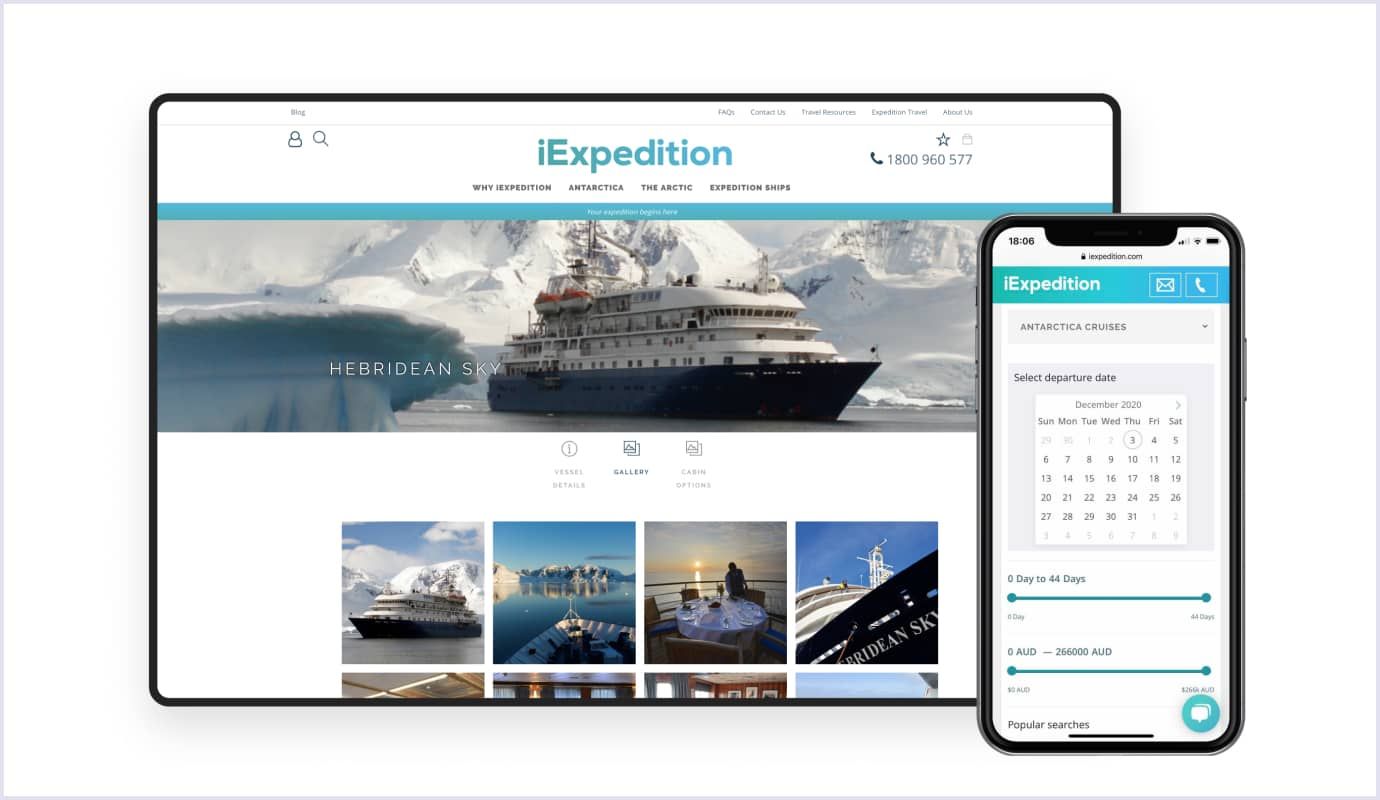
This is an online travel marketplace for IExpedition , an Australia-based travel agency providing Arctic and Antarctic journeys.
The customer wanted us to create a convenient booking website. We built a marketplace that brings a mix of polar expeditions from a huge amount of vessel options ranging in size, and across 1,000 departures.
With IExpedition, you manage your chosen trip to the polar region. There are options for both shoestring-budget and five-star travel styles. Functionality and content include a cruise booking system and the essential checklist for travel preparation.

Seeing new places, getting to know other cultures, or simply running from everyday life — nothing compares with that. Is there anything nowadays, apart from a few clicks, that stands in between you and your dream trip?
Over the past years, travel websites skyrocketed as many tourists look for unique and more exciting journeys. There are a bunch of features that could make your website special. Importantly, users should easily be able to witness them. Hiring a development agency filled with experts is the most efficient way to achieve it.
A quick glance back proves Codica's ability to create custom software that meets the highest web standards. If you have the idea of building a travel website and need a reliable team to help you, don’t hesitate to contact us .
Frequently Asked Questions
There are no comments yet
Related posts

Want to receive more content like this?
Nobody likes popups, so we waited until now to recommend our newsletter, a curated periodical featuring thoughts, opinions, and tools for building a better digital world.
Don’t wait and suscribe now!
Latest posts.


Download WP Travel
Please enter your email to download WP Travel and also get amazing WP Travel offers and Newsletters.
How to Create a Travel Website like Expedia? (In-Depth Guide)
Home » Blog » How to Create a Travel Website like Expedia? (In-Depth Guide)
So, are you looking forward to creating a travel website like Expedia?
Creating a website like Expedia is a dream for many entrepreneurs.
But what do you think? How many of them can make it true in real life?
A few, of course.
But, what if I told you, can create a travel website like Expedia within minutes without coding and start making money?
As it is not that easy and not that hard as well that you can’t make it.
All you need is proper planning and proper guidelines are all you need.
But, before that, you need to know all things about Expedia.
For that reason, we have decided to help you with every possible way to create a website like Expedia using the best WordPress Travel Booking Plugin .
Table of contents
What is expedia and what it does, 1. select a platform for your travel site, 2. domain name selection, 3. choose your hosting service, 4. install a theme for your site, 5. plugin installation for your site, 6. provide online payment facilities to your users, how expedia is so cheap, start your website like expedia.
When you decide to create a website on the business model of Expedia then you can call your site is a website like Expedia.
But, do you have any idea what is the business model of Expedia? If not, then don’t stop reading.
Expedia mainly focuses on the merchant business model.
Because they earn their 60%+ revenue by this model.
In this model, they buy rooms, air flights, car services in bulk quantity.
As a result, they can buy these services at a cheap price.
then, combine these services to provide a total trip package that will offer their customers all services at a time at a cheap price.
For example, Expedia bought 100 rooms from a hotel and it cost only $60 each instead of $90.
After that, they have contacted the airlines then offer them to sell airline seat for $700 instead of $900.
Now, they offer a trip package for $1660 that is offered to two customers.
As a result, their customers can save $200 by doing booking on their site.
Moreover, Expedia can earn $200 on each booking. Furthermore, Expedia can return to the hotels within a given time period.
You have to build your business on this model if you want to create a website like Expedia.
This is how you can start a site or business like Expedia.
How to Create Your Travel Website Like Expedia?
If you don’t have better guidelines, you can never create a website like Expedia.
Creating a website has been made easy with the help of the best online travel booking system .
But you need to follow some steps if you want to have an outstanding website.
How about we show some images of your future website that you are going to get if you follow our following steps?
Sounds great, isn’t it? Let’s take a look at your future website.

Now, are you excited? If yes then, don’t stop reading. We are going to give you six very easy guidelines.
By following these guidelines you will get the answer to how to build a travel platform. Follow the following six easy steps to create a website like Expedia:
Don’t go for a random platform. There are lots of CMS(Content Management System) available.
But, some can be good for your site and some might look good but that can cause harm in the future.
So, do lots of research on the available content management system.
But, it might get hard and confusing for you. Because of it, we have decided to share our suggestion with you.

WordPress.org is the number one used and popular CMS right now and it has a 100% possibility to be in the first position in the future.
As it is updating continuously for its users. Besides, it provides thousands of free themes and plugins for your site.
Your life will get short for trying out these plugins and themes. It provides other advantages also.
Check out the following advantages of WordPress.org:
- It is a 100% customizable, SEO-friendly, and mobile responsive content management system.
- This CMS will provide you translation-ready site.
- You can make your site with thousands of available WordPress plugins and themes.
- By using this CMS, you will have full control over your data.
- Also, get 100% support for your problem.
- No need to worry about your coding skills.
- Get unlimited hosting space by using this CMS.
You can get thousands of reasons to use it but will not get one reason to not use it.
Big sites use this platform to make their site. Sometimes, other CMS seems less expensive but this illusion will break after using those for few months.
For more information learn : why you should create a travel site using WordPress ?
You should give more thought to choosing a domain name for your website.
As people will use this to search for you.
It is wise to select a domain name that will resemble your site’s service.
A random domain name can be harmful to your site.
Keep your domain name by following below points:
- Keep that domain name by that people get the idea of your service.
- Use a specific, short, easy domain name.
- Don’t use hyphens and numbers in your domain name.
Here is the perfect strategy to implement while choosing great domain name ➤➤➤
The top hosting service providers are Bluehost, HostGator, Hostinger, etc.
You can choose a host from these according to your budget and the services they provide.
If you use Bluehost, you can get your WordPress account with one click. that’s really great.
Here is the perfect strategy to implement while choosing great web-hosting ➤➤➤
Though WordPress provides a default theme, you need to install one.
Because the service of the default theme is not that good.
So, you need to choose a theme that will change the appearance of your site and also will go with your business.
Luckily, you can find lots of the best WordPress travel themes .
As a result, it will be frustrating for you to try all the travel booking themes. So, We have created a list of the 15 best WordPress themes for your site .
We are using the tourable theme for creating a site.
You can use any. But, don’t use a random theme for your site.
For that, you check the above link. For installing, go to your dashboard then appearance>> theme .

Then, press the add new button.

Search for tourable or other themes in the search box.

Finally, install and activate the theme to create a website like Expedia.

Adding functionalities to your site gets easier with the plugin.
Before, when heard about website changes, the first thought that would appear is coding.
But, the plugins of WordPress change the full concept.
You don’t need a minimum knowledge for it. Surely, you can go for any plugin.
But I will suggest you take the recommended plugins that are mentioned on the top of your screen.
Here is the step by step video tutorial to create travel website ➤➤➤

Add new plugin >> WP Travel >> and activate it
For that, press begin installing plugins.

Choose the install for bulk option and apply it for installation.

Now, choose your required plugins and select activate for bulk action. Then click on the apply button.

For further customization, press the Customize your site button.

After that, customize the following section of your site.

Update the booking , coupon , trip extras , enquires, downloads, and custom filters of your site.

Again, make changes in the following areas as well. After that, press save setting.

Add all information on the trip section.

Now, you will get a great site that we have shown above.
For more information check the documentation of WP Travel.
Your all work will be meaningless if you don’t include it.
You can add different payment systems to your site if you use a user of WP Travel Pro . So, choose your plugin of the site carefully.
Because a good plugin can reduce lots of works that you will be facing while using other plugins.

Expedia buys hotel, air flights, and other services in bulk.
For buying services in bulk quantity they manage to get it at less prices.
After that, they combine whole services that customers need for a trip then offer them to the customers at less prices.
Customers will have to spend more money if they buy every service individually.
Like hotel rooms, air flights, vehicles, etc.
As a result, customers found it a great deal as they are getting all services at less price and they don’t have to bother about managing other services.
After reading this blog, you will have the idea about how to start your own website like Expedia.
Now, all you will need is gathering the courage of creating one using the top tour operator software .
During doing this, don’t forget to choose right platform, theme, and plugins that are mentioned above. For more help, do inform us in the comment section.
Also, if you liked this article, then subscribing to our YouTube Channel for WordPress video tutorials would be the cherry on top.
You can also find us on Facebook , Instagram, Linkedin , TikTok , Pinterest , Reddit , and our dedicated engaging Facebook user community , for you everyone.
Further, if you have any queries, please submit them to our Contact page .
Get WP Travel Pro and start creating your travel and tour booking website within minutes without any hassle of coding.

Yam Bahadur Chhetri is a content writer and vivid contributor to the WordPress community and a WordPress enthusiast with an experience of 7+ years in the relative field. He also loves to develop WordPress Themes, Plugins, and custom WordPress development for clients.
Leave a Reply Cancel reply
Your email address will not be published. Required fields are marked *
Save my name, email, and website in this browser for the next time I comment.
- Join 6000+ WP Travel Users Community Subscribe the newsletter to get new offers, discounts, and product updates frequently.

Get WP Travel Pro
Create Stunning , SEO friendly and Fully functional Travel website within minutes . No Coding Required !
Suitable for any
- Travel Agency
- Tour Booking Services
- Travel Bloggers
Drive more Sales and Revenues from today !
$ 99 99 USD per year

📢 Santa has sent the gift for Christmas and New Year sales on all WP Travel Pro plans. 🛍️ Use coupon code "XMAS_NEWYEAR2024" at checkout.
Related posts

How to Disable Automatic Updates in WordPress?

WP Travel Engine Alternatives 2024 (Top 9)

How to Make a Travel Website? (The step-by-step guide)
Wp travel modules.
Need more features to save your time and to boost your travel business? WP Travel Pro comes with more powerful modules . While our core travel plugin provides almost all the features that a travel and trekking websites generally needs, our add-ons boost it’s capacity further to make it the best travel engine on WordPress. Whether you want to add new payment method to your site or brush up your trekking listings with beautiful maps show casing your trips, we have all your imagination covered. See all our add ons below to boost your travel website’s features further.

Weather Forecast

Import Export

Partial Payment
Connect with wp travel to join the travel conversation, documentation →.
Explore More
Customer Support →
We are here to help.
Facebook Group →
User Community Forum
Follow On Twitter →
Connect with us on Twitter
ColorWhistle
Digital Web Design Agency India

Explore our Market-Fit Services
We ensure to establish websites with the latest trends as we believe that, products whose value satisfies the needs of the market and its potential customers can be efficiently successful.
Quick Links
- About Us – ColorWhistle
- Engagement Models
- Testimonials
- Case Studies
- Agency Services
- Web Development
- Web App Development
- Digital Marketing
- Travel Website Development Services Company
- Real Estate Website Development Services Company
- Education Website Development Services Company
- Healthcare Website Development Services Company
- Hotel and Restaurant Website Development Services
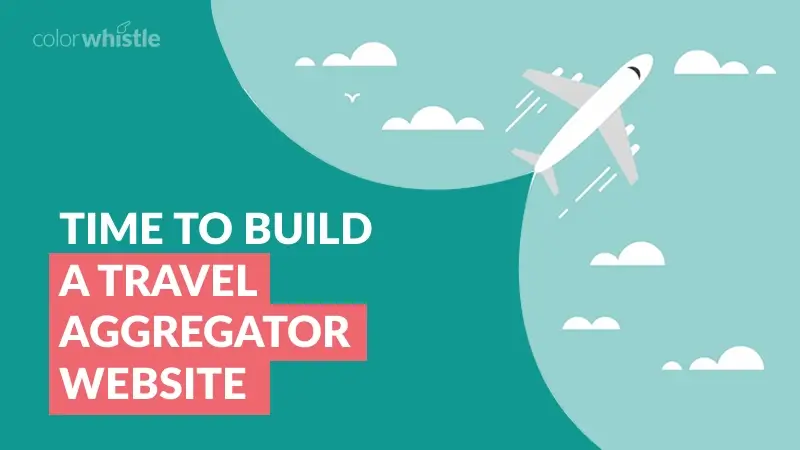
Category: Travel
Date: August 30, 2023
Travel Aggregator Website Complete Guide
When it comes to starting a travel business online, the easiest one would be to start a travel aggregator website and generate revenue through affiliate sales or contextual advertising. To capitalize on this lucrative business opportunity, let’s take a look at how to build one.
What is a Travel Aggregator Website?
A travel aggregator website is one that searches for deals across multiple websites and shows you the results in one place. For example, if you want to find a cheap flight from Dubai to New York City, you check American Airways or just head down to an aggregator website and check for hundreds of airlines at once to select the cheapest.
Best Travel Aggregator Website Examples
Here are some of the top aggregator websites.
1. Skyscanner

Skyscanner always gives you the cheapest price on flights. An amazing feature of this website is that you can look at flights for an entire month to find which date is the cheapest. You can also search from ‘my location’ to ‘everywhere’ to see where you can fly inexpensively.

Adioso is a simple search engine that has nifty features than Skyscanner. From your current location, you can search for flights to somewhere warm” or “a budget city” or “a local festival” depending on your mood.
3. Google Flights
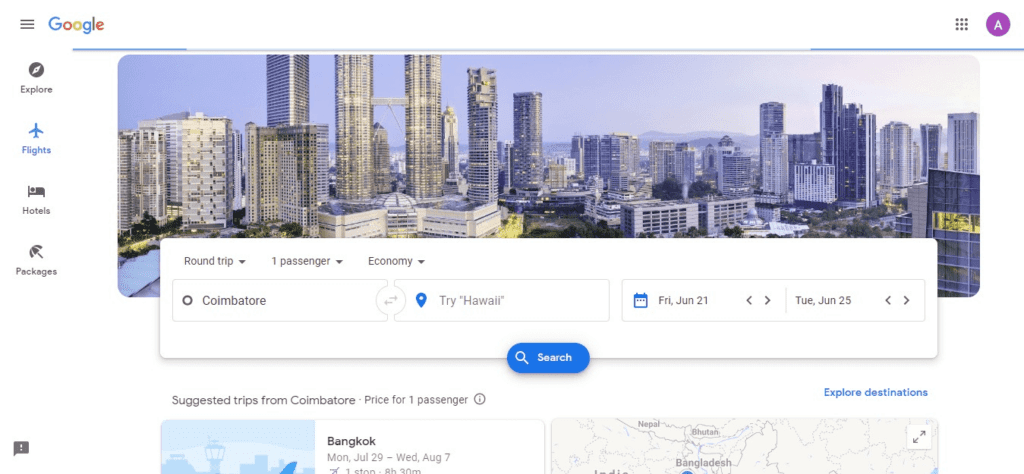
Google Flights is easy to use and comes with cool mapping features. It occasionally shows cheaper flights than Skyscanner or Adioso. So if you’re not happy with the deals, you can head to Google Flights to see if it offers you a better price.
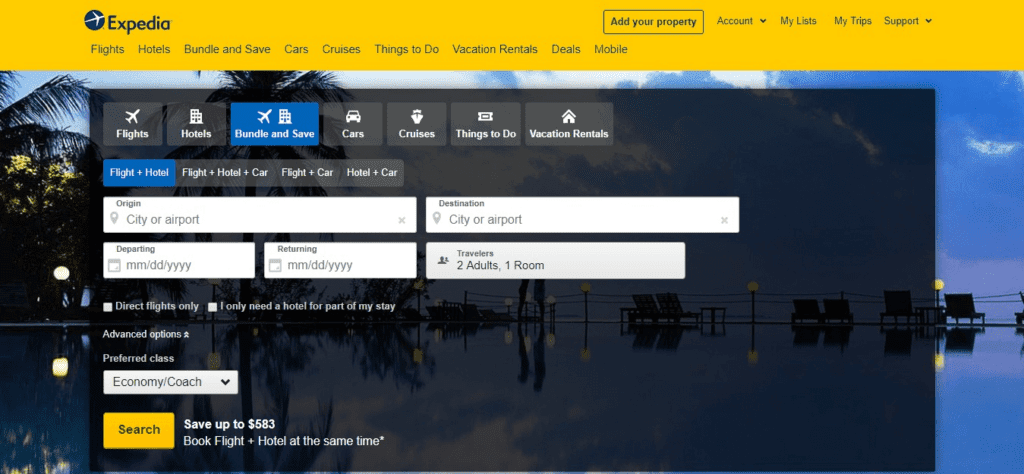
Expedia is an online travel website that allows you to book flights, vacation packages, hotels, cars, and cruises. An important feature of this website is the vast and expansive coverage of every airline and hotel chain.
How Do Travel Aggregator Websites Like Expedia Work and How do They Make Money?
Websites like Expedia collects and aggregates data from thousands of travel service providers . Then, they develop their own travel agency app and website for customers to compare travel options.
Most of these websites gain more than 70% of its revenue from hotel reservations. To achieve this, they simply buy a large number of hotel rooms at a discount and advertise it on their website.
For example, if Expedia wants to offer a 10-day vacation package to Thailand with all-inclusions for two people for $1,700. First, it will contact a hotel in Thailand and buy 100 rooms for $50 instead of the actual price of $90.
Next, Expedia will contact an airline and reserve 200 seats to Thailand for $600 (at a discounted price). Plus, it will also provide food for the entire trip which will cost somewhere around $250 for two people.
People who buy this package will be happy because they got a good deal for an all-inclusive package. Expedia is also happy because they actually paid $1,550 for the package and sold it for $1,700 to 100 couples.
Another source of revenue is commission.
For example, a hotel will offer 10 rooms to Expedia for online reservation. If the hotel offers $100/room to Expedia and if a guest books the room, Expedia will pay $75 to the hotel and withhold $25 as commission.
How Do Travel Aggregator Websites Like Expedia Source Their Inventory?
Most of the companies source their inventory by directly negotiating with hotels and global distribution systems (GDS) such as Amadeus , Galileo , Sabre and Worldspan .
Note – GDS integration is only available for licensed travel agents that are ARC (Airlines Reporting Corporation) or BSP ( billing and settlement plan) accredited.
The history of GDS dates back to 1960s where a sophisticated method to keep track of flight schedules, availability and prices were needed.
However, some say that GDS can be expensive to access. Agencies use this as a last resort if they run out of inventory in a given city. If an agency directly buys rooms from a hotel, they can get 20-25% of profit, whereas with GDS it can go up to only 15%.
Building a Travel Aggregator Website
To build a travel aggregator website, you need the following:
- CMS that can act as a framework for your website
- Good front-end to match the aesthetics
- An engine to get data from APIs provided by other travel websites
Apart from these, you can also build the website from scratch or use readily available scripts. Let’s explore all the possible options.
1. Build From Scratch
The robustness of a web application will be at its best if its build from scratch. This method will give you more room to incorporate your ideas efficiently. The only downside of this method is hiring a travel website development company to create a solution from scratch is definitely going to cost you time and money. However, if you greatly value flexibility, you must take this route.
2. Build with WordPress
WordPress can be used to create any type of website. You can either install plugins available in the WordPress directory or create a custom plugin to give the website additional capabilities. When compared to building a website from scratch, the cost and development time is comparatively less. So in case of WordPress, all you need to build a functional travel website is a readymade theme or custom themes and plugin
3. Travel Engines
You can use web scripts or online booking engines to build a travel portal. These scripts will take care of all the key aspects of a travel website. Plus, these scripts also come with features such as booking engine, billing and invoicing system, module-based functions and more to fit your requirements.
Some of the famous online booking engines are:
- TravelCarma
4. Aggregating Data
Once you have built your travel aggregator website, you have to connect it with the data feeds. It will ensure access to travel data from hotels, flight companies, etc. Some of the popular ways of aggregating data are:
FREE API’s
Leading travel search engines have affiliate programs where they give free access to their APIs. This will solve the common challenges in one shot – data aggregation and revenue generation. Some of the popular affiliate programs are:
- Skyscanner affiliate program
- Expedia affiliate network
- Kayak affiliate program
WEB SCRAPPING SERVICES
Not every travel website will provide an API. Apart from that, the APIs you get may not have data fields that are necessary for your business. In such situations, you can get help from web crawling services that can be connected to your database to turn unstructured data into structured data. Building your own web crawling setup is not a viable solution, you can rely on service providers like ScrapeHero , Promptcloud , etc.
Drive Conversions and Boost your Business with Expert Travel Website Development.
Start crafting a travel aggregator website.
In recent years, as far as online businesses are concerned, travel is by far one of the most profitable niches. Millions of people are keen to explore the world owing to the ease of booking international flights, buses, hotels, car rentals and more.
Creating a travel aggregator website is not that complicated. It depends on what features you plan to offer, whether you want to include original content and a slew of other factors. But with the basics in this blog, you can set up a website that people will appreciate.
If you are ready to get started or have any questions, feel free to get in touch . No matter a simple or complex project, our team will help you in every step of the way.
Build A Travel Aggregator Website like Expedia?
Get A Free Proposal Now !
In quest of the Perfect Travel Tech Solutions Buddy?
Be unrestricted to click the other trendy writes under this title that suits your needs the best!
- Best Travel Websites Inspiration
- Travel Website Features
- Top WordPress Travel Website Themes
- Vacation Rental Booking Sites vs Traditional Accommodation
- Popular Travel Websites Tech Stack
- Tour Operator Software
- Online Travel Business Models
Related Posts
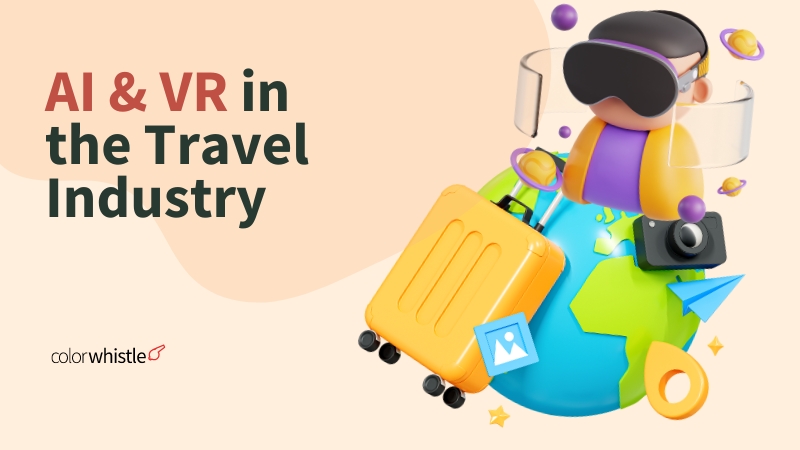
Exploring the World Through AI and VR in the Travel Industry

How AI-based Travel Booking Applications Can be Developed?

Latest Marketing Trends for Travel Businesses in This New Year
About the Author - Anjana
Anjana is a full-time Copywriter at ColorWhistle managing content-related projects. She writes about website technologies, digital marketing, and industries such as travel. Plus, she has an unhealthy addiction towards online marketing, watching crime shows, and chocolates.
View Our Services
Have an idea? Request a quote
Share This Blog
Thank you for publishing in your blog, I have learned of valuable information keep many post blogging like that
It’s a great blog. but the drawback here is that it can be very time consuming, as with multiple airlines being showcased, finding a cheaper one can be a tiresome task.
Leave a Reply Cancel reply
Your email address will not be published. Required fields are marked *
Ready to get started?
Let’s craft your next digital story

Sure thing, leave us your details and one of our representatives will be happy to call you back!
Eg: John Doe
Eg: United States
Eg: [email protected]
More the details, speeder the process :)
How To Build An Expedia Clone Without Code
Learn how to create your own no-code Expedia clone, using Bubble's visual web editor.
Lachlan Kirkwood
Lachlan is a digital marketing specialist and passionate no-code maker.
More posts by Lachlan Kirkwood.

Planning a holiday can be an arduous task. With a plethora of options between flights, accommodation, and tours, it’s hard to know where to even begin.
Building software, on the other hand, shouldn't have be a strenuous process. Yet often, makers without web development experience need to outsource to expensive dev teams and wait months before shipping anything tangible.
With the rise of no-code tools like Bubble , however, makers from all backgrounds can start building their own software, all without writing a single line of code. Bubble’s powerful platform has made it easier than ever to get started on your development journey. Our customers use Bubble to build websites, directories, and even social networks.
Throughout this post, we’ll walk through the process of using Bubble to build your own no-code travel booking site, similar to Expedia or Skyscanner . We’ll share a step-by-step guide to building the underlying logic for your no-code Expedia MVP in just a matter of minutes.
For the sake of our MVP, we’ll focus on building a product specifically for booking flights. If you’d like to add additional support for hotels, rental cars, and tours, you can easily replicate the core framework to cater to your specific needs.
The steps to building Expedia with no code include:
Get Started
Before you start, you’ll need to first register your free Bubble account. Click the button below to get started, then you can follow along as we build our app together.
Register your account on Bubble
New to Bubble? Follow along on our Crash Course introductory videos to get familiar with the basics of Bubble.
We also recommend completing our introductory lessons , which will guide you through the step-by-step process of the most common Bubble features. This will help you get a running start when building your Expedia clone.
It’ll also be beneficial if you understand how to create and edit user accounts . We’ve previously covered this in more detail in our How to Build Quora article .
When kickstarting your project, you can choose to begin by wireframing your product design, or building the necessary fields within your database.
In this case, we’ll start by using Bubble’s visual design tool to shape the user-interface of our product. When building your own travel booking platform, some of the core pages you’ll want to include are:
- An admin portal - Used as a backend for adding flights to your database
- Home page - Including multiple search fields and a function to display search results
- Flights page - A dedicated page to display the full details of a selected flight. This page will also include your checkout function
A major feature within Bubble is the ability to send data between pages . This allows you to create one generic version of a page, then dynamically display the relevant content from your database when it’s required.
In the case of your Expedia clone, you’ll only need to create one page to host your individual flights. We can then write the necessary logic to display only the relevant flight details on each page (we’ll cover this in more detail soon).
Configuring your database
Once you’ve mapped out the display of your product, you can focus on creating the necessary data fields to power your application. We’ll rely on these fields to connect the workflows behind your product.
Bubble’s pre-built database makes it easy to create different data types with unique fields. When building the MVP for a flight booking platform, we’ll need to create the following data types & fields:
Data type: Flights
- Departure location
- Destination location
- Flight number
- Departure date
- Arrival date
- Flight duration
- Flight distance

Data type: User
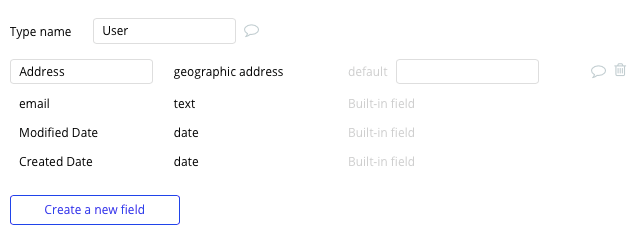
Building workflows
Now that you’ve structured both the design and database for your application, it’s time to start stitching everything together - making your product functional.
In Bubble, the main way to do this is with “workflows”. Each workflow happens when an “event” occurs (e.g. a user clicks on a button), and then runs a series of “actions” in response (e.g. “sign the user up”, “make a change to the database”, etc.)
Adding flights
When adding new flights to your platform, it’s possible to manually add new entries within your database. If you’re managing the platform between multiple admins, we’d recommend creating a dedicated portal to easily facilitate this process.
On the create flights page, you can start building this process by using a combination of input fields, including; free-text fields, image uploaders, dropdown selections, or multiple selection fields.
Once an admin has added the relevant details within each input, they’ll click the create button to trigger a new entry in your database. This button click will be the necessary action to create your workflow.

Using the workflow editor, you can select to create a new thing within your database. In this instance, we’ll be creating a new event .
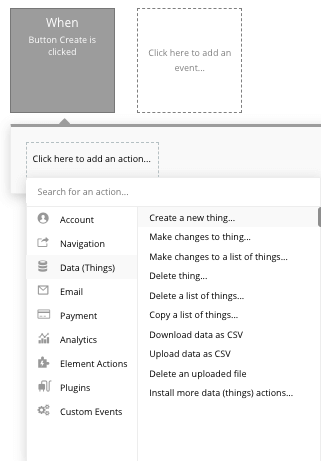
You’ll then need to start adding data into the relevant fields within your database. Map each input field you’d like to create against its corresponding data field.

Creating a search function
Once you’ve started adding flights to your platform, it’s time to start building the rest of the product that your users will interact with.
One of the core features of Expedia or any travel booking site is the ability for users to search for flights based on their specific requirements. This can include their departure location, destination, preferred dates of travel, and more.
On the home page, we’ll use an aggregation of different elements to support these search functions.
In the case of our MVP, we’ll start using the search box and date/time picker elements to map out our page UI.

You’ll then need to configure your search elements to only display items from your database that are relevant to each field. Take the time to configure the datasource to the flights within your database, then update the specific search field to include either the departure location or destination location .
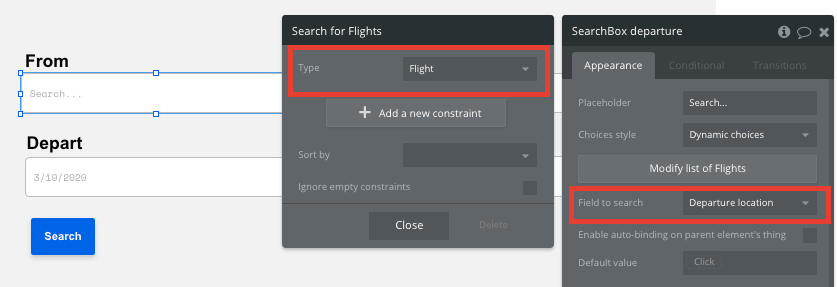
By structuring these search fields, the element will now index all of the existing entries within your database and even offer search suggestions as they’re typed.
Display dynamic search results
Once a user enters their desired flight parameters, we’ll need to display a list of all the relevant flights within our database.
Using Bubble, there’s a myriad of ways to do this - including using pop-up elements, or even redirecting users to a new page and sending relevant data.
For our MVP, we’ll just be adding a repeating group element below the search bar.

Repeating groups integrate with your database to display a list of dynamic content.
When using a repeating group, you’ll need to first link the element to a data type within your database. We’ll be classifying our repeating group from the flight data source.
By adding additional constraints to our data source, we can filter the repeating groups content to fetch only the relevant results based on each of your users search parameters.
You can also add additional constraints with your search and date fields.
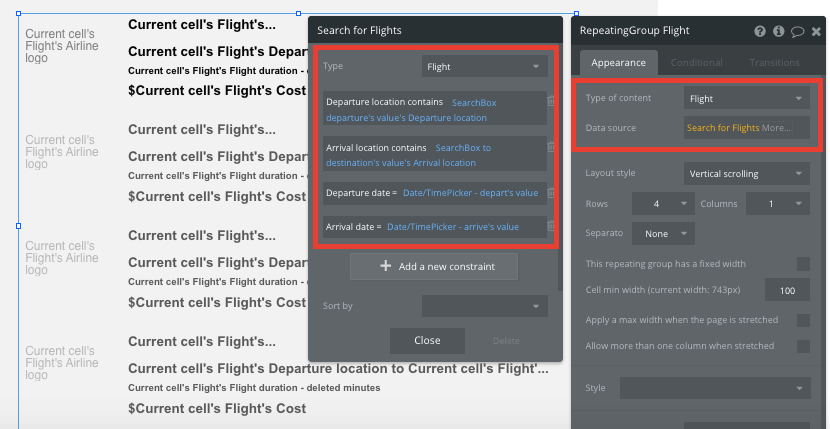
Under the current constraints, our repeating group will dynamically update each time an elements field is changed.
If you’d like the grid to only fetch the relevant results once a user finishes filling in all of the search fields, we can select to hide this element on our page load . You can achieve this by unchecking the display element on page load configuration.
As this element will be hidden by default, it will only become visible once we create a workflow to facilitate this function.
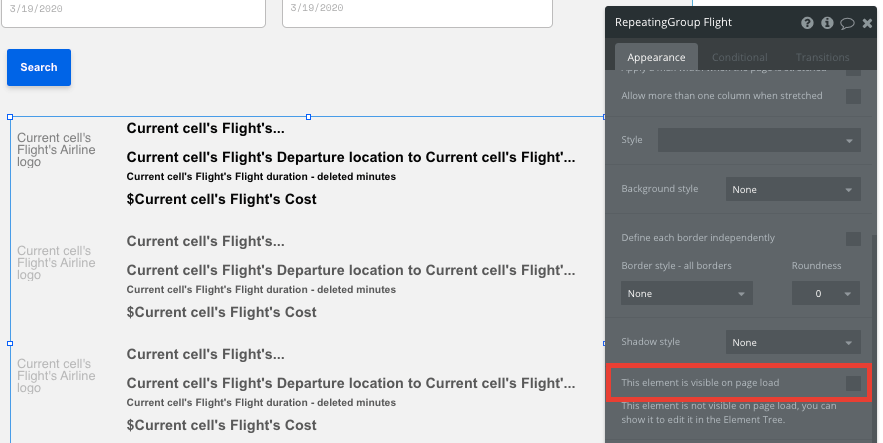
As you may have guessed, this workflow will be based on the search button we added below our search fields.
Start by selecting the search button, then selecting to create/edit workflow .

Within your workflow editor, you’ll choose from the element actions , then show an element when the search button is clicked .
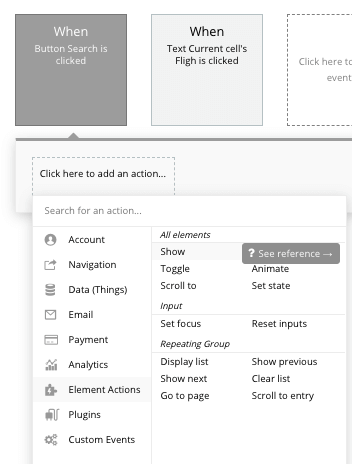
The element we’ll need to show is, of course, your repeating group.

Now your repeating group will only display the relevant results once a user submits their full query.
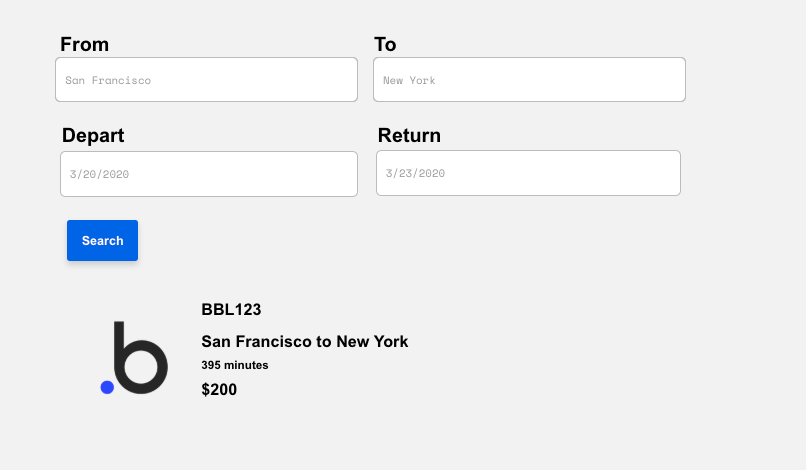
The last thing you’ll need to do is structure the dynamic content that will display within each grid. Simply map out the top column with the relevant content you’d like to show, then this powerful element will populate the remaining columns based on your existing data.

Sending data between page navigations
Within a repeating group, it’s also possible to create events based on each individual row.
This feature will become useful when building navigational features across your platform. As our repeating group only displays a topline view of each flights details, we’ll need to display the full list of information on a separate page once a user clicks-through.
This additional content will need to be hosted on your flight page .
To achieve this event, start by creating a workflow that redirects a user to your flight page when one of the elements within your repeating group cell is clicked.
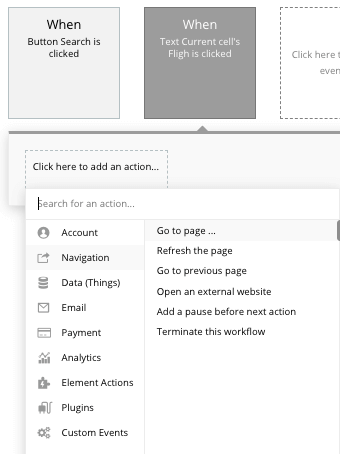
When creating this workflow, use a navigation event to send a user to another page. From here, select the destination page to be the flight page .
You’ll then need to send additional data to this page so the Bubble editor knows which specific flight to display. The data you’ll need to send is that of the current cell’s flight .
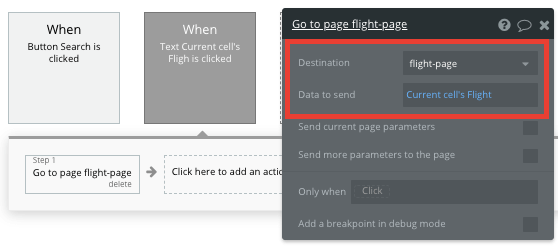
Display dynamic content on a flights page
Sending data between pages makes it simple to display only the relevant content that’s needed.
When sending data to a page, it’s important to configure your destination page type to match the data property that you’re sending within the workflow. In this case, you’ll need to set the flight page to a flight property.
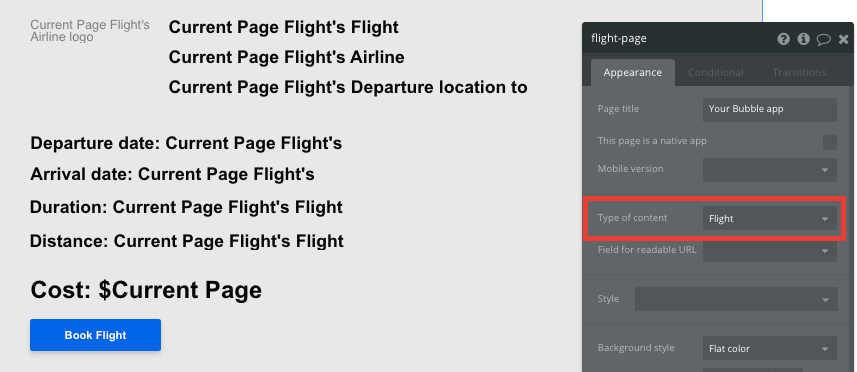
By classifying the type of content of a page, Bubble can easily match data from sent sources.
You can now start adding dynamic content on your page to display information from a particular flight.
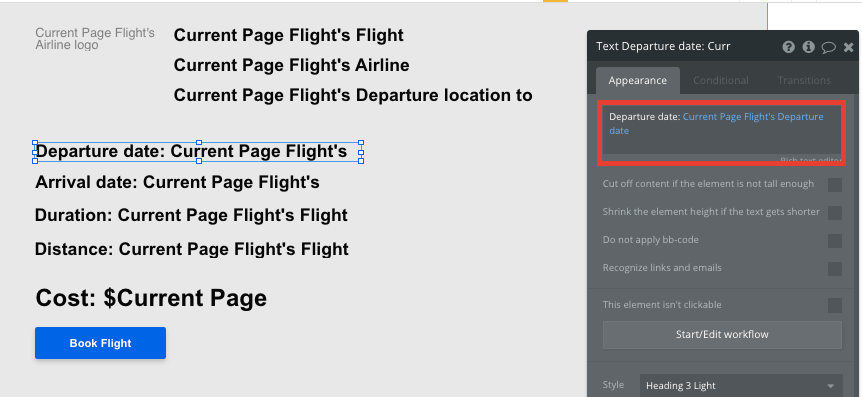
Buying flights
Using Bubble, it’s possible to harness the power of several plugins to easily accept payments and process orders.
In this guide, we’ll be using the Stripe.js plugin to process credit card payments through Stripe.
Note: After integrating this plugin, you’ll need to first configure your API keys within the plugin settings.
When accepting payments, you’ll need to build a checkout interface, allowing users to add their credit card details. For the sake of our MVP, we’ll be adding these relevant fields below the purchase button.
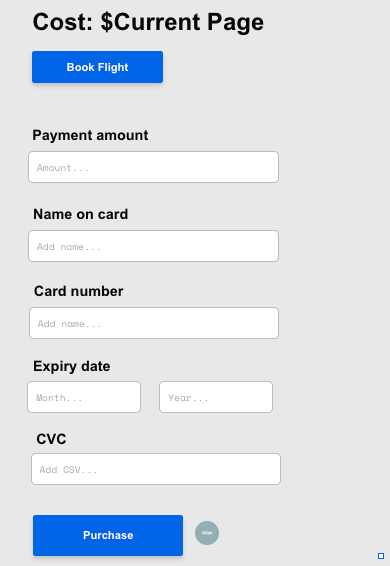
You’ll also need to include a Stripe token element next to the payment form. This element won’t be visible to your end-users, but is essential to powering a new transaction in Stripe.
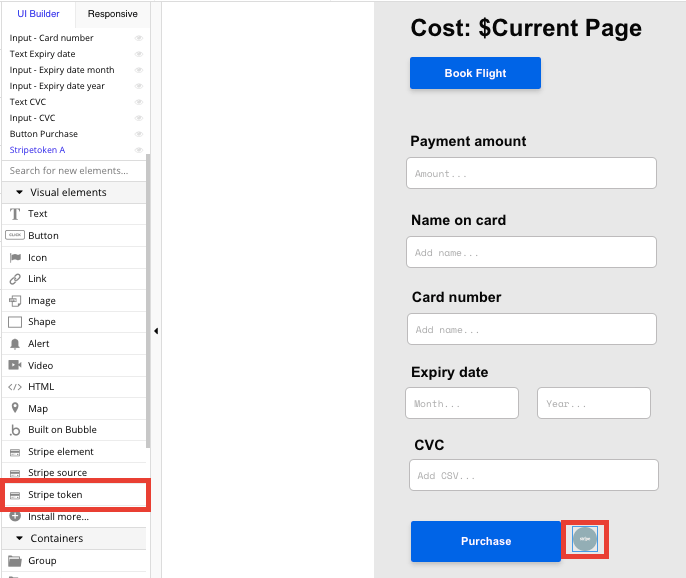
When the purchase button is clicked, we’ll then create a new workflow that triggers a Stripe payment.
You’ll begin by selecting the event ‘ convert card into Stripetoken A ’. Within this event, you’ll need to configure your credit card input fields to match Stripes payment structure.
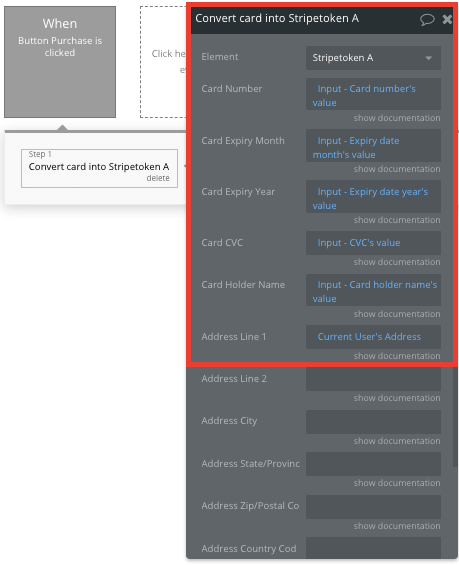
Once a card has been converted into a Stripe token, you’ll then need to create an additional workflow that automatically processes this token from a user's bank account.
When a stripe token for a bank account has been created , you’ll use the ‘ Stripe.js - charge - create ’ event to verify this token, as well as the final amount that will be paid (including the currency).
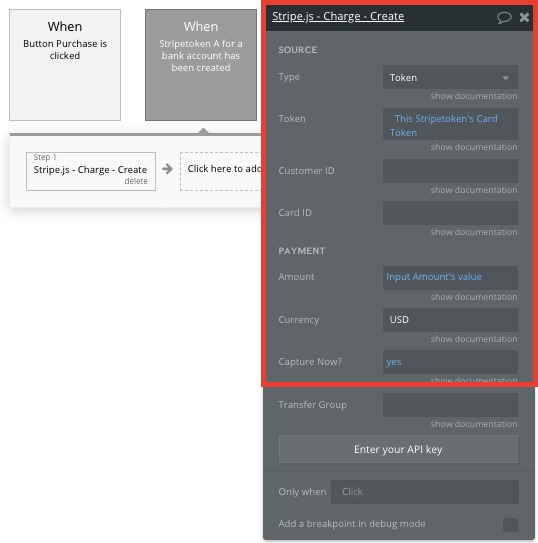
If you’d like additional guidance when building your payment processing workflow, you can watch a full tutorial in the video below.
Additional features
Now that you’re familiar with creating custom data fields and displaying dynamic content, you can start getting creative with the experiences you build within your Expedia clone. Some additional features that you can add are:
- Add user reviews or ratings on flights
- Create a feature for users to bookmark flights in their account
- Offer dynamic recommendations to cross-sell products on your flight page
Hiring a developer or dev team to build this app would cost thousands, if not tens-of-thousands of dollars. Well, now you can treat yourself to a vacation of your own with the money you’ll save using Bubble.
As you launch and grow in users, paid plans allow you to host the app on your own custom domain, and these start as low as $25 per month. Some templates and plugins may cost more, but you can build all the functionality of a booking platform without any additional costs.
If you don’t want to build your Expedia clone from scratch, you can purchase one of the templates made by our community members. Some similar templates to Expedia include:
- Ez Travel App by Ez Code
- Travelly - Tour & Travel by Rapid Dev
- Rently - Car Rental by Rapid Dev
Start Building
Bubble can help you build a flight booking platform or any other product you choose! It’s never been easier to build something incredible without having to code.
To get started for free, sign up here .
You can also connect with other passionate makers building with Bubble on our community forum .
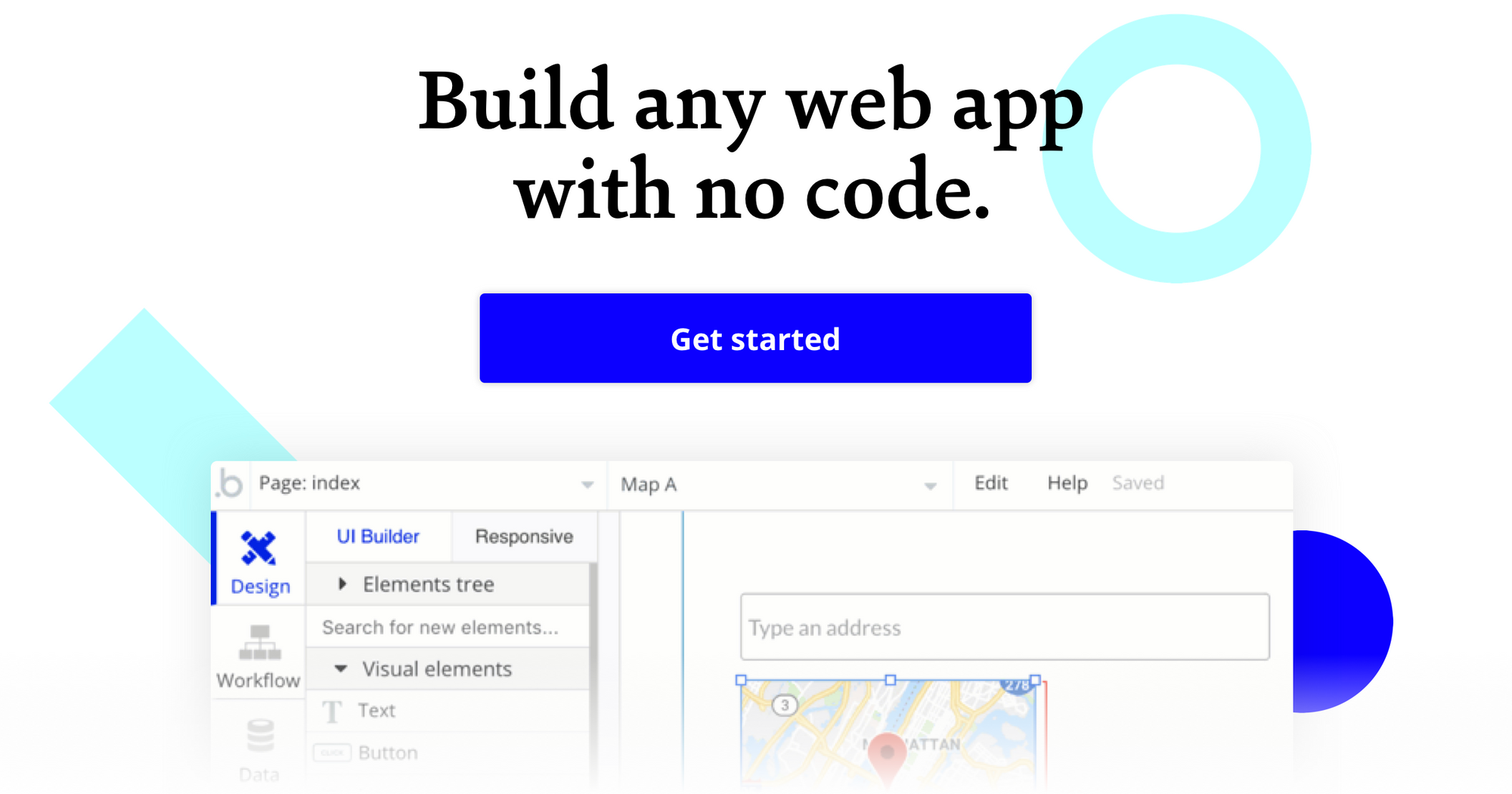
Start building with a free account

Build the next big thing with Bubble
- How to build
- Responsive design
- Version control
- Feature index
- Integrations
- Marketplace
- Partnerships
- Brand guidelines

- Services Custom Web Development Custom Mobile Development Application Maintenance Application Modernization Quality Assurance Custom API Development DevOps Services SaaS Development Data Processing Cross-Platform App IT Security Services Cloud Application Development Chatbot Development MVP Development
- Industries Logistics & Transportations Banking & Finance eCommerce & Retail E-learning & Education Travel & Hospitality Legal Healthcare Food & Beverage Agriculture Real Estate Sports Event Management Oil & Gas Insurance Construction Aviation Supply Chain Management Telecom Manufacturing Payment Processing Lending
- On-demand Developers Python Django Full-Stack React JS PHP Symfony Vue JS Angular JS iOS Swift Android Kotlin DevOps Flask Laravel Yii Zend
- Digital Marketing
- Case Studies
- On-demand Developers
- Custom Web Development
- Custom Mobile Development
- Application Maintenance
- Application Modernization
- Quality Assurance
- Custom API Development
- DevOps Services
- SaaS Development
- Data Processing
- Cross-Platform App
- IT Security Services
- Cloud Application Development
- Chatbot Development
- MVP Development
- Logistics & Transportations
- Banking & Finance
- eCommerce & Retail
- E-learning & Education
- Travel & Hospitality
- Food & Beverage
- Agriculture
- Real Estate
- Event Management
- Oil & Gas
- Construction
- Supply Chain Management
- Manufacturing
- Payment Processing
How To Build A Travel Website in 7 Easy Steps?

The travel industry has become increasingly digitized over the last few years. Travel agencies and other related services cultivate their online presence to respond to changes in customer behavior.
More than 80% of people search for travel information online. A Statista report shows that 65% of revenue from global tourism was generated through online channels in 2020. The growing demand logically breeds supply.
But how to make a travel agency website to make your services more attractive online than competitors? Find out how to create such a website and how much it may cost.
Reasons to Develop a Travel Agency Website
The last year brought incredible losses to the global travel industry due to the COVID-19 pandemic. In 2021, people are once again traveling more actively, and the demand for online travel services is growing. According to the Travel Leaders Group , about 70% of people plan to vacation in 2021.
Considering that 8 of 10 customers book their travel online, running a travel business without a website is impossible. Here are a few more online travel statistics to prove this idea:
- 700 million people will book hotels online by 2023
- 148.3 million travel bookings are completed online every year
- 80% of US travelers prefer booking from computer
- 20% of US, 33% of French and 25% of the UK tourists make bookings using mobile
- 48% of US users use their smartphones exclusively to research and plan their trip
- In 2020 65% of global travel and tourism revenue came from online sales channels
- The online travel agent market was $432 billion in 2020, projected to reach $833 billion by 2025
- Booking Holdings and Expedia were the biggest online travel agencies in the world in 2020

Why a website and not an app? Well, mobile applications are dominating in many service categories. However, 80% of US customers prefer to make bookings via laptop, not a mobile device. That is why you first need to think about travel website development and then create a mobile application as an additional sales channel.
Besides the customer preferences, there are many more reasons why you need to consider creating a website for your travel business:
- Credibility : it is hard to imagine a business without an online presence. People do not want to spend their time walking from office to office to choose a travel agency or find the required destination at a suitable price. They do all of the research online. Having a website provides credibility for your company. In the travel industry, it is not enough to just have profiles on social media.
- Availability : many travelers decide to book a tour during non-business hours. A website provides the ability to use your services 24/7.
- Visual and intellectual impact on the audience : the website content with its eye-catching photos, appealing descriptions, and easy and quick customer journey from start to checkout may impact the user’s decision to purchase from your agency. A website is a powerful marketing tool to present the company’s services as maximally attractive for customers.
- Online booking engine : it’s quicker and cheaper for a company to process bookings made online. And it’s handier for the majority of customers.
- Client reviews : people trust other people more than any advertisement or promotional content. By placing a client review section on the website, you can significantly boost loyalty to your brand.
- Building partnership with related service providers : a travel business highly relies on cooperation with other service providers. You can create a travel website to build a robust partner network to extend your services and conquer new markets.
- Sales & lead generation : present your tour packages and sell them via your online platform. Your website will generate more leads and sales within the comprehensive search engine optimization and online marketing promotion.
Not only do travel agencies benefit from creating a travel site. You can create a travel review website where tourists share their traveling experience and leave feedback regarding hotels, restaurants, carriers, etc.
You can create a travel portal to collect tour prices from different providers, a hotel booking website, or a travel blog. Depending on the type of travel website, there are multiple monetization strategies available. Check our guide in the nearest future on « How to Monetize a Travel Website ».
Must-Have Features for Travel Website Development
There are two significant types of travel websites: travel bookers and travel blogs. A travel booking website can be a specific agency’s website or a reselling service that helps other providers find customers at a special commission.
A travel blog can contain descriptions of different travel locations, show reviews, tell about personal traveling experiences.
The required type defines how to make a travel website for your purposes and its features. First, let’s focus on a traditional travel agency’s website to analyze what features would be great to implement in such a product.
A modern website for a travel agency is not an introductory gallery of available tours and services. Instead, it should be a comprehensive web application where users can review available options, filter the ones that fit their requirements and make a purchase. Essential features to start building a travel website include the following:
1. Responsive Design
More than half, 54.8%, of total web visits are mobile, according to Statista . If the website is not mobile-friendly, 55% of users won’t engage with a company. A poor mobile user experience can seriously damage your brand and reputation. That is why it is vital to create responsive, mobile-friendly travel website design layouts for your travel website.
Such a design adapts to different screen sizes and resolutions, making it convenient to use all the site’s features on any supported device. Check the booking.com website to test the responsiveness in all its power.

Booking.com Responsive UI
2. Simple Search Filters
Searching and filtering options are the key UI elements. Most users come to a travel agency website to find a suitable tour or a hotel. While there are multiple search options besides location, you need to make locating them comfortable for a user. Avoid messing up the interface with a too-long list of available search categories.

Predictive Search
It would also be great to do a predictive search to choose the required hotel names or cities by the first characters entered. It saves time and helps find the desired item even if a user doesn’t remember its full name, a common occurrence among travelers.
3. Appealing Visuals
Besides direct access to the agency’s features, a website should create a particular mood and make a user want to book travel right here and right now. HQ photos and videos with bright, eye-catching scenes from travel destinations, hotels, and restaurants are vital for this purpose.

HQ Photos for A Travel Website
Don’t save on the graphic content quality or size. Instead, let users enjoy their full beauty and colors. However, make sure all those graphics don’t affect the website’s performance.
4. Favorites
People spend a lot of time researching possible destinations and can hardly choose quickly. They prefer selecting suitable offers and then comparing them, reading reviews, and thinking over each one for some time.
Implement the ability to add the listings to Favorites to come back and make a purchase later. Put it somewhere in the profile section and place a ‘Favorites’ button into the navigation bar for quick access if a user is logged in.
5. Clear Pricing Without Hidden Fees
Imagine the competition around the travel industry and a user finally decides to become your customer and book a tour on your side. When they go to the checkout page, they see an amount different from the one set in the catalog. It is one of the most significant bounce triggers. Make sure you list the actual pricing of every item you offer so that no hidden fees are revealed during the checkout process.
6. Google Map Integration
Google Map integration allows checking the chosen venues on the map, displaying the nearby infrastructure, viewing photos and descriptions for each point, etc. It would be great to use these gro-based features on a travel website to make it more interactive.
7. Real-Time Online Booking
Most companies develop a travel website to allow online access to tour booking features. To provide real-time data updates in your catalog, enable a property management system (PMS). It will help keep the information like check-in and check-out dates, destination, contacts, and other data up-to-date.
8. Easy & Quick Checkout
The checkout process should be smooth and easy to complete, as a user has already spent much effort choosing the tour and deciding to spend money on your website.
Ensure your checkout form doesn’t contain any unnecessary fields so that a user doesn’t have to enter more information than needed. For example, it would be great to let users save their payment details and billing address so they won’t have to enter this data again and again.

Airbnb.com Checkout Form
Multiple payment gateways are also a big plus. Customers highly appreciate flexibility in the accepted payment methods. Focus on those that are more popular among your target audience.
Would you like to implement the best pack of features for your travel website? Consult KeyUA software and marketing experts to get a first-class solution.
9. Access to Customer Assistance
Think about what customer assistance options you would like to provide. The most basic options are a contact form for email assistance, a callback request, and a phone call button. Also, think about a FAQ section that would contain answers to the most common questions regarding your services.
These are the must-have features for building a travel website. Standard features like registration, login, profile section should also be on board. The features from the list above are enough for an MVP version. It can further be extended with more valuable options to enrich the customer experience:
- A customer review section: people trust other people more than any promo material. Having reviews from real people positively impacts your customers’ loyalty and helps them choose a suitable tour.
- Blog section: the travel-round content is endless, and tourists like reading and watching related information. A blog section is also great for monetization and making different cross-promo marketing campaigns with partners.
- Advanced customer support options like a real-time chat or an AI-powered chatbot
- Appealing and informative text content to describe services, destinations, hotels, etc. It could be a powerful SEO tool to improve the website ranks in Google search results.
- AR/VR capabilities: running a virtual tour to the desired venue, getting a 3D overview of the nearby territories can be a nice add-on that website visitors may like.
- Big Data: big data analysis works well for generating predictions and recommendations for website visitors. Based on their previous behavior, you can provide more personalized CX.
Think about these features as the next step of your website development after an MVP is successfully launched.
8 Steps to Make a Travel Website
The process of travel website creation includes the research, development, and post-development sections. Here is a rough plan of how to build a travel website from scratch.


Step 1. Choose The Niche
The niche defines the type, features, and technologies for the future website. For example, there are online tour operators, hotel or ticket booking services, travel blogs, and much more. Find out more about all existing travel website types in our future blog post.
During this stage, clarify the following criteria:
- services you would like to offer through the site
- target customer categories
- Set the business goals you’re planning to attain
You should have a clear vision of your future website, like a tool for reaching specific commercial goals.
Step 2. Define The Features
After you’ve clarified your niche and audience, it’s time to list the desired features and requirements for the development. Document your requirements to let the future team estimate the project and allocate necessary resources for implementation.
After listing all desired features, think about which to develop first and which ones can be postponed to the subsequent releases if there are specific time or budget limits.
Step 3. Choose the Development Stack
After specifying the requirements, address them to a qualified development team to estimate how much it will cost and how long it may take to create a website you need. Then, based on the project specs, your technical experts will recommend the suitable development approach and technologies. There are two available options to go for:
- Out-of-box solution : taking a content management system or specialized platform and customizing it for your specific needs. The main pros are saving time and costs on development. The cons include different limitations in functionality and a lack of brand identity.
- Custom software development : you can build a travel website from scratch. The advantages are completely fitting your requirements and the ability to implement unique features and design. The disadvantages are mainly related to a bigger budget and timeframe compared to using ready-made platforms and solutions.
Each approach implies using different technologies to provide the required functionality, performance speed, and security. Partner with an experienced development team to recommend the best options for your project.
Step 4. Create UI Design
The UI design stage implies creating wireframes for each type of website page with all UI elements. Investigating the typical user scenarios and generating storyboards can help choose the right elements and locate them properly. The results of this stage include wireframes and graphic designs for each website page type. Additionally, creating a clickable website prototype is possible to see how it may look after being coded.
Step 5. Develop the Website Code
This phase implies developing the client-side (front-end development) and server-side (back-end development) of the future website. First, turn wireframes and designs into the code, making them functional. Then, connect UI elements to the database, programming all necessary features. All this scope of work should be adequately planned and fulfilled by the team. A project manager (or sometimes a few PMs) coordinates the joint work of front-end and back-end developers.
Step 6. Create Content
Besides feeding the catalog with travel data from your database, you’ll need to fill the website with different text and graphical content. For example, you should prepare texts and photos for each page, various banners, a motto, maybe have some longer texts for SEO purposes. Take care to compose a content plan that includes every piece of content you’ll need to get done before the website launch. Then let copywriters, marketing specialists, and designers work on it.
Step 7. Quality Assurance
The website should be properly tested before the launch. A QA team should check Its visual appearance, functionalities, performance, and security for all possible failures. It is essential to reveal and fix all bugs before the public release.
Step 8. Launch!
Finally, your travel website is ready to go public and receive its first visitors. Make sure to promote its release on social media and other online resources to attract visitors. It’s time to add your website URL to your team’s business cards.
A website requires constant maintenance and troubleshooting after the release. Growing traffic loads, new data, functionality upgrades, administration issues — all this requires continuous technical assistance to provide trouble-free online customer service. In addition, digital marketing support, SEO-optimization also bring results only if constantly performed.
Would you like to know how much it will cost to create a travel website based on your requirements? Let us estimate your project.
How Much Does It Cost?
The total cost of the travel website development project depends on a few criteria:
- Project scope and complexity
- The chosen tech stack
- The team size
- The deadline
- The team’s location and rates
The location of the team defines their hourly rates. According to Upwork, the hourly rates for web development ranges from $15/hr to $136/hr. The top rate for a front-end developer is $100/hr and $150/hr for a back-end developer. Developers from North America and Western Europe traditionally charge the most.
In contrast, developers from Asia and Africa offer the cheapest service. If you are wondering how to create a travel website at a minimum price, consider the best price-quality combo by hiring an outsourcing partner from Eastern Europe. The average rate there is $35/hr, ranging between $20/hr and $50/hr in Ukraine, which provides an optimal price-quality ratio.
Consider first working on an MVP version with minimum features required for your online presence. After that, it would be reasonable to set a more extended deadline, as a tight timeframe requires a bigger team and higher rates to complete everything in time.
A team for a custom travel website development should include:
- 1 project manager
- 2 front-end developers
- 2 back-end developers
- 1 QA specialist

Considering an average rate of $35/hr for Ukrainian specialists and a project duration of 6 months, the approximate project cost is about $168,000 . To get a precise estimation based on your specific requirements, please consult our software development experts.
Step-By-Step Guide on How to Build a Travel Search Engine Website
Starting a travel search engine website is a different process for every startup depending on the business plans and goals. The general process includes designing the website and then choosing what type of integration to do, depending on budget, license or access and stage of development. The two main types of integration solutions are affiliate or API.

The Travelpayouts partnership platform provides all necessary tools to build a travel search engine website with flights and hotels. Signing up only takes a couple of minutes and you’ll receive access to over 100 well-known travel brands and various partner tools from basic to advanced. You can earn up to 20% on each booking for a travel service. In 2021 alone, Travelpayouts paid partners over $5M. To earn on the flights, hotels, car rentals and other travel services join the Travelpayouts partnership platform for free today.
Join the Travelpayouts Partnership Platform
Access exclusive tools and the best travel partner programs, including flights, hotels, car rental, insurance, tours and activities, all in one place.
Existing Opportunities for Creating a Travel Booking Website
- Direct database is when you manually create your own travel database. This is usually done when the host is creating a website. For example, a hotel chain or a tour company that only wants to sell their own hotels or tours, or an airline that is selling their flight tickets direct to consumer. A direct booking portal can also be created if a company establishes contracts with host travel suppliers to manually list and upsell specific deals/products.
- GDS integration is for OTAs (online travel agencies) to access full inventory of travel solutions to sell to their customers. GDS stands for the global distribution system that allows travel suppliers to distribute travel products, rates and relevant information for travel agents to sell. Some commonly known GDS providers are Amadeus, Sabre and Galileo, which is also known as TravelPort. GDS integration is only available for licensed travel agents that are ARC or BSP accredited. Once approved with the GDS, travel resellers have access to backend wholesale rates to buy services on customer’s behalf. When an agent wants to showcase the GDS database on their website, API integration is done.
- Affiliate integration is for start-up travel resellers who want to showcase a range of travel deals on their site to earn commission without having to be an agent. Affiliate is the easiest and most affordable solution, and is most often free to set up. Partners share their booking commission with the affiliate company that is hosting the deals. It is a win-win partnership where the promoter gets access to promote travel services in return for shared commission. Partners often have creatives to promote such as text links, banner ads, widgets and white label search engines. The partner’s referral code is coded into the promotional creatives, so that when setup on a website, the affiliate earns commission when their visitors are referred by them. For example, with the Travelpayouts digital partnership platform , you can create a travel search engine featuring numerous indispensable travel services from flights to travel compensation. All thanks to the fact that the platform is connected to over 100 well-known travel brands in different categories, such as Booking.com, TripAdvisor, Kiwi.com, and others. You can learn more about each of them in the brands directory .
- API integration is more advanced than affiliate, because it takes more development time to setup and most travel companies do not allow their API to be used freely. A partner may need to be approved for API access before they can setup. The earning potential varies depending on which company’s API you are setting up. Once approved, you will require an API developer to install the API, which can often require ongoing technical support. API stands for a set of functions or procedures allowing the creation of applications that access the features or data of an operating system, application or other service. When relating to travel development, APIs are used to showcase another travel company’s inventory on your site, so that visitors can browse directly on the website and the deals can show in conjunction with other deals from other travel companies to create a comparison search engine. API is advanced integration and is not a quick setup process. It requires a properly trained developer to assist with setup. Learn more about Travelpayouts API in the knowledgebase .
A search engine website focused on travel is any website that provides customers with the ability to search for deals related to their travel inquiries. There are various types of travel sites including OTA (online travel agencies) and meta search (aggregator search engine), along with direct booking airline, hotel and tour websites to book directly from the hosts.
The approach you take to the development project depends on what type of travel website you are looking to build for your business. If you do not have web experience, projects both large and small require a development team or developer to manage the travel web design and set up the on-site deals and database. It is recommended to work with development providers who specialize in the travel industry to get the best solutions for your requirements and to save time and money in the process.
The web platform that the site is developed on can differ based on project requirements including PHP and WordPress , as some of the most well known. PHP is more suitable for custom projects that require a custom-made admin. WordPress is more common and suitable for start-up websites that can operate using the dashboard provided with WordPress admin, which includes blogging capabilities and plugins.

Plugins are add ons that can be added to websites for additional features that don’t require custom coding. The benefit of using plugins is that you can save time and money in the development phase by using third party solutions rather than creating features uniquely for your site, which can be time extensive and costly. Travelpayouts offers an automated travel booking plugin for WordPress to build your site.
Once you have determined which platform the site should be built on, the next step is discussing your preferred design and appearance of the website. Usually, the developer or designer will request reference sites to be sent to them to give them an idea of what look and feel you want your website to have.
Modern websites such as Trivago and Kayak have a very simplistic homepage, which has become popular. They also display the travel search engine immediately, which directs visitors to input their travel details and instantly start searching for deals.

The design is an important factor in the process of building your travel search engine website, as it is what initially will separate you from your competitors. When a visitor first arrives at your website, they should feel like they are in good hands with a professional design that is captivating and will make the customer want to stay as well as be directed to do something.
This is called a “ call to action ” and is what makes the visitor interact with the website. The appearance of the travel page will influence the bounce rate and initial interest in your business.
Integrating travel deals onto your website is done in various ways including direct database and GDS (global distribution system), along with affiliate and/or API.
What Is the Best Solution?
The best solution for your integration depends on your budget and the type of travel company you are creating.
- Affiliate is the easiest and the lowest cost option. White label is very competitive, and providers such as Travelpayouts and SkyScanner offer this.
- API is the best option for comparison sites, but requires approved access and a time consuming setup process with specialized developer.
- GDS would be best for classical travel agents who are working offline and looking to access full inventory.
- Direct booking is best for businesses that have already established their services and sell directly to consumers or resellers who are willing and able to create relationships and contracts to resell.
If you are looking to build a travel affiliate-based search engine website, here is a five-point step-by-step process on how to go about it.
How to Build a Travel Affiliate-Based Search Engine Website
- Step 1 – Create a website plan. Budget accordingly and purchase your domain and hosting if required. Register your name at any registrar like GoDaddy.
- Step 2 – Design your web page. While determining the design of your site, you can use ThemeForest to gain inspiration and ideas with thousands of pre-made themes.
- Step 3 – Build your website for free on WordPress. If you do not have experience with developing, you can hire a travel affiliate web developer who has expertise in the area, like TravSell.
- Step 4 – Research and sign up with travel affiliate partners . Gain access to text links, banners, widgets and white label search engine codes.
- Step 5 – Integrate travel search engines and/or affiliate codes. Set up travel deals on your website according to your preferred method.
If you use Travelpayouts, login to your dashboard to access the integration solutions available to use. They are all available in the tools section:
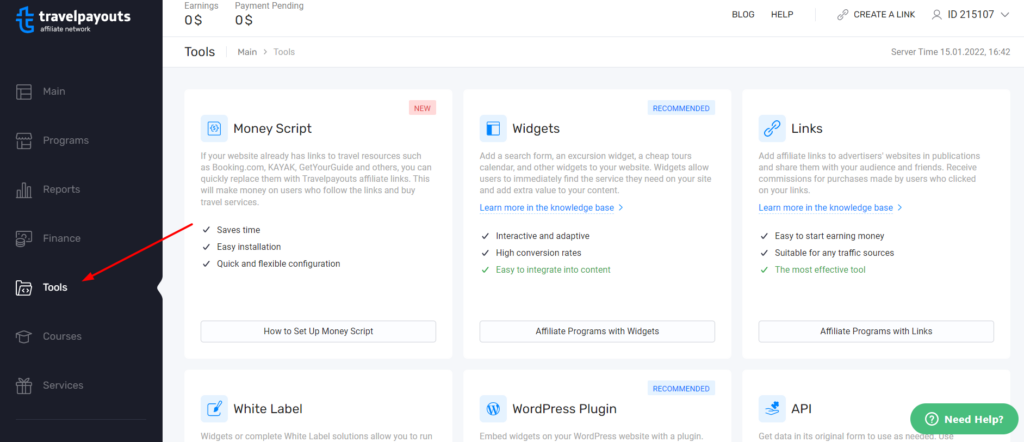
Commission can be tracked from your dashboard as well, which will show confirmed bookings and commission.
You have three main options on how to integrate Travelpayouts flight and hotel metasearch:
- Use a widget and send traffic to Aviasales/Hotellook or to your White Label project
- Build a White Label project. If you do not want to send traffic to Aviasales or Hotellook, and want to keep it on your own webpage, you have to create White Labels. Create two white labels for flights and hotels respectively. You can integrate the logo and navigation of your main website on the white labels. Here, you will find the guide on how to set a White Label on your project.
- Build a stand-alone meta-search based on API. For those who need more flexibility, there’s API. You could use it, for example, to offer something for the user based on his location using Travelpayouts Data API. You can also use API to show the popular directions from the user’s city .
White Label and API Alternatives
If you don’t want to create a White Label project or if you don’t understand the API, you can simply integrate the search form on any page of your site. It’ll only take a few minutes.
For example, you can add a search form widget from the WayAway partner program to your website. Implementation is quite easy. Just copy the code of the widget to your page:
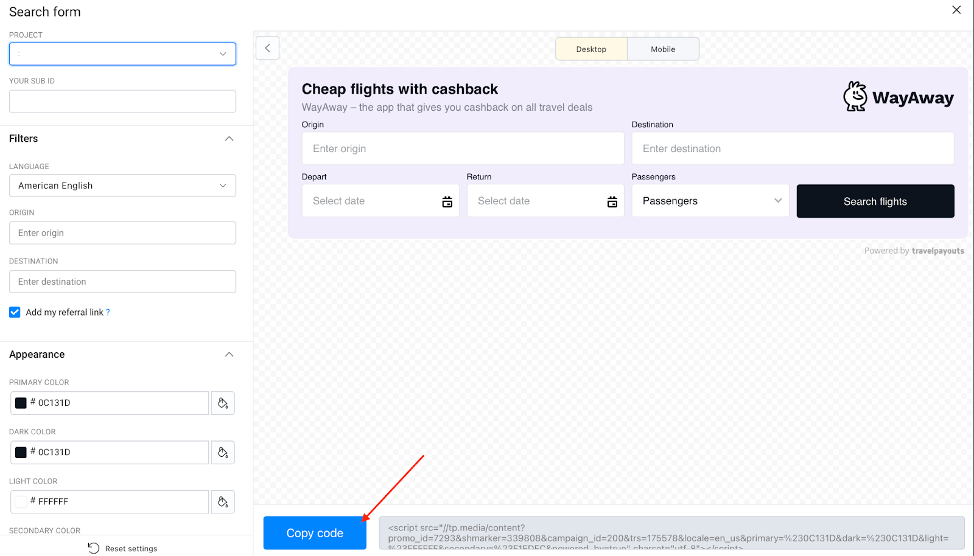
This code must be embedded into your website where you want the form to be displayed:
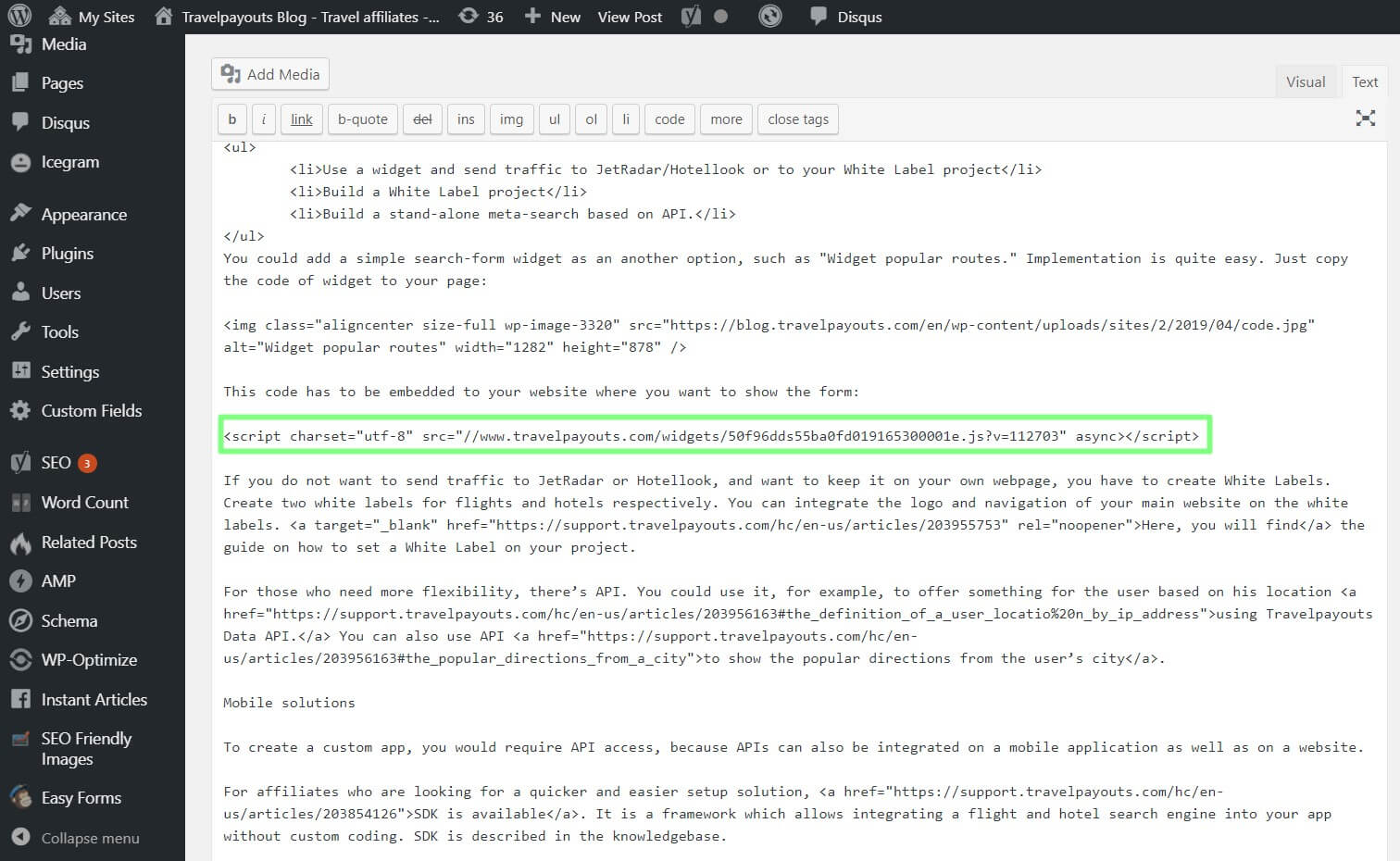
If your users search for and purchase tickets with this widget, you’ll receive a 50% revenue share reward for each sale.
In addition, pay attention to other WayAway partner program tools , which you can quickly and easily integrate into your project. For example, travelers can take advantage of the useful price calendar, flight charting, or prices for flights to popular destinations.
Mobile Solutions
To create a custom app, you would require API access, because APIs can also be integrated on a mobile application as well as on a website.
Travelpayouts provides partners with Travel App template application , which can be customized and placed in the application store.
You could also make a White Label app , which is currently only available for iOS. You can learn about these options from this Travelpayouts webinar:
Do I Need Special Website Hosting to Run a Travel Search Engine?
No, you can use basic website hosting offered from most hosting companies that allow cPanel access, so you can update cNames in the DNS for white labels.
What Are the Other Costs Involved?
Costs may include designers, developers and marketing expenses. Marketing is an ongoing expense, whereas development costs are usually a one-time setup fee.
How Much Money Can I Earn as a Travel Affiliate?
The travel affiliate programs you work with determine the commission earned on bookings. There are two types of affiliates, including Pay Per Click and Pay Per Sale. Read the program’s FAQ and commission page to find out the exact commission details. With Travelpayouts, you will earn 1-10% from the total price of the travel service that is sold thanks to you. The Travelpayouts commission policy is described there .
If you need more information about the earning potential of the platform and what you need to get started, watch this video .
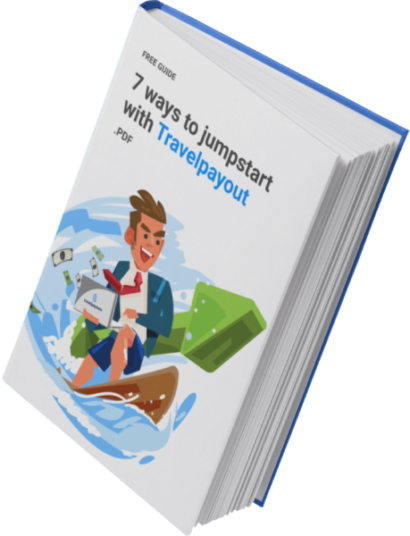
7 Ways to Jumpstart With Travelpayouts
What is the best way to market my website.
There is no universal technique that is best and works every time. To start, you could choose a specific niche and/or location to separate yourself from competitors. Then, dominate your market with an aggressive search engine and social promotions using Google and Facebook. Follow the Travelpayouts blog to stay informed about the best ways to market your site.
Can I Change My Integration Type After Setup?
Yes, you can continue to modify your website with further development support from your developer or team. It may require extensive changes to your business model. Once a site is aged with traffic and bookings, the travel reseller has more income partnership opportunities.
Aside from all the options, API is the most flexible solution. It gives you unlimited freedom to develop your own travel website.
What Else Should I Know?
Consistency is key when growing any business. It takes time and effort to establish a loyal customer base, but the travel industry is constantly growing and changing with new opportunities. Make your business unique to stand out and don’t be afraid to try new things.
Nilead Platform

Business Owners

Content Writers

Marketing Teams

Advanced Users
Book a free discovery session.

Or Send Us a Message
Thanks for reaching us.
Thank you for reaching out, our team will get back to you asap. Please make sure to check your spam/bulk mail box if you do not receive email from us within 48 hours.
Jul 16, 2018
How to design a perfect travel website.
Article brought to you by Nilead , a website builder platform with fully managed design and build service.

Table of contents
In the 2017 Global Economic Impact and Issues Report, over 80% of travel planning is done online, and 33% of users consult travel blogs for advice. According to YouTube data, travelers spend more time watching online videos than ever before; content related to travel has seen an increase of 118% in views over the past year. Mobile devices have experienced the greatest growth according to the data, which is understandable since travelers are constantly on the move.
As the world recovers from COVID19, people are starting to travel again since they have been stuck at home for so long. The online travel agent market dropped by 20% in 2020, but it is expected to grow by $820 billion by 2023. (following Online travel agent market size from Statista ). In fact, the pandemic helped make people realize just how fickle life is, and made them want to experience more things in life. In addition, the pandemic affected people's use of the Internet more than ever before. Online bookings of hotels, tours, and activities are also becoming more common. Travel and leisure companies tend to invest more in developing travel websites.
With that said, having a website does not guarantee success. Many travel companies already have websites, so you have to go beyond that to stand out and differentiate yourself from the competition. So what makes one travel company more successful than the others on the Digital front? Is it the technology, the design, the content they post or is it something else?
Common Travel Site Models
Throughout this article, we will examine a number of travel website models that are doing well as far as traffic (and fame), we will analyze what they do, and then determine what we can learn from each of them.
Local Tour Agency
There are hundreds of thousands of travel agencies around the world, and most of them have their own websites. Often, these websites focus on niche services and local markets. Despite the fact that most local agencies don't have the budget and exposure that other models do, they represent a significant portion of the market by sheer numbers.
Online Travel Agency (OTA)
Traditional travel websites offer both search and booking functionality for flights, hotels, car rentals, cruises, events, and activities. In addition, they often offer bundles to secure greater discounts when booking multiple services at the same time.
Some of the big players in the online travel industry you've probably heard of include Expedia , Hotels , Travelocity , Orbitz , and many more.
Tours and Activities
Travel websites offer information about day trips, excursions, and other activities for time-strapped vacationers. They help tourists avoid exhaustion while making the long search. There is a wide range of options for travelers, from traditional sightseeing tours to unique VIP experiences.
Viator is one of the more prominent players in this category. The company offers thousands of tours and activities online. Currently, it is the largest global source of ready-made activities and tours at local locations.

Sharing reviews and tips
The younger generation is no longer interested in touring large groups with fixed schedules. They prefer to explore things on their own and have a flexible schedule that they can easily change based on the situation. Travelers love to share their personal experiences, leaving reviews and tips and checking out other travelers' real experiences. Travel and Hospitality Industry related websites such as TripAdvisor offer online reviews and bookings. This site has been one of the favorite web destinations of travelers looking for information about their destination before hopping on their next summer vacation.

Travelers looking for travel and tour websites want to know what other travelers have said about the service quality and the experience of their trip. Testimonials on the site are essential but are not sufficient since they can be fabricated. To build trust on your website, do not use stock photos or canned reviews. Ask your customers for permission to use their own photos, personal information (name, city) and reviews. Many travelers also find it more useful and trustworthy if the testimonials are left on a third-party website like TripAdvisor.
vLogs (Video blogs) are on the rise. As a picture says a thousand words, a video says a million. There is nothing more powerful than using this new technology to show live footage and experience of your services to the world. With videos, people can immerse themselves in the experience and imagine themselves in it. Our team thinks vlogs are an incredibly cool way to share tips and opinions with the world and show people what you have to offer.
Booking and reserving online
The real reason why people go online is because it's convenient. A few clicks (or touches) and we can check the weather at the destination, book a tour, and reserve a room. Your hotel / accommodation service will be much appreciated if you make online bookings available. You can even go one step further and put yourself in the travelers' shoes to see how you can improve their booking experience. Can your system tell them which date has the best rate during December if they have a flexible timeline? Would it be possible to pick them up at the airport if they arrived late at night? Would there be space for an extra bed? By offering a smooth online experience, you already score the first five star impression with your customers and hugely boost the chance of getting the business from them. A standardized and automatic process also helps you to save human resource, reduce cost, and minimize mistakes to ensure the experience for your guests. A traditional physical office that limit your reach to only the number of travelers within your office’s vicinity and only a few will hear about your deals. You will be able to get a booking request from all over the world without the need for a physical office, which is, by the way, an additional fee you have to pay.

Real time ads & promotion
Your website is your best worker. It works 24/7, 365 days a year without asking for promotion, and over time without complaining :) (It's the webmaster that complains, and asks for promotion, over time). With your website, you can send news, promotions, and other information to your audience all over the world within seconds without any extra cost or need for pre-booking or pre-planning. Isn't that awesome? Business can stay connected to their audiences through the web for a fraction of the cost of using traditional media, but it also enables them to interact with them in ways they have never seen before.
A few years ago, the best price could only be had if you pre-booked months before your stay. Using services such as HotelTonight , you can book within the same date and still get a huge discount. It may make sense for your business model to offer last minute deals to help you cut losses and improve balance sheet.

Travel Meta Search
Comparing flight, hotel, cruise, and package holiday websites separately takes too much time. Travel metasearch engines allow travelers to view all their options in one place. These types of travel websites offer users top deals by collecting information from hundreds of websites. These deals include flight tickets, hotels, car rentals, and activities.
Big players you’ve likely heard of in the metasearch industry include Google Flights , Kayak , and TripAdvisor , among others. Travelers can compare hundreds of airlines and travel websites in one single search. And all for free!
Trending Marketing Tactics
How do we get more people to know about our website? This is probably the question that almost every website owner asks (including us). We have seen a few ones that work for our clients and some other travel websites that we follow, we will list them in no other.
SEO & SEM campaigns
This is classic, but you cannot avoid doing it so it's a must have. Generally SEO (Search Engine Optimization) is good for local business listing, commonly searched key phrases associated with the services or the destinations that you operate your services. If you offer "Myanmar Border Crossin" then it's definitely the key phrases that you should aim for while trying to get a high ranking on the search result.
SEO, however, does take time to rank. From time to time, you will have last minute deals that you absolutely have to push to your potential customers as soon as possible and this is where SEM (Search Engine Marketing) comes into play. With SEM, you can pay to get your website ranked high on certain keywords that are important for you and you can even target the audience to ensure that only a sub segment of the audience can see your promotions (i.e: males above 30 year old living in New York).

Content Marketing

Influencer Marketing
People feel connected to and follow the individuals that they like and trust the reviews, advice and suggestions from these influencers. Working with influencers that are somehow related to you and your services allow you to not only quickly spread the words about your services but also gain credibility and trust from travelers who already trust the influencers you work with. There is one word of caution though: be very careful with influencer marketing because it can bite back. Influencers are normal human beings and they have their own opinions and they can make mistakes which can in turn affect the businesses they are associated with.
Reach Your Audience Everywhere
Multimedia Marketing involves the use of different media to convey your purpose, which is to make your brand known. Through images, videos, ads, or email campaigns, you can achieve this goal upon incorporating this Digital Marketing strategy in your website. By letting your prospects and customers subscribe in your newsletters, you will be able to reach to them
about your exciting deals and offers so that they will not miss such great opportunities. You can also use the social media platform and start making noise about your brand there. You can promote your website in your social media account or vice versa, either way it will guarantee you an increase of loyal patrons.
Marketing automation
Don't be scared by the big word "automation". It's rather simple yet very effective marketing technique that can go very well with Content Marketing. Basically, you want to automate the redundant tasks such as composing emails, sending our newsletters, keeping your beloved customers updated with the latest information that is of their interest.
Last year, we attempted to do "cold mailing" by obtaining a list of all Furniture related businesses in Singapore via public listing then emailed them with useful information regarding their own websites (what they are doing wrong and how to improve etc). We then wait for a few days and then send out another batch of email, this time based on several conditions such as: were the emails opened, were the links inside clicked, etc... Then we waited for a few more days and send out another batch of email depending on the users' reaction from the last ones. (Obviously we offer the option to opt out of the mailing list at any time). We ensured that our content was not spamming and that it could bring some values to the readers by preparing articles such as Furniture website design best practices .

Big Data Marketing
This new type of marketing relies on the assumption that you can collect a huge amount of data (which is usually not the case for small and medium businesses). If you do have access to a huge amount of data, however, you can combine this with marketing automation and do some super cool things. By analyzing the visitors' pattern, for example, you could offer a totally personalized digital experience for your visitors. If you are an airline or big travel company you could dynamically create deals and offer by projecting the number of buyers in the near future and thus maximize your profit.
The best (and probably most difficult) thing about Big Data is that you could detect common patterns using huge amount of data, segment your customers and target marketing accurately instead of sending spammy mass marketing messages to all your customers. If you can detect that a person is likely to take a vacation next December and that he/she is likely to choose to go to an Asian country then the system can automatically send our promotion messages that include only the best deals to Asia next December.

Travel website designs tips
Since Nilead specializes in custom website design , we think it would be a huge miss on our part if we do not give you some tips to improve your websites. Here are a few things that we find working really well:
Use High Quality Media Content
This is definitely not something that you should skimp money on. You must invest in high quality media content that can truly impress your potential customers. Do not use stock photos. Do not use low quality photos (even with instagram, try to use a good phone to take the photos, phones are so cheap now). Hire professional photographers if you must, get your photos and videos professionally edited before posting them online.
At the same time, travelers will also greatly appreciate live stream videos or real-time updated instagram posts regarding the tours and the destinations. Try to include these media content on your website to build trust and excitement about your services (as well as offering the travelers a chance to see what they can expect from your services).

Highlight Time Sensitive Content
Make sure that you update your website’s content and deals with those that are timely for the season or for some upcoming big events such as Olympics. The highlight time sensitive content should have a dedicated section on your website that can easily catch the users' attention and create a sense of urgency and excitement. You can also conduct research on the different places, restaurants or cities that are currently making noise in the internet and start planning for a good deal to offer for those who want to go and visit them.
Here’s a tip: most travelers will feel the rush upon reading such timely contents and a great percentage will automatically book a deal from you once you give them a good one. So make sure you know what are timely and use this travel rush to gain more!
Smart Use Of Design Elements
Upon having your website loaded, entice your visitors or customers with a vivid orange scheme when it’s summer, a cool blue when it's winter, or a relaxing green when it's spring time. This way, you can captivate the “feels” of every visitor on the current season and make them want to travel more. But this doesn’t have to be always the case. You can just stick to one color scheme that is not too bright or too dull to increase the “weight” of your website layout. Make sure to use fonts that are readable as well and comfortable for your customers. It does not have to be fancy. You just have to arrange it stunningly.

Accessibility and Usability
Nothing beats a well-organized and neat website. If you have different types of information that you want to convey such as great deals sections, stunning places to visit section, and about us section and others, you need to analyze your Content and organize your website content to ensure your visitors do not get lost in the information that you provide.

Just like how newspapers tell news, keep a hierarchy of thoughts and information in your website. This way, what is more important and appealing can easily make its way to the eyes of your customers and captivate their interests. What is less importance stays probably in the lower part of the page so that you will have more venue to lay out stuffs with more content on the top. Always remember that the first glance could tell a lot of things. It is like love at first sight. Once your visitor falls in love with your website and business at first sight, it will keep them coming back for more.
User Experience And Interaction
Keep your users in mind, make sure that as they do their “paper works” they will feel less burdened and hassled as compared to them doing it physically. After all, this is the main reason why people go online because of the convenience it can give. Upon doing your effort in making sure that your checkout o booking page is not complicated, make sure as well that you do not miss any important details along the way. Convenience is your goal, so make sure that your customers will not experience any hindrance at all during the big day as well.

As you post your deals and prices, it will be extremely helpful if you can properly break down the costs so that you can ensure there are no hidden fees that may damage your reputation and your future business. Many, if not all, look for reliable service providers that do not attempt to use marketing tactics that attempt to lure in customers by offering low price and then surprise them with hidden fees after they have committed to the services.
Travel Website Useful Features
Each business has a different model, but we find the following features really useful for most travel related websites:
Reviews And Feedbacks
I mentioned about this before and I will repeat it here. Reviews and testimonials are extremely important for travel websites. The reviews section will highlight your customer’s experience while dealing with you and your services. They are free to give out positive and negative reviews about you in this section. Never be contented with just positive reviews, having a few negative ones will will show that your business is real and that you do your best to handle complaints and improve from there.

Most businesses tend to hide bad reviews and only highlight good reviews so people generally distrust the testimonials you post on your own site. Try to have your customers post feedbacks about your services on trustworthy websites such as TripAdvisors, Booking, and other services where people use to rate services in your industry.
Personalized Experience and Promotion
People tend to trust stories told by individuals more than content generated by firms and companies. In recent years, websites have begun to use a more personal tone to convey their messages. Furthermore, advertisements and promotions are also becoming smarter and more personal by using information about the users gleaned from their browsing behaviors and from their interactions on other multimedia platforms like social networks. Personal contents can also include your customer's past experience at a certain location. Similar to a review, however this is more detailed and personal since they will tell you what they did, where they went, and how much they spent to make the most of their trip. The inclusion of posts from past customers in your website will not only benefit other travelers but promote your credibility as well. Additionally, the number of such content pieces on your website also helps to prove that you have already served quite a few travelers, which makes you a reliable travel companion.
Blog and Vlog
You want to show your customers that you are really good at what you do and you want to provide them with useful information that can help their travel experience much better and enjoyable. Now, this part requires you writing occasional blogs to showcase some good places to visit, good restaurants to dine to and a good amenity to try out. Many travelers search for contents about travel to help them make informed decisions. And if you offer them a good source, they will surely come running back to your website to book a deal from you.

Okie, without much explanation this is a must for all travel websites. Don't stop with the old boring photo gallery however. You can mix in users' contributed media by asking your customers to share their best moments with you. It brings a sense of authenticity as well as chances for words of mouth marketing since your customers will be more willing to share their trip story with their friends and mention about you and your services.

Search And Filter
Let us thank the genius behind such idea for this has saved millions of people’s precious time. Give your users an experience where they can easily find what they are looking for. Give them a straightforward search filter and results without any unnecessary fillers and take them to where they want to be.
Many customers and users upon entering a website, especially those who doesn’t have a place in mind to go yet, will definitely rely on your internal search engine. Try to make their lives easier by suggesting places that could hit the golden spot and make them go “this is it” with just one hit of the search button.

Favorites And Suggestions
For those souls who really want to go all out and travel yet is lost for not knowing where they want to be, allow them to book-mark and perhaps even compare the tours that they like can be a great time-saver. Once bonus of knowing your customers' favorites is that you can start suggesting them related services that you think they may like and offer personalized deals and travel tips and tricks.
A Few Inspiring Websites For You
I will cap this article with a few inspiring location based travel websites, they may not be the best websites related to travel but they do show the owners' effort in bring the best user experience:

Live Africa
Upon entering the website, you will be welcomed with a video that covers some good sights you can see upon visiting the country. They were able to market the beauty of their wildlife to entice travelers who have a big heart for animals.

Banff & Lake Louise Tourism
Upon loading the webpage, this website will welcome visitors with a huge image banner of the place - a beautiful image that best represents the place and striking enough to capture every visitor’s attention. When you scroll down, different blogs and activities happening around the area were carefully chosen and placed in block contents giving each topic an area of their own.
The choice of color combinations, texts, icons, fonts and animations and effects made the website look really user-friendly and fun to move around.

Visit Velika Gorica
Now, this website looks simple yet utterly stunning. Instead of using an image banner to welcome visitors like the other websites, this one made use of video or slideshow banner to showcase the different places tourists could visit upon getting there. This is yet another website that highlights the importance of using stunning images with fewer words and choosing the right website animation and effects to create a good feeling when moving around.

Visit Korea
Unlike the previous websites, Visit Korea’s website is making use of playful and different colors for their website to which we believe signifies the colorful life in the said country. As you scroll down, contents were placed correctly in block contents to highlight the individual points and concepts. This made the website look cleaner despite it having a lot of materials displayed even on the first page.

Visit Britain
The official website of Great Britain truly offered “Great” contents. The homepage is already filled with some good suggestions that you can do during your website and some good places to visit. You can see that the content blocks were properly arranged as well.
As you scroll down, you will see the contents which were highlighted because of the excellent image choices used. The website houses a few words and more images compared to the previous ones. This website is one good example how good photos can truly flip tables.
About the author

I am TELLE. Tolerant to challenges. Engineer by profession. Loves all my cats. Listens to music daily and enjoys writing. I am an engineer by profession but a writer and a music enthusiast by passion. I have written about various niches but am currently more inclined with marketing and pop culture.
Popular post

You may be interested in

How to design a perfect hospitality website
Aug 02, 2023.

Digital Marketing in Travel and Tourism Industry

Website development strategy - Content First Approach
Our Solutions
Learn & get help.
© Copyright © 2022 Nilead. All rights reserved.
How to build a travel website like expedia?
Thinking to develop your own online travel booking website? Travel is considered the biggest industry in the world. The trend to travel is trending in the marketplace. The demand for the travel website is increasing randomly and every travel business is looking to develop a website like expedia. According to statistics, the demand for travel agency has reached out to 95% in the country. A reputable travel portal development company provides you a complete solution that perfectly needed for a business.
An online travel booking website will have all the essential requirements that users needed to book for traveling. Various online booking websites like airbnb are all increasing in demand. In todays scenario, most travel agencies survive with the successful development of websites. In general, expedia is an online marketplace for eCommerce services. Expedia is yet another online travel website that generates almost $8 billion in revenue in the year 2016. The website helps to book flights, packages for vacation, hotels and all. Make use of wordpress development companies to develop functional travel agency websites. The article shares with you the complete tools needed to create travel booking websites.
How an online travel booking system like expedia works?
The development makes the working process simple and fast. Follow the simple steps and see the work process of website development.
- Booking details
- Prefferd choices
- Check availability
- Place order
- Make payment
- confirm order details
What are the steps to create a website like expedia
Get a domain name and hosting services.
A domain name is an address that you have entered in the address bar to visit your website. A hosting server is a place where you store all the databases essential for your website. It is necessary expensive to protect your website from external attacks. Bluehost is one of the popular servers that is cheaper in cost but provides reliable services. The major benefits highlighted in bluehost is that it automatically develop a wordpress website when you register in it. It is nice to deal right?
Pick up a suitable wordpress theme
Once you enter into the wordpress development process, it is quite important to pick up a suitable theme for the website. The theme will completely change the overall design of the website with all the features and functionality embedded in it. WordPress is rich in many themes and plugins for different categories. For more collection checkout travel agency wordpress templates.
Brand your website
When you have chosen the perfectly suitable theme for your brand, the next thing you have to do is customization options. Customize your website according to the features and functionalities required for your brand.
- Market and start publishing your content
When building a website like expedia, there will be tons of features and functionalities. The only thing you have to do is generate website traffic when your development process is complete. WordPress is a popular platform that you get everything you need at a cheap cost.
How much does it cost to build a website like expedia?
The online traveling booking system is a highly demanded business with many segments included like travel agencies, restaurants, insurance agencies, etc. So, it is the right decision to invest in websites like expedia in today’s economic status. The way that expedia demanded is about the simple and demanded strategy. WordPress travel website design and development aim to get an easier user experience. As a web development company can get you perfect solutions to vacation deals, travelers to get the best accommodation by entering into expedia website. The cost of developing a website like expedia may vary according to the features and functionality that expected to deliver. Check how to build a website like craigslist to know the cost for building a website like craigslist.
A piece of writing is enough for us
We always begins from that., tell us about your project:, our office address.
Yarddiant Web Lounge Pvt.Ltd, Office Number: 12, First Floor, Sahya Building, Govt Cyberpark, Calicut - 673016, India
Talk to Us:
[email protected]
+91 989 5035 143


Expedia Competitors: 11 Of The World’s Largest Travel Sites
Expedia is a travel-related metasearch engine on which users can search and book accommodations, activities, cars, cruises, and flights.
The company, which is headquartered in Bellevue, Washington, was founded in 1996 by Rich Barton and Richard Bangs.
Expedia.com is part of the Expedia Group, which entails web properties such as Hotels.com, Vrbo, trivago, Hotwire, and more.
However, what many don’t know is that Expedia was launched as a sub-division of Seattle-based software giant Microsoft.
At the time, a young Rich Barton was working in Microsoft’s CD-ROM department where he created CDs for travel guides. He eventually transferred to Microsoft’s multimedia division where he would begin conceptualizing the idea for Expedia.
Every year, Microsoft employees would present promising product ideas to then-CEO and founder Bill Gates who immediately liked what he saw. Expedia would eventually be launched on Microsoft’s web portal MSN in October 1996.
Microsoft even bought a full-page ad on The Wallstreet Journal and promoted Expedia as the same reservation system that your travel agent would use. Three years later, after growing into one of the world’s biggest travel agencies, Expedia was spun out of Microsoft and went public on the Nasdaq stock exchange – the first company in the firm’s history to do so.
Berry Diller’s IAC, in 2003, acquired Expedia after investing $1.5 billion into the business two years earlier. Co-founder Barton, as a result, stepped down from his CEO role. He would go on to launch the real estate site Zillow just two years later.
Expedia, in the meantime, was spun out of IAC in 2005 to create what is now known as the Expedia Group. The combined holding company generated $8.6 billion in annual revenue for 2021. Earnings for Expedia.com are unfortunately not broken down.
Gross bookings for the same year were equal to around $72.4 billion. Over 25,000 people are now employed by the group.
The methodology with which competitors of Expedia are ranked is based on publicly available information. Data points such as revenue, number of listings and bookings, funding and valuation, the number of employees, and anything else that might be relevant will be considered.
This article only looks at booking site competitors who either aggregate listings from other platforms or directly work together with property owners, airlines, and such. As a result, indirect competitors, such as hotel chains (who actually own the locations they advertise on their websites), will be excluded.
We also consider Expedia-owned properties, such as Hotels.com or Vrbo, as competitors since they continue to operate as separate brands.
It has to be noted that this analysis should not be seen as an endorsement of either service. It is merely a summary of the competition that Expedia faces as of today.
So, without further ado, let’s take a closer look at the top 11 competitors of Expedia.
1. Booking.com
Booking.com is one, if not the world’s largest travel-related site. It is available in 43 languages and offers and boasts 28 million accommodations. Additionally, customers can book cars, flights, and activities via the platform.
Booking.com was launched by university graduate Geert-Jan Bruinsma who derived the inspiration for launching the platform after visiting Hilton.com for the first time. His home country of Holland, at the time, simply didn’t offer any local options to book hotels online. His site, Bookings.nl, therefore became the first in the country to offer such options.
In 2000, he agreed to merge with another site called Bookings Online. The dot-com crash had wiped out many of the funding opportunities previously available to startups like his.
They then acquired the Booking.com domain name soon after. Priceline, after failed acquisition talks with Expedia, acquired Booking for $133 million in 2005 – a huge bargain in hindsight. Booking Holdings is now worth over $70 billion.
For most of its existence, Booking.com had been part of Priceline. However, in 2018, it rebranded into Booking Holdings, which now owns sites such as Kayak, OpenTable, RentalCars.com, Agoda, and many more.
The platform now lists over 860,000 hotels and apartments, respectively. In 2021, Booking Holdings, which unfortunately doesn’t break down income figures for its namesake site, generated $11 billion in revenue. Gross bookings were equal to $76.6 billion over that timespan. Booking.com itself employs over 15,000 people across the globe.
Source: Booking.com , Booking Holdings , Skift
Airbnb is the world’s largest apartment booking platform. It now boasts six million listings, has four million hosts on the platform, and is available in 100,000 cities and towns as well as 220+ countries across the globe. Customers can book anything from cabins to tree houses. On top of that, Airbnb also has a separate events section.
Part of Airbnb’s success lies in the platform’s user-centric focus. Customers can, for example, complete a booking within less than three clicks. The user experience itself has largely stayed the same as well throughout the years.
However, Airbnb has also faced dozens of legal battles with cities across the globe. Those municipalities claimed that hosts were running illegal hotels and were thus liable to pay taxes. In 2018, for example, a couple in Manhattan was hit with a $1 million fine for illegally listing seven properties on sites like Airbnb.
Additionally, some have argued that Airbnb’s mere existence has led to higher rental costs (especially in popular destinations such as Barcelona or New York City), pricing out locals in the process. Trashed Airbnb rentals are certainly not uncommon, either.
Investors didn’t seem too worried, though. They have poured a combined $6.5 billion into the company, which went public in December 2020 and is valued at over $60 billion. In 2021, Airbnb has generated close to $6 billion in revenue. It currently employs over 6,000 people worldwide.
Source: Airbnb , Crunchbase , Curbed New York
3. Google Travel
Google’s Travel product enables consumers to compare prices and book all types of travel-related items, including flights, hotels, and vacation rentals. Travel is now an integral part of the Google Search experience and oftentimes featured prominently across all types of customer queries.
Its advances in travel have begun as early as 2004 when the search giant launched Google Maps. The location data and reviews now inform a large part of the product, more precisely the Things To Do section. And since exploration is a huge part of travel, this certainly provides Google with a significant competitive advantage.
In 2010, Google acquired flight information software company ITA for $700 million. The purchase enabled them to launch Hotel Finder and Flights just a year after. In 2016, Google launched its Trips mobile app, which it rebranded into what we now know as Google Travel back in 2019.
Google does currently not publicize any traffic or revenue figures for Travel – with good reason. In the past, sites such as TripAdvisor and Yelp have called out Google for its allegedly anti-competitive practices of favoring its own products.
On top of that, many of the most popular travel platforms now heavily rely on Google’s ads for traffic. It is estimated that Booking and Expedia spent almost $3 billion on Google ads in 2021 alone. Meanwhile, Google can acquire all that search traffic for free, simply by featuring its Travel products more prominently.
Source: Redeam , Yahoo
4. Trip.com
Trip.com Group is China’s largest travel site with close to 34,000 employees. Travelers can book anything from accommodations (hotels, houses, apartments, etc.), flights, trains, cars, tours, cruises, activities, and much more.
In fact, over 1.2 million accommodations are available on the platform on top of the 480 bookable airlines. The holding company behind Trip.com also owns other sites, most notably Ctrip as well as Skyscanner (which it purchased for around $1.75 billion).
In fact, Trip.com actually began life as Ctrip but rebranded into its current name in 2019 to emphasize the firm’s international ambitions. It had purchased Trip.com just two years prior. What’s even more impressive is that the founders have built the business with only $500,000 in venture funding before going public on Nasdaq in 2003.
In 2021, Trip.com generated $3.1 billion in revenue. Recently, the firm became the first publicly-traded company in China to implement a hybrid work-from-home policy.
Source: Crunchbase , Trip.com
Agoda offers two million properties (also including hotels) in 200 countries across the globe. Additionally, users can compare prices across activities and flights as well. And just like on many other platforms, including Booking or Expedia, travelers can earn points for purchasing via the platform.
The firm’s founder, Michael Kenny, first arrived in Southeast Asia in 1994 to work for the Arcadia Hotel Group (now Hilton). As the internet began to take shape, he launched various travel-related sites such as PlanetHoliday.com (1997) and PrecisionReservations.com (2003).
Those sites were eventually merged and led to the creation of agoda.com. To help him get the business off the ground, he recruited long-time friend and experienced online entrepreneur Rosenstein as a co-founder. A mere two years after launching, Agoda was acquired by Booking Holdings for an undisclosed amount.
Booking does currently not disclose revenue numbers of Agoda, which employs over 4,000 people in 30 countries.
Source: Agoda , Skift
6. Hotels.com
Hotels.com, as you’ve probably guessed, is primarily accessed to book hotels across the world. However, owners can also list their properties on Hotels.com. The site itself is available in 85 countries and 35 languages.
The company began as the Hotel Reservations Network (HRN), enabling customers to book hotels via free-of-charge phone calls. Since 2005, Hotels.com is owned by Expedia but has already been in the hands of IAC for four years running.
Apart from its super valuable brand domain (for which the company allegedly churned out $11 million back in 2002), Hotels.com has also been a marketing juggernaut. Captain Obvious, as portrayed by actor Brandon Moynihan, has amused hundreds of millions of people for portraying Hotels.com as “the obvious choice.”
Expedia, just like all the other firms on this list, chooses to not break down revenue figures for Hotels.com. The company itself currently employs over 1,000 people, most of whom are based in the United States. This probably indicates that the firm’s annual revenue is somewhere in the lower billion range.
Source: Hotels.com
Vrbo , which stands for “vacation rentals by owner,” became one of the first platforms where people could put up their vacation properties to be booked. The firm’s founder David Clouse actually launched the site to simply find people who’d be willing to rent his ski house in Colorado for when he wasn’t around.
While Airbnb has initially attracted apartment owners, customers had always known Vrbo as a platform to book vacation homes. These days, both platforms work in a similar fashion, allowing travelers to communicate with hosts, offering various insurances against damage and theft, and largely offering the same types of properties. In fact, many owners now list their homes on all kinds of platforms, including Expedia, to maximize exposure.
Vrbo itself was acquired by HomeAway in 2006. Nine years later, Expedia paid $3.9 billion to purchase HomeAway. In 2020, Expedia decided to merge the HomeAway brand into Vrbo, which is now considered to be one of the holding company’s most valuable web properties. Vrbo had just rebranded from ‘VRBO’ a year prior.
Today, there are over two million properties, such as cabins or beach houses, listed on the platform. Expedia went out of its way to promote Vrbo and even publicly disclosed that it expects the site to reach $2 billion in annual revenue some time in 2023.
Source: Expedia , PhocusWire , Vrbo
8. TripAdvisor
Users on TripAdvisor can rate anything from hotels to airlines and destinations, which is what the company is primarily known for to this date. Not only that, having a TripAdvisor sign displayed on your restaurant or hotel is often seen as a significant sign of approval – and can lead to significant additional business.
In the early days, TripAdvisor started out as a search engine of searchable travel information for other internet businesses such as AOL. However, many businesses didn’t want to touch anything travel-related due to the ramifications of 9/11.
TripAdvisor itself had been created as a demo to show interested B2B customers what a consumer-facing travel search engine would look like (the original product was aimed at business customers). After some time, the website began taking a life of its own, attracting more and more visitors every week. The rest, as they say, is history.
The firm was acquired for $210 million by Expedia in 2004. Seven years after, TripAdvisor spun out from Expedia and became an independent company listed on the Nasdaq stock exchange.
What many don’t know is that customers can, furthermore, book hotels, flights, or vacation rentals directly on the platform. This is made possible by TripAdvisor’s Instant Booking feature, which was launched back in 2014.
TripAdvisor is now one of the biggest travel-related websites. It generates $902 million in annual revenue (most of it from advertising). The platform, which employs over 2,500 people, offers reviews on almost 9 million accommodations, restaurants, experiences, airlines, and cruises.
Source: TripAdvisor , Statista
trivago is the last Expedia-owned company on this list. In 2012, Expedia spent $632 million in cash and common stock to acquire 61.6 percent of trivago.
It is yet another metasearch engine that works together with booking sites, travel agencies, as well as the service provider (e.g., airline or hotel) itself. Its various partnerships have allowed the company to list over five million properties on its platform. Most of the revenue that trivago generates comes from click-based advertising.
Travelers, apart from a place to stay, can also book flights and rent cars on trivago. However, those listings are not always accurate.
In April 2022, the Australian government fined trivago $32.6 million for misleading consumers over hotel room rates on the site. trivago, despite those issues, is now Europe’s second-biggest metasearch engine, only trailing Booking.com.
In 2016, trivago became the first Germany-headquartered company to list on the Nasdaq stock exchange. The firm currently generates €361 million (~ $378 million) in annual revenue. Lastly, trivago employs over 1,000 people.
Source: Crunchbase , Reuters , trivago
Hurb, formerly known as Hotel Urbano, is South America’s largest travel-based metasearch engine. The platform boasts over 20 million registered members and has 12 million people following it on Facebook alone.
This is a particularly impressive feat considering that many of the companies on this list have been scooped up by the big two holding companies. Hurb, instead, has raised $135 million in venture funding to help the firm stay independent.
Hurb’s strong suit is the firm’s vast selection of hotels, especially in its home country of Brazil. Customers can, furthermore, book activities via the platform. The company currently employs close to 2,000 people.
Source: Crunchbase , Facebook , Hurb
KAYAK , despite its name probably indicating otherwise, is the world’s most popular site for booking plane tickets. All of the firm’s founders, prior to launching KAYAK, had been involved in the creation and sale of tech- and travel-related startups such as Orbitz.
Their experience and pedigree enabled the founders to raise close to $230 million in venture funding. Eight years after its founding, they took KAYAK public but ultimately delisted the company in 2013 after it had been acquired by Booking for $1.8 billion.
In 2019, KAYAK expanded into featuring properties as well. On top of that, customers can also book cruises, cars, and activities. KAYAK even launched its own branded and physical hotel (in Miami) back in 2021.
Just like the many other companies on this list, Booking does not disclose specific revenue numbers. KAYAK itself employs over 1,000 people and has previously acquired over a handful of companies such as Swoodoo or HotelsCombined.
Source: Crunchbase , KAYAK

Viktor Hendelmann
Hi folks, Viktor checking in! Years of experience in various tech-related roles have led me to start this blog, which I hope provides you with as much enjoyment to read as I have writing the content.
About productmint
productmint.com provides tailored content on all things business and tech. The site arose from my fascination with how modern-day businesses utilize technology and product-led thinking to become dominant players in their industry.
Business Product Privacy Policy Terms of Service
Follow productmint
Facebook LinkedIn Twitter Buy me a coffee
Last Updated on December 8, 2022 by Viktor Hendelmann
How To Develop a Successful Travel App Like Priceline, Expedia and Airbnb

by Dmytro Brovkin
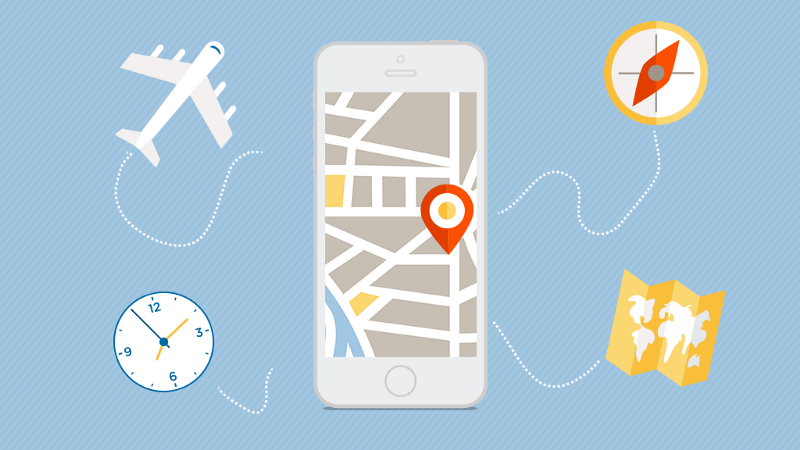
The tourism sphere is a huge business sector that includes lots of components: travel agencies, insurance companies, hotels, restaurants and so on.
It’s rather hard to overestimate the importance of mobile devices in this field — people need access to high quality service while they are away from their PCs and unable to be physically present at the office. This is where mobile apps truly shine.
Why launch a Travel App: a new landmark on the digital landscape
Let’s take a look at the numbers before we dive deeper into the topic:
- In 2009 the amount of downloads worldwide was about 2.5 billion.
- In 2011 it reached 3.1 billion.
- We can expect the number to exceed 7 billion at the end of 2017 which is more than twice as much as six years ago.
The smartphones are about to replace laptops and PCs when it comes to online shopping. If your business is connected with this field and for some reason you still don’t have your own mobile app, it’s time to think about it.
For travel companies as well as online retailers the advantages of a mobile application for business are quite obvious. It serves to boost the sales, improve the quality of service, and make clients more loyal to the brand and its products.
Mobile travel apps include:
- Google and Apple Maps
- Travel planners
- The apps that show you WiFi hotspots nearby
- The apps that allow you to book hotels and tickets everywhere you go
- The apps that can find services for those with special needs
Launching a really helpful app for your users is a great way to get ahead of your competitors. Let’s take a look at these facts.
Today almost everyone has a smartphone. 65% of the travelers prefer to plan their trips with the help of mobile apps.

Most businessmen (actually about 70% of them) book their tickets and hotels via mobile apps.
Around 80% of travel companies, hotels and aviation companies profit from brand exposure, income increase and other factors after an app launch.
Every tourist would definitely want to have an app that allows him to navigate easily everywhere they go. The travel mobile app can include dictionaries, maps, and guides to different places of interest (cafés, restaurants, museums and other). About 75% of the travelers use at least one mobile app during their trip.
At the moment 35% of the travelers download apps for their trip or the upcoming holidays. Another way to use the app is to share the impressions immediately or after the trip. In the era of social networks more than half of the tourists post their vacation photos online.
The travel mobile apps occupy the 7th place on the list of the most downloaded apps.
The stats show that the app launch can provide new ways to increase your income, make the brand more popular, build a loyal client base and much more.
Of course an app has to have a great and valuable idea, and be well-designed and developed. In this way, a mobile app can be a huge advantage for your business.
What makes the difference between a mediocre app and a good one?
What’s the ideal travel app that the users want to use? It’s an app that’s easy to understand and get into. It surely has to make their trip more comfortable and allow people to communicate with other tourists and companies.
These criteria make an app really helpful, reduce the pressure on traveler and make the audience more loyal.
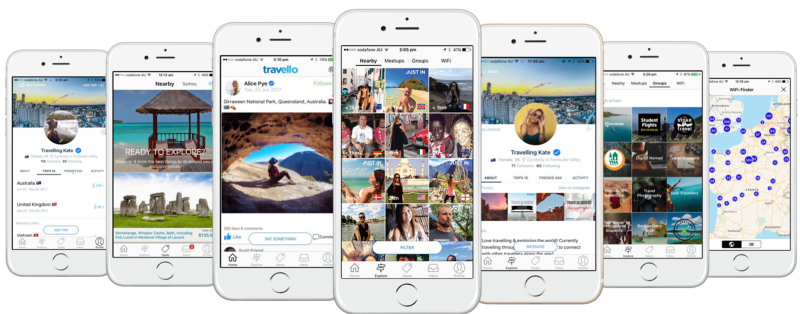
Here’s a couple of tips to make a modern and attractive tourist app that will actually let you turn a profit:
- Make sure that you know what your target audience is. Create an image of your user and work on making the app better for him. If your company works primarily with entrepreneurs and executives, it would make sense to launch an app for the business trips, maybe easy and simple tickets and hotels booking, faster airport check-in or a trip planner.
- Make your app easy to use and user friendly. If your main feature is to search the best hotel offers and book them immediately, the way to complete the registration shouldn’t be longer than a couple of clicks.
- Enable the users to share their feedback with you. Embed a button into the app that brings them to a sector where they can leave their comments, discuss what’s good or wrong with an app and so on. Such a function can allow you to get to know your audience and its needs, and understand what you could be doing better.
- Keep in touch with the users and make sure you communicate with them consistently.
- Make your app offline-friendly. If your app will still be able to notify the people of their check-in or something else even if they’ve turned the mobile networks off, it’ll be a big advantage for you.
- Integrate the social networks like Facebook, Instagram or Twitter with your app.
The popularity of travel apps is rising at the moment, so your main goal is to launch an app that would be able to bring in and hold on to a big audience that can be monetized.
The business expertise is absolutely necessary at the first stage. You should analyze the market and your rivals. Find out what your target audience looks like, and understand what they’d like to see.
Positioning and naming are also important, that’s what attracts the most attention. After that you need to do all the dirty work with app development and create a good design.
The last stage is the app testing. Use as many smartphone models as possible to prevent the bugs from sneaking in.
Implementing APIs
If you run a travel agency and you are looking to enter the mobile app market, you can find a partnership program at popular services and use them to your advantage. For example, if you integrate a Booking.com API into the app, your clients will be able to book the hotels all around the world straight from a single menu. It’s a great way to provide more opportunities to your users.

API usage is a great way to start and there’s a lot of them. Every program offers its own conditions, profits and ways to work. Let’s take a look at some of them:
- Booking.com partnership program offers over 23 million hotel rooms in more than a million places.
- Expedia API provides access to 321,000 hotels and over 400 flight companies, but is only in the United States.
- Skyscanner partnership allows your clients to search and book the flights right from your website. Skyscanner can also book tickets, hotels and rent the cars.
You can also make use of services that offer recommendations such as:
- Google Places with more than 95 million places of interest and companies.
- Facebook Places uses its graphic API and data by Factual to facilitate search for places of interest.
- Yelp API offers you the reviews, photos and data lists. Yelp is a great choice for the US-market.
- CityGrid API-interfaces include over 18 million local lists for the USA. You can even make money if your users interact with CityGrid, thanks to their program ‘Places that pay’.
- TripAdvisor API gives access to a huge database that’s made by users and subsequently to the photos, reviews and ratings of the places.
Learn from the best — and innovate!
You can also find out a lot about how to make a better app by researching the other projects that are running successfully.
Here are some examples that you may find interesting:
A rental service that is one of the most popular real estate platforms in the world. It allows you to communicate straight with the apartment owners without having to pay agents for their service.
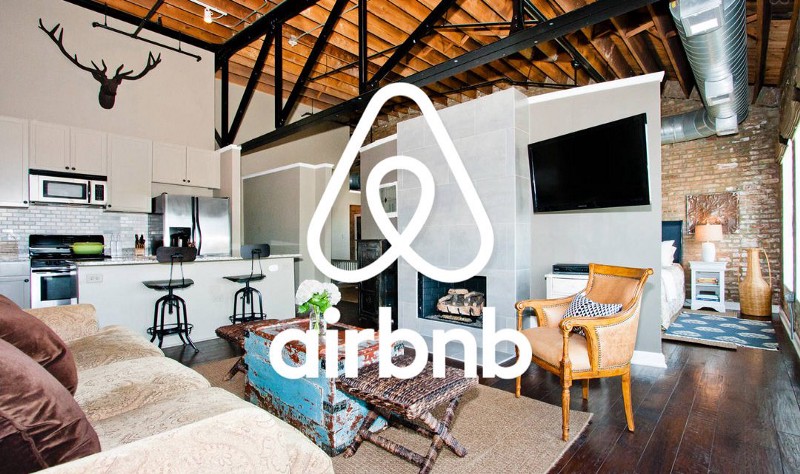
At the moment there are more than 700,000 options available in 34,000 cities around the world. The search engine will help you find the apartment in the certain part of the city or with certain services.
Before you book a room or apartment you can contact the owner, discuss every detail, observe the photos and research feedback from the previous clients. The service also allows you to make your own apartment available for rent to earn money. Everything can be controlled right from your smartphone or tablet.
An app that shows you which hotels are available nearby. It’s very helpful for the people who travel unexpectedly and don’t search for hotels in advance. It shows the prices, feedback and sales. Priceline also allows you to find car rental stations, buses and trains schedule and so on.
It’s an app that plans your trip and books flights and hotels. There’s the full information on when you arrive, leave and so on. It also offers you all the feedback and ratings available.

So, the travel mobile app opens up a variety of ways to make your business grow and get bigger. The companies that launch a successful mobile app and keep in touch with their audience in order to make the quality of their services better, have much more chances to succeed in the industry.
We sincerely hope that our article will be helpful for you if you’re looking to launch your own app or just learn something new about mobile travel apps. If you want to build your very own application, Octodev team will be happy to assist and guide you through the whole process.
This article was originally published on the Octodev Blog .
If this article was helpful, share it .
Learn to code for free. freeCodeCamp's open source curriculum has helped more than 40,000 people get jobs as developers. Get started
How to Build a Travel Website Like Expedia
What expedia is and why it’s time to open your own expedia-like website.
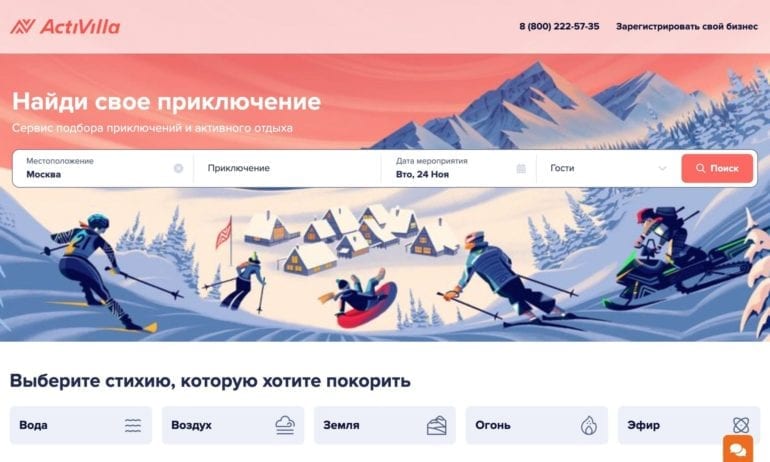
Activilla is an online marketplace from Russia offering experiences and outdoor activities. The marketplace is built on CS-Cart Multi-Vendor.
How to start a travel website like Expedia on CS-Cart Multi-Vendor?
- Multiple vendors. You just won’t be able to build an Expedia clone without this feature—it is the very basic function of your marketplace.
- Booking functionality. This function is also obligatory. You need your marketplace script to support booking.
- Multiple currencies and languages. Because a travel website is available worldwide and offers booking services in different countries, the site must be in several languages and customers need an opportunity to see prices and pay in their currency.
- Multiple storefronts. This one will come in handy if you want to open storefronts for every country on a unique domain name.
- Multiple payment options Your expedia marketplace software must have built-in payment gateways. At least the most popular—PayPal, Authorize.net, Apple Pay, Android Pay, eWay, FirstData, and others.
- Mobile application. A mobile app for iOS and Android will be a great advantage. Offer your customers the best way to book from their smartphones on the go.
Why CS-Cart Multi-Vendor is considered the best marketplace platform on the Internet?

Try CS-Cart Multivendor for free

How to Build a Successful Travel Business App?
The global tourism sector is projected to reach $2.29 trillion this year. In such a scenario, developing a robust travel app portal can lead businesses by storm.
Updated 17 January 2024

CTO at Appventurez
Tourism is a huge business sector that includes travel agencies, insurance companies, hotels, restaurants and so on. If you want to gain huge success in your travel business app like Expedia, you need a reliable travel app portal development solution.
With online travel, the market is backed by eCommerce, the travel booking & reservations trends have completely reshaped. As a result, a new buzzword is trending in the travel marketplace – travel portal development.
Every travel business is now looking for creating a successful travel portal app like Expedia. As per reports, the worldwide online travel market is projected to increase by 12% CAGR during the forecasting period (2017-2023).
The market has been growing exponentially with the growing demand for budget trips, hotel services, or review-based services, giving fame to travel portal apps like Booking.com, Priceline or Kayak. However, Expedia is one of the most popular travel portal apps.
Stats & Facts About Online Travel Businesses Like Expedia
Here are some surprising facts about online travel businesses like Expedia:
- Expedia, a popular OTA generated $8 billion in revenue in 2016
- In 2016, global online travel agency sales increased by $560 bn
- Overall, the gross booking of Expedia worldwide reached almost $108 billion in 2019
- Through OTA (Online Travel Agencies) like Expedia, global travelers make 148.3 million bookings annually
- 70% of all travelers look for online travel agency websites with the best deals on flights, hotels, and tours
- Around 75% of travelers prefer to use mobile apps to plan their trips
- About 80% of travelers agencies profit from brand exposure, income increase & other factors after an app launch
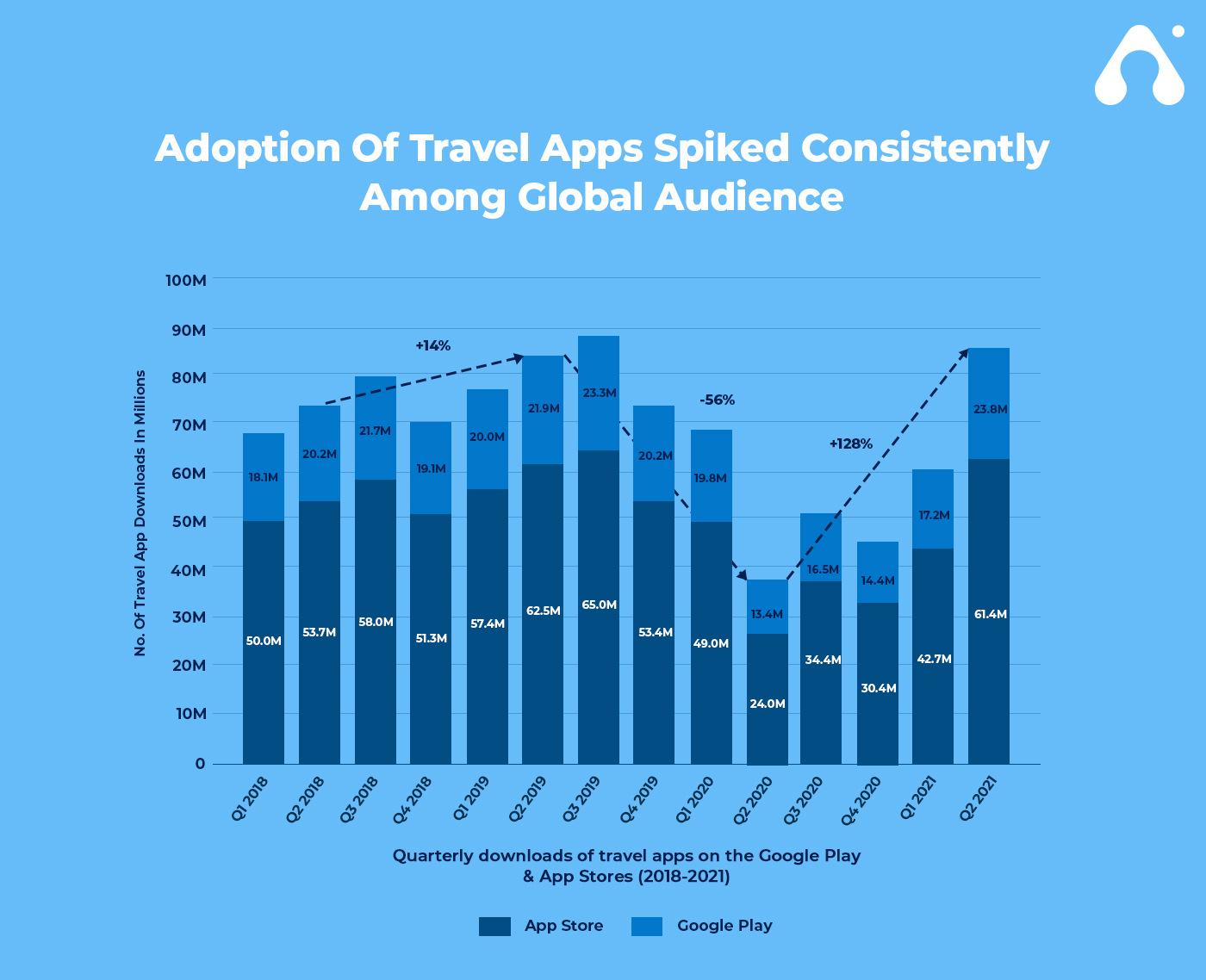
So, these are some stats about OTA like Expedia. If you want to make your online travel business app successful like Expedia, you need to learn about this travel portal app.
A Brief Introduction About Expedia
From planning to booking, Expedia, a travel portal app is designed to enhance your travel experience. Thanks to all the incredible features, it has become one of the most famous & profitable travel apps. This app allows you to book your hotels, flights & rental cars with the best deals.
Incredible Features of Expedia
- Flight Recommendations
- Itinerary Sharing
- Keep planning feature
Why Do You Need A Travel Business App Like Expedia?
According to the report of Opera Mediaworks, 85% of travelers book activities when on vacation through an app. On the other hand, 70% of millennials prefer to use mobile apps to research and book hotels before a trip. If you are still unsure, here are some convincing reasons for having a mobile app like Expedia for your travel business:
Every Necessary Information Under One Roof
Mobile apps provide you with the help you need to experience amazing trips. It leads you via managing & making processes even if you are not a programmer. This app manages web app content & keeps track of all records of a client’s interest. So, travel apps have an excellent CMS for maintaining the track record of the client’s history.
Powerful Marketing Tool
In the digital era, mobile marketing has become one of the main tools to enhance your business & visibility. For that, you can create rich content on travel ideas, resulting in greater customer loyalty.
Marketing Strategy
If you are planning for a reliable travel web app development solution , you should collaborate with transport & booking service providers. It increases the chances to empower business relationships that help in creating a unique marketing strategy.
Apps Reduce Paperwork
Travel brochures, tickets & booking papers require a big amount of money. With reliable on-demand mobile app development , you can reduce your labor & resource costs.
How To Gain Huge Success In Your Travel Business Like Expedia
Having knowledge about how much does it cost to develop an app like Airbnb and Expedia. But, if you want to experience an online travel business success like Expedia, you need to consider these features of Expedia like Android & iOS apps.
Triple Solution
Although 70% of tourism-related purchases are made via desktop, more than half of all searches users perform through their smartphones. So, it is important to create an OTP app that runs on Android, iOS & web platforms.
Online Reservation System
Additional services that every user expects in every OTA (online travel agency). Make sure you create an all-in-one platform like Expedia for adding flight booking engines & car rental services. This app generates extra income via sales & affiliate programs. You can also learn about how to develop a restaurant reservation app .
Hot Deals Generation Engine
Serve the best offers to your customers as per their travel history & interests. Hot deals generation engines automatically provide the best costs from hotels so you can sell them for a special price.
- Hot offerings
- Last minute deals
- Holiday packages
Incredible Features of Online B2C Travel Portal Development?
B2C travel portals incorporate several APIs such as flights, hotels, and real-time inventory. Online travel portal system includes several features such as:
Domestic/International Flight Booking
Travel apps are usually integrated with the flight reservation system’s Global Distribution System(GDS)through APIs. It will fetch air tickets’ online inventories and show that in the front end. In the end, it sends users directly to the payment integration system.
Car/Hotel/Bus Booking
The travel app has a booking engine that explores its searches for car/hotel/bus APIs in search of suitable deals at affordable rates.
Integrated Payment System
To rise above worldwide competition, an online payment system is a must. Online payment is usually made via a credit card or payment gateways like PayPal.

Essential MVP Features For Travel Business Apps Like Expedia
A Minimum Viable Product for startups helps you in collecting the initial customer reviews & improves the app. If you want to create an MVP for a tourism/travel portal like Expedia, you need to consider these features:
Trip Planner
From start to end dates to plane booking to hotel reservations, everything can be managed from the trip planner. This feature is your user’s planner for their trip. Make sure it is properly organized and easy to use.
Hotel Booking
Now, you users can find hotels of all price ranges in their desired location all thanks to the hotel booking app development feature. You just need to have tie-ups with the hotels. On top of that, you will need to have filters based on rooms per day cost, and type. Make sure it has a safe payment gateway option for secure & seamless booking.
Ticket Booking
The ticket booking feature allows your users to buy tickets to their destinations. What’s more, your users can select the date of travel, locations of seats & destinations as per their requirements. You need some good filters to make search focused and have safe payment gateway options. It will help users to book their tickets directly from your app.
Maps & Geolocation
After reaching their holiday destination, users can find spots of interest in the vicinity because of maps and geolocation features. There are several benefits of geo-location-based apps . In addition, this feature also helps in finding the hotel’s exact location at the right time.
There is no denying that Google Maps strives to make the best list of spots of interest possible. But, the fact is that it’s not better than locals when it comes to finding some cool local places. So, make sure your travel portal also allows users to hire local guides who have proper information about that location.
Push Notifications
As a powerful marketing tool, push notifications are used for sharing information with users without irritating them. You can share any information that your new travel package provides by using this feature. New customer acquisition, instant promotion, and consistent user engagement are some ways how push notifications value increases with intensity .
Review & Feedback
Whether it’s business owners or travelers, reviews & feedback are beneficial for both. Before purchasing a package, many customers have a look at its reviews and check others’ opinions regarding this. So, it’s essential to give your users that power. Apart from this, you can take these reviews as valuable inputs as they can aid in improving your solutions.
Social Media Integration
In today’s social media era, any app without social media platform integration is incomplete. So, make sure your users can share pictures, check in from multiple destinations, and do other such fun activities with your app.
So, these are some features you can use in your travel app to gain huge success like Expedia.
Travel portal app development is a great investment for business owners. So, ensure the price is never a hindrance to building a travel portal app like Expedia. For that, you should find a company such as Appventurez that understands the design concept and helps in the app testing process.
How Appventurez Helps In Travel Business App Development Like Expedia?
Appventurez, a leading travel app development company , has the expertise to elevate your travel business. With extensive experience in creating online travel agencies like Expedia, our expert team provides complete travel solutions. From web design and app development to API integration and maintenance, we offer comprehensive travel app development services. Whether you need a user-friendly mobile app or a robust web platform, we deliver top-notch solutions that prioritize user experience, performance, and security. Make your mark in the competitive travel industry with our seamless booking experiences.
We offer extensive app development solutions for all types & sizes of travel businesses, whether it’s B2B or B2C. Our professionals understand that your online travel portal is the face of your business. So, they listen to all your requirements carefully and create reliable, scalable B2B or B2C travel portals, resulting in increased ROIs. In addition, our fully-customized development solutions support easy app integration as per your business needs.
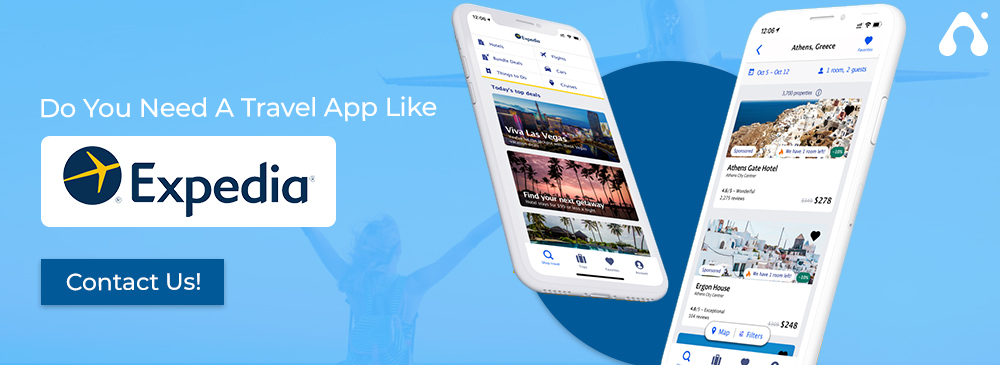
Q. How much does an Expedia-like app cost to develop?
The average budget for an Expedia-like app development relies on between $40 to $100 thousand. The price can differ as per the os platform, additional features and APIs. Starting with a web platform and then growing to other systems can save you around 15% of costs. If you already have some sort of website, you can create a mobile app on top of it. It may cost you 30% less than developing OTA from scratch.
Q. What are the five most popular travel apps?
Beat the traffic, avoid flight delays and find your favorite destination to stay on your next trip thanks to the travel portal app. Here are the five most popular travel apps: Expedia is a tried-and-true option for a frequent traveler Flighty is an iOS app for people who want to know the location and arrival time of their plane. Hopper is an Android & iOS travel portal app iExit app is an Android & iOS travel app for travel plans that involve a lot of driving. travel plans involve a lot of driving,
Q. How to set up a travel portal app like Expedia?
Here are some simple steps to follow when setting up a travel portal app like Expedia: Business planning is one of the most important parts of setting up an Expedia-like online travel agency. For that, you have proper knowledge of travel business, events, packages and discounts. After that, you need to understand how to establish your business presence in the market. It will help you understand your users’ existence. Make sure what kind of funding you want for your travel business. For that, you can get some investors in your company. Finally, look for a mobile app development company to create a travel portal app like Expedia.
CTO and Co-Founder at Appventurez, Sitaram Sharma has 10+ years of experience in providing world-class digital solutions. As a CTO, he brought his expertise ranging from product enhancements to advanced technological integrations, while focusing on the consistent growth of the team.
Posted : 14 December 2021

Key Steps to Build an Effective IT Modernization Strategy

How to Create a Social Media App – A Comprehensive Guide

The Ultimate Comparison: Android Vs iOS Development

How Web3 Technology is Transforming the Real Estate Industry?
Fill in the details and let us get back to you.
Our team looks forward to hearing from you and these details will help us to get back
Join the global innovators
Budget (select a range) Less than 10k USD 10k - 20k USD 20k - 50k USD 50k -100k USD More than 100k USD
Do you need an NDA first?
I agree to receive marketing communication from Appventurez.
For App development we’ve got you
General Inquiries : [email protected]
For Business Inquiries : [email protected]
- Mobile App Development
- Web App Development
- Mobile App Design
- CRM Software Development
- Mobile App Testing
- E-Governance
- Electric Vehicle
TECHNOLOGIES
- Artificial Intelligence
- Data Science
© Copyright 2018 – 2024 Appventurez. All Rights Reserved

- Knowledge Base
- Community Forum
- Customization
- Developer Docs
- Code Snippets
- Code Reference
- Hook Reference
How to Create a Travel Directory Website like Tripadvisor with WordPress for Free
A step-by-step tutorial on how to build your own Tripadvisor using WordPress.

Most travelers start their journeys by booking tickets, looking for accommodation, and searching for attractions, restaurants and other things online. That’s where travel directories come into play. They provide travelers with tons of trusted reviews and tips, helping people to travel with the wisdom of the crowd.
Recently it has become popular to create niche travel directory websites where people can share their tips and some “extraordinary traveling ideas” .
That’s why, in this short guide, we’ll show you how to create a travel directory with WordPress. We’ll walk you through the whole process of making your own website, starting from the theme installation and ending with the monetization options.
So, let’s dive in!
What Is a Travel Directory & How Does It Work?
A travel directory is a website that includes all the necessary information you may need when planning to travel to new places, from travel guides and tips to lists of good restaurants and hotels. It’s like a guestbook, a place where people record the highs and lows of their holiday experiences.
The most prominent travel directory is Tripadvisor . It’s a go-to website for travelers since it gives them information about accommodations, relevant prices, attractions, etc., straight from other travelers who have actually visited those places.
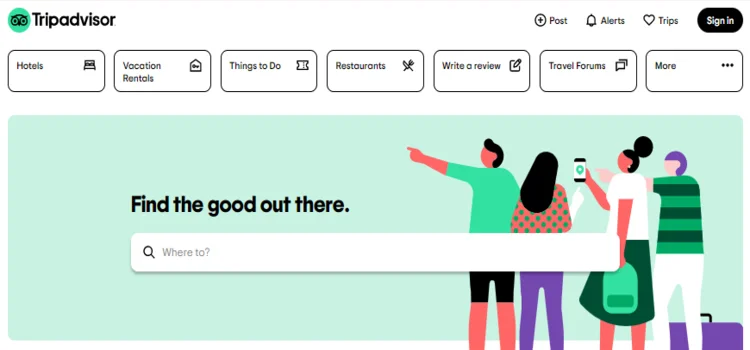
How Does Tripadvisor Work?
In a nutshell, Tripadvisor works as an intermediary between travelers around the globe. Anyone can check all the reviews and rates about places they are going to visit and share their own opinions after visiting them.
Additionally, Tripadvisor allows website visitors to check deals from its partners. For example, they can find car rental deals, cheap flights and accommodation available for booking. Users may click on any link to be taken directly to a partner website, knowing they have found the best deal.
Check our article on how to create a WordPress tour booking website .
How Much Does It Cost to Create a Website like Tripadvisor?
There are not so many factors that affect the average cost of building a WordPress website if you are doing it on your own. Generally, it only depends on the WordPress theme you will use (free or premium) and the hosting provider you prefer.
We’ll show you how to create a travel directory website with a free WordPress theme and an open-source WordPress plugin, so you’ll be able to kick-start your website for less than $30-100 (depending on your hosting plan) .
Steps to Build a Website like Tripadvisor
For the sake of this tutorial, we are going to use:
- ListingHive – the most popular free directory WordPress theme (8000+ active installations on WP.org) ;
- HivePress – a free multipurpose WordPress plugin suitable for building directory and listing websites of any type.
They are both lightweight, easy to use and intended to work hand in hand, so no compatibility issues occur.
Alright, now we can move to our first step – theme installation.
Check our comprehensive tutorial on how to build a WordPress directory website if you want to dive deeper and learn more about directory websites and how to build them.
#1 Install ListingHive
ListingHive is a free WordPress theme, so you can find it in the WordPress repository and install it directly from your dashboard. To do so, navigate to the WP Dashboard > Appearance > Themes page and click Add New . Next, find it via the search bar and proceed by installing the theme. Finally, click on the Activate button.
When the theme is activated, you’ll get a suggestion to install HivePress, the plugin that powers ListingHive directory features, so it’s essential to install it. Simply click on the recommended plugin’s link, and proceed by installing and activating HivePress.
Please follow the step-by-step screencast below if you have any troubles with installing ListingHive.
#2 Install Add-ons
Once you finish installing the theme and the HivePress plugin, it’s time to add some extra features to your travel directory in order to extend its core functionality. Navigate to the WP Dashboard > HivePress > Extensions section to check a list of the ListingHive extensions.
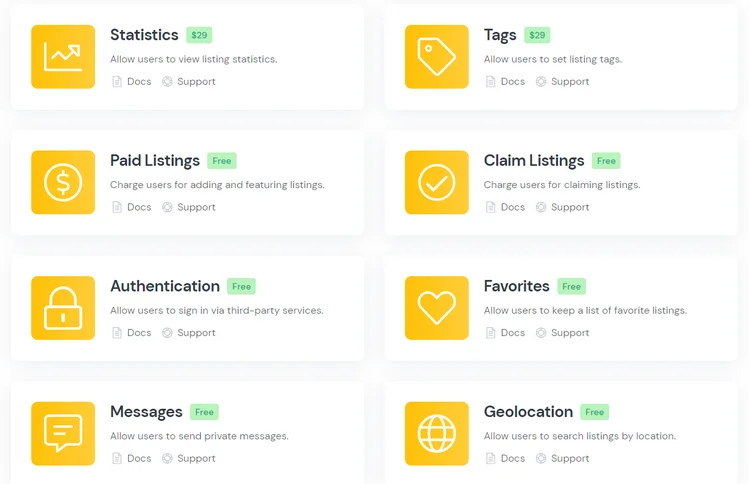
There are more than a dozen add-ons that you can install in a few clicks in order to extend your website functionality. Let’s examine some of them:
For example, you can install the Favorites extension to allow users to keep a list of favorite listings. It’s a convenient feature for users because once the listing is marked as a favorite, they won’t need to search for it again when returning to your website. Since travel planning often is a time-consuming process with a lot of options to choose from, the ability to keep a list of favorite listings becomes a helping hand.
Another great extension is Reviews. It allows users to rate and review listings. It’s a crucial feature for a travel directory since many tourists choose hotels, restaurants, attractions, etc., only after checking reviews of other travelers. Also, you can install the Messages extension to allow users to communicate on your website via messages.
Geolocation
One more essential feature for any travel directory website is a location-based search that allows users to specify their destination and show results only from the chosen area. You can easily enable this feature on your website with the Geolocation extension. Moreover, in order to make it easier for you, we’ve prepared a step-by-step guide on how to integrate Google Maps into your directory website so you don’t have to handle it on your own.
Social Login
Finally, if you want to improve the UX on your website, there is one more handy feature. You can install the Social Login extension to allow users to sign in via different third-party services (Google, Facebook) .
As you can see, there are a lot of options to enhance your travel directory website. We recommend checking the whole list of available add-ons to install only those you need on your website. Bear in mind that you can create a travel directory website with unique functionality by simply combining various extensions.
#3 Adding Directory Categories
The next step is to split your travel directory into categories depending on the types of listings you want to have on your website. For example, the main Tripadvisor categories include “Things to do”, “Hotels” and “Restaurants”. To add a new category, navigate to the WP Dashboard > Listings > Categories section.
First of all, you need to enter the category name, let it be “Things to do,” then fill in the description if necessary. Also, there’s an option to turn your category into a subcategory by setting a parent category for it. Finally, you can upload the category image. When finished, click on the Add Category button, so it appears on the front end.

Keep in mind that similarly, you can create as many categories as required for your website. Now let’s move on to the next step and try to add some fields specific to travel directory listings.
# 4 Adding Custom Listing Fields
You can add custom listing fields by going to the WP Dashboard > Listings > Attributes section and then clicking Add New . For example, let’s add the “Price” attribute, so users will be able to set the price range when they are looking for some events nearby. Once you enter the attribute title, you need to go through each section to set up the attribute. Let’s briefly cover them:
Editing section
In this section, you can customize the main attributes settings – select its field type, allow users to edit it and enable moderation if necessary. For the “Price” attribute, select the “Number” field type and allow front-end editing so users will be able to specify the price when adding a new listing.
Search section
Within this section, you can set up a search filter for your attribute. For example, it’s better to mark it as filterable and sortable – in that way, users will be able to search and sort listings by this attribute. Then you need to select the search field type for your attribute. We recommend selecting the “Number Range” field type so visitors can set a price range according to their budget instead of searching by specific price.
Display section
In the last section, you can define how the attribute value appears on the listing pages by setting its display format. For example, you can use the $%value% format, but if you need a different currency, it’s not an issue – simply change the symbol, and that’s it.
Finally, you can make any attribute category-specific so it will be used only for the listings from that category. Once you are done with setting up the attribute, click on the Publish button.

Likewise, you can add many different custom fields and search filters. There are no limits, so you can create as many as you need for your travel directory website. Alright, now it’s time to add a new listing, so let’s move to the next step.
# 5 Add Listings
Let’s add the first listing to the “Things to do” category but do it from the front-end to get a better understanding of how it’s gonna work for users. To do this, go to your website, click on the Add Listing button, and select the “Things to do” category.
Now you need to fill in the submission form. You can upload the listing image, enter the listing title, let it be “City walking tour,” fill in the description, set the price (our recently added field) and submit the form.
Keep in mind that as a website owner, you can customize the submission form in the way you like by adding or removing different fields as well as making them optional or required.
Finally, in order to make the listing visible on the front-end admin has to approve it in the WordPress dashboard. Simply navigate to the Listings section, locate the pending listing and approve it. If you don’t want to approve each listing manually, you can disable moderation in the WP Dashboard > HivePress > Settings > Listings > Submission section.
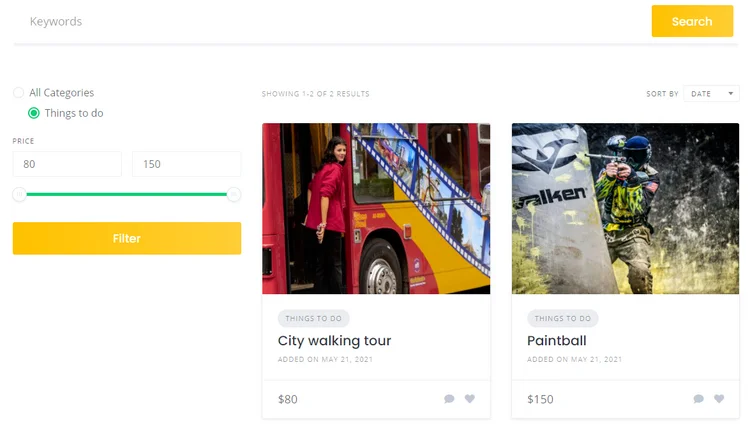
#6 Setting Up the Front Page
Your next step is setting up a front page for your travel directory website. Since HivePress is integrated with Gutenberg and Elementor page builders, it won’t be an issue for you to customize new layouts with blocks.
In order to add a new page, go to the WP Dashboard > Pages section and click on the Add New button. Firstly, enter the page title. Then try adding some layout blocks. For example, you can add the listing search form so travelers can search for tourist attractions by keywords via the search bar on the homepage. Simply click on the ➕ icon and select a block you want to add. Similarly, you can add a block that displays listing categories. When you finish setting up the front page, you can publish it.
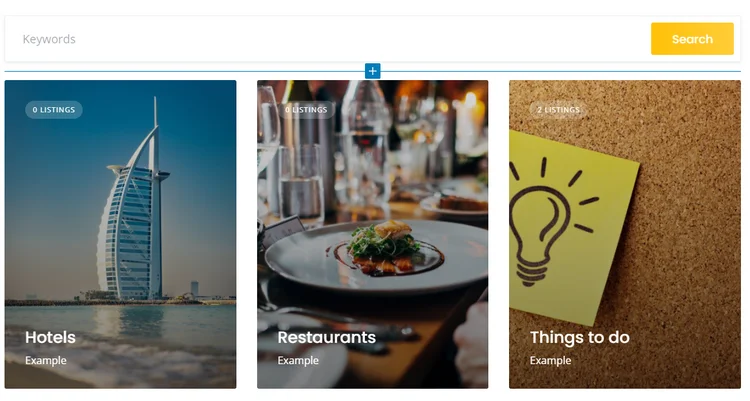
Now you need to make this newly-created page the front page of your website. To do this, go to the WP Dashboard > Settings > Reading section and pick this page in the drop-down menu, then save changes. Additionally, if you want to make your travel directory website truly unique and exceptional, we recommend visiting the WP Dashboard > Appearance > Customize section and going through all the settings there. Play around a bit with customization options to find a perfect look and feel for your website.
How to Monetize a Travel Directory
Finally, let’s talk about the available monetization options. With the ListingHive theme, you can monetize your travel directory in several different ways and let’s examine each of them:
- Charge business owners for claiming their listings . It’s the most widely used monetization model for travel directory websites. Claiming listings is the model Google Business, Yelp, Tripadvisor, and some other big directory sites follow. It’s not only a monetization model, but it’s also a great way to keep your website up to date. Business owners will ensure that they have their listings with the relevant and newest information that may be useful for potential customers.
- Feature listings for an additional fee . You can easily monetize your travel directory by promoting certain listings. Once you mark any listing as featured, it will be automatically highlighted and displayed at the top of search results. It may be a great way of making money since many business owners will pay for the possibility to stand out from hundreds of other listings.
- Sell advertising space . It’s the most common monetization model for most websites. Selling ad space to businesses, or joining the Google AdSense scheme, are both options that will help increase your revenue. But be careful with displaying too many ads on your website since it may be annoying to your users.
As you can see, there are several ways of monetizing your directory website . You can choose any model for your website or use them all at once. Everything depends on your travel directory website niche and requirements.
Wrapping Up
That’s it! Now you know how to create a travel directory website like Tripadvisor with WordPress without a single line of code. Running your own website is not an easy deal, and it requires a lot of effort to attract first visitors. However, where there’s a will, there’s a way, so just be patient and keep going with your website, and sooner or later, it will pay off to you.
Finally, keep in mind that one of the easiest ways to build a travel directory website with WordPress is by using the ListingHive theme and the HivePress plugin that go with all the necessary features right out of the box. So you can enjoy creating your website with greater ease and comfort.
By the way, you can check how HivePress and ListingHive stack up against other directory plugins and free directory themes in our comparison articles.
Related Articles

Increase User Engagement on WordPress Directory Website
Increase user engagement on your website with search alerts.

How to Create a Job Board with WordPress
Build your own job portal website without any coding skills, using WordPress.

How to Create a WordPress Member Directory for Free
Build a searchable member directory website using WordPress.
Get notified about new HivePress themes & extensions

Home » Online Shopping » Flights / Hotels » Best 9 Sites Like Expedia
Best 9 Sites Like Expedia for Getting Deals on Booking Travel

Expedia may be one of the best sites for booking travel, but booking websites are competitive for a reason; it seems there’s always a place to find a better deal. If booking travel accommodations with Expedia leads to more jet lag than enjoyment, here are 9 other popular sites like Expedia for you to try.
Just a heads-up that some of the services we’re reviewing here have affiliate partnerships with us, so we may earn a commission if you visit one of them and buy something. You can read more about how this works at https://techboomers.com/how-to-support-techboomers .
1. Priceline

( www.priceline.com )
Priceline one of Expedia’s competitors that is as famous for having celebrity spokespeople (notably Star Trek actor William Shatner) as it is for its uniqueness as an Expedia alternative. Sometimes called “the eBay of travel booking websites,” Priceline allows users to bid on some travel accommodation bookings, which may result in even deeper discounts than usual. Also, its signature “Name Your Own Price” program allows you to book travel accommodations based on how much you’re willing to pay for them. Be careful, though… since accommodation companies don’t want to be seen advertising below-retail rates, you won’t be able to see some details of your accommodations until after you book them if you use “Name Your Own Price.”
Be sure to check out our free course on how to use Priceline if you want to learn more information.

( www.orbitz.com )
Orbitz is a site that is very similar to Expedia, in that it allows for the booking of travel accommodations such as airline flights, hotels, car rentals, cruises, and vacation packages. Like Expedia, Orbitz has a rewards program that earns you “Orbucks” (on-site currency), which you can then use towards the price of hotel bookings. Orbitz also has a price guarantee system, so if you find a better price on the same accommodation elsewhere, tell Orbitz and they’ll give you Orbucks equal to the difference in prices, plus a little extra! Orbitz is also notable for having relatively good customer service, despite being part of an industry that is often maligned for its lack of support in this area.

( www.flipkey.com )
FlipKey, associated with TripAdvisor, is a website where you can rent properties from owners, meaning you book directly with the person who owns the property. Using this method of booking, you can typically save a lot of money over the traditional method of booking with hotels. FlipKey has over 30, 000 property listings in 1100 cities worldwide – so there’s definitely something for every travel need. They even offer 5000 booking deals per day, so you can save some money with your bookings.
FlipKey also takes security very seriously compared to other property booking websites, as they make an effort to verify the identity of every property owner. The FlipKey staff takes extra steps to ensure there is no fraud taking place, so you aren’t taking risks while choosing a property, and can book with confidence.

( www.hotwire.com )
If you aren’t a very picky traveller and just want to save as much money on your travel accommodations as possible, then try Hotwire. This is one of the websites like Expedia that many travel companies turn to when they are trying to sell off their bookings at any price to avoid taking a total loss. This means that you can get accommodations for extremely low prices, but the catch is that you won’t know some of the details of what you book until after you’re finished, and you can’t cancel your booking. This means that you may have to do a little more research and forward planning than usual if you’re going to use Hotwire. Or you just have to be lucky, or — as we said — not a nitpicker when it comes to travel.

5. Booking.com

( www.booking.com )
Booking.com is an Expedia competitor that has become rather popular lately. While it only focuses on hotel bookings (and not flights, car rentals, or cruises), it has a much larger selection of them, partnered with over 650,000 properties worldwide. It offers its interface in over 41 languages, no booking fees on accommodations that you reserve, easy-to-use self-serve customer service for changing booking details, and free cancellation on most rooms. In addition, if you create an account on Booking.com and subscribe to their newsletters, you may be able to find even better deals! Booking.com also allows you to book non-hotel properties for rent, such as apartments, villas, bed & breakfasts, and more through its main site as well as its sister site, Villas.com.

6. Hotels.com

( www.hotels.com )
As you may have guessed from the name, Hotels.com focusses on finding you hotels in cities all over the world. If you don’t need the big vacation package, but just want a deal on a stay in a hotel, then Hotels.com is right for you. Hotels.com also has a rewards program that offers its users additional discounts and deals, as well as giving one free nights stay in a hotel for every ten nights you book with Hotels.com.

( www.trivago.com )
Another alternative to Expedia, Trivago aims to show its users the lowest prices for travel, but they do it by compiling the offers from all of the major booking websites. Trivago compares the prices from these sites, even if they aren’t the lowest, in case you can find a price that’s close with a website you are familiar with and like to use. You can easily filter every minute aspect of your search, so if you don’t want to look through all the sites for the best deals, you can use Trivago to compile them, and then sort through.

8. TripAdvisor

( www.tripadvisor.com )
TripAdvisor is another one of the great alternatives to Expedia, though it began as a review website where you could search for accommodations you were interested in booking, and research everything about them. The reviews are provided by people who have actually stayed at the venues, and includes information such as when they stayed and for how long, which rooms they stayed in, who they travelled with, what activities they did, and much more. They rate every aspect of their stay, and leave free-form comments, so you know exactly what it’s like at a place – before you spend the money.
Now TripAdvisor has grown into a booking website in its own sense, and partners with many other travel websites (including ones in this article!) to help find you great deals on places you’re interested in. Once you’ve done all your research on TripAdvisor, you can also check out which of the popular booking sites currently has the lowest prices, and book right on TripAdvisor. And if you want to learn more, be sure to give our free course on how to use TripAdvisor a read.

Have you booked travel accommodations with any of these Expedia competitors? Was it smooth sailing, or did you get stuck in layover limbo? Are there any other travel booking websites that you’ve used that you would recommend to our followers? Give us the details by leaving a comment below, or posting a message on our Facebook or Twitter pages!
More Great Related Articles

Best 6 Sites Like Care.com for Finding Caregivers

Best 5 Sites Like Gmail for Email

Best 9 Crowdfunding Sites to Raise Money This Fall

Best Travel Apps Guide: Make Plans, Book Flights, and Find Deals

IMAGES
VIDEO
COMMENTS
Beyond a great business opportunity, the benefits of starting an Expedia clone include: Huge market size and demand. Massive selection of deals and listings. Recurring revenue from bookings. The ...
Launching a platform such as Expedia from scratch involves a significant investment, both in terms of time and finances. The costs can range widely, starting from $100,000 to over $1 million, depending on the complexity, features, and scale you aim for. This estimate includes expenses for research, design, development, testing, marketing, and ...
Learn how to create a travel booking site on your own with WordPress, a domain name, hosting, and a theme. Follow the five steps to customize your site with a stunning design, a complete booking system, and a marketing plan. Get tips on how to find a domain name, choose a theme, add content, and launch your site.
Step 1: Choose a Niche (Start with a Defined Niche, Then Work Broad) In order to build your website, you need to know your direction and vision. If you can become an authority on a sub-topic of travel, you can then use that to build outwards on the general topic of travel.
Design Best Practices. Keep these principles in mind when crafting your homepage: Visual Hierarchy: Use size, color, and spacing to guide the eye toward the most important elements. Mobile Responsiveness: Prioritize design that seamlessly adapts to various screen sizes, providing a smooth experience for all visitors.
Also, create blocked-out slots for unavailable options. A calendar built into a travel website is more user-friendly than the need to jump between pages. Let users see the upcoming months' options so they can compare tour prices. By making multiple choices visible, you provide the "best value for money" principle.
Follow the following six easy steps to create a website like Expedia: 1. Select a platform for your travel site. Don't go for a random platform. There are lots of CMS (Content Management System) available. But, some can be good for your site and some might look good but that can cause harm in the future.
Learn what a travel aggregator website is, how it works, and how to build one like Expedia. Find out the best practices, tools, and examples of travel aggregator websites. Compare different methods of building a travel website from scratch, with WordPress, or with travel engines.
If you'd like to add additional support for hotels, rental cars, and tours, you can easily replicate the core framework to cater to your specific needs. The steps to building Expedia with no code include: Get Started. Register your account on Bubble. Configuring your database. Building workflows.
Here is a rough plan of how to build a travel website from scratch. Step 1. Choose The Niche. The niche defines the type, features, and technologies for the future website. For example, there are online tour operators, hotel or ticket booking services, travel blogs, and much more.
Step 1 - Create a website plan. Budget accordingly and purchase your domain and hosting if required. Register your name at any registrar like GoDaddy. Step 2 - Design your web page. While determining the design of your site, you can use ThemeForest to gain inspiration and ideas with thousands of pre-made themes. Step 3 - Build your ...
This is definitely not something that you should skimp money on. You must invest in high quality media content that can truly impress your potential customers. Do not use stock photos. Do not use low quality photos (even with instagram, try to use a good phone to take the photos, phones are so cheap now).
Customize your website according to the features and functionalities required for your brand. Market and start publishing your content. When building a website like expedia, there will be tons of features and functionalities. The only thing you have to do is generate website traffic when your development process is complete.
The various elements necessary for a travel company website will change depending upon the company and the business model. For instance, a small travel blogger may focus on the web content and visual elements of their own traveling, whereas a massive tourism conglomerate may put more emphasis on the online store and booking aspects of the site, similar to a travel agent.
TripAdvisor is now one of the biggest travel-related websites. It generates $902 million in annual revenue (most of it from advertising). The platform, which employs over 2,500 people, offers reviews on almost 9 million accommodations, restaurants, experiences, airlines, and cruises. Source: TripAdvisor, Statista.
Priceline. An app that shows you which hotels are available nearby. It's very helpful for the people who travel unexpectedly and don't search for hotels in advance. It shows the prices, feedback and sales. Priceline also allows you to find car rental stations, buses and trains schedule and so on.
To launch an Expedia-like website, you need a software base that supports multiple vendors. As we mentioned before, all Expedia alternatives are simply online marketplaces, that's why you should search for a reliable virtual mall solution. When looking for one, make sure it supports these features at least:
If you want to gain huge success in your travel business app like Expedia, you need a reliable travel app portal development solution. With online travel, the market is backed by eCommerce, the travel booking & reservations trends have completely reshaped. As a result, a new buzzword is trending in the travel marketplace - travel portal ...
To add a new category, navigate to the WP Dashboard > Listings > Categories section. First of all, you need to enter the category name, let it be "Things to do," then fill in the description if necessary. Also, there's an option to turn your category into a subcategory by setting a parent category for it.
4. Kiwi.com - Most Innovative. Uses a comprehensive meta-search algorithm to search the internet for the best flights, trains, buses, and other ways to get around. Kiwi is a good choice for travelers who want to visit more than one city and save money and those who want to travel by plane, train, or car.
Tips To Develop a Successful Travel App. Here are some simple but easy-to-follow tips that will make your travel app deliver impeccable business results: 1. Build a Travel App with Top-Notch UI/UX. Users should be able to login and book hotel rooms and travel tickets within seconds.
How to Build a Travel App Like Expedia. The tourism sector is diverse, and travelers have a wide variety of potential routes and destinations to choose from. People will always look for the easiest way to get where they want to go, whether they are going on a business trip, a vacation, or just to see someone they care about.
7. Trivago. ( www.trivago.com) Another alternative to Expedia, Trivago aims to show its users the lowest prices for travel, but they do it by compiling the offers from all of the major booking websites. Trivago compares the prices from these sites, even if they aren't the lowest, in case you can find a price that's close with a website you ...